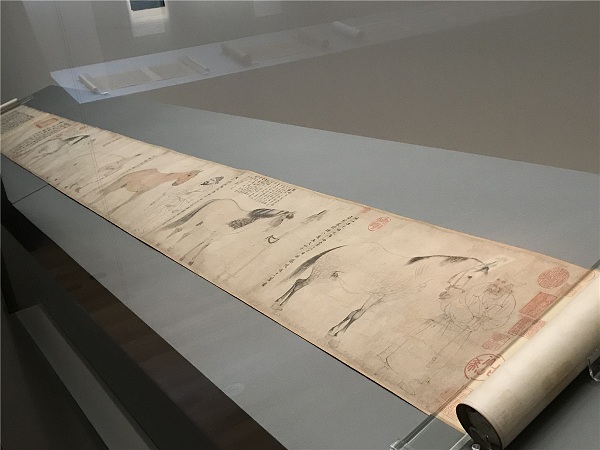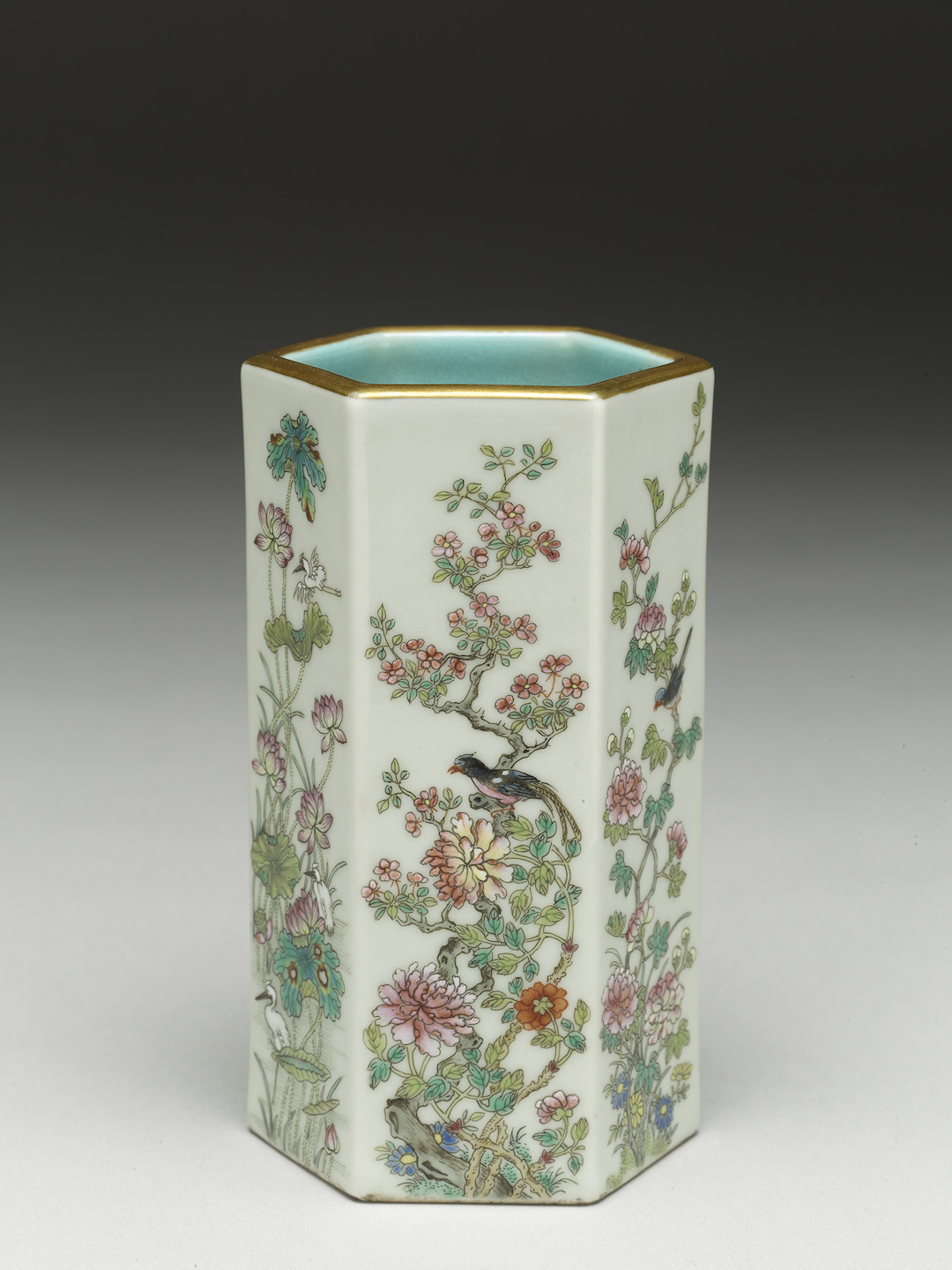
The Paper has learned that the National Palace Museum in Taipei recently launched the special exhibition "The Emperor's Mobile Garden: Court Flower Paintings of the Qing Dynasty". The exhibition is divided into 5 categories: "Enjoyment in the Years", "Inspection Beyond the Great Wall", "Textual Research on Flower Genealogy", "Yigan Forbidden Garden" and "Ephemeral Flower in the Pan" 5 Each unit displays 54 Qing Dynasty palace flower paintings and related exhibits. The flower paintings left by the Qing Dynasty court are not only visual records of transplanted flowers, but also mobile gardens that can be opened or hung for appreciation at any time regardless of season or region. The exhibition lasts until September 22.
The territory of the Qing Dynasty spanned temperate, subtropical and tropical zones, so the flora and fauna that were brought to the court as tribute were richer and more diverse. The Qing emperor's interest in flowers led court painters to depict not only Jiangnan flowers, but also high-altitude wild plants and even foreign flowers introduced from as far away as the West. The exotic flowers and plants from all over the world in the paintings allow us to imagine the colorful scenes of palace gardens at that time.
Flowers may only bloom temporarily, but through the use of pen and ink, their beauty and vitality can be sustained forever. The flower paintings left by the palace are not only visual records of transplanted flowers, but also mobile gardens that can be opened or hung at any time regardless of season or region.
Peace of mind at all times - the ideal palace garden
The palace garden was a leisure place for emperors and members of the royal family. There were corresponding flower viewing activities in different seasons, allowing people to feel the changes of the seasons from the prosperity and decline of flowers.
The gorgeous palace garden in the painting shows the flower arrangement techniques and entertainment activities of the time. Flowers that bloom according to the time sequence represent a stable climate and are the epitome of good weather and peace in the world, reflecting the ideal garden in the emperor's mind.

"Spring Dawn in the Han Palace" (detail)

"Spring Dawn in the Han Palace" (detail)
"The Picture of the Twelve Months" takes the twelve months of the lunar calendar as its theme, and its composition is similar to the "Picture of Emperor Yongzheng's Recreation in the Twelve Months" (collected by the Palace Museum). It was originally a depiction of the merry life of Emperor Yongzheng (1678-1735) and his queen wearing Han costumes. The painting incorporates folk customs and activities during the year, which has the meaning of having fun with the people. The "December Order Picture" of the Qianlong Dynasty changed Emperor Yongzheng into the image of an ordinary scholar.
In ancient times, because of the "difference between men and women," women had to avoid men's activities, and the same was true for "Twelve Months Order Picture". But no matter where it is restricted, flower viewing is an activity that transcends gender and can heal the body and mind. Through literature and painting, flowers have gradually become the objects on which people place their emotions.
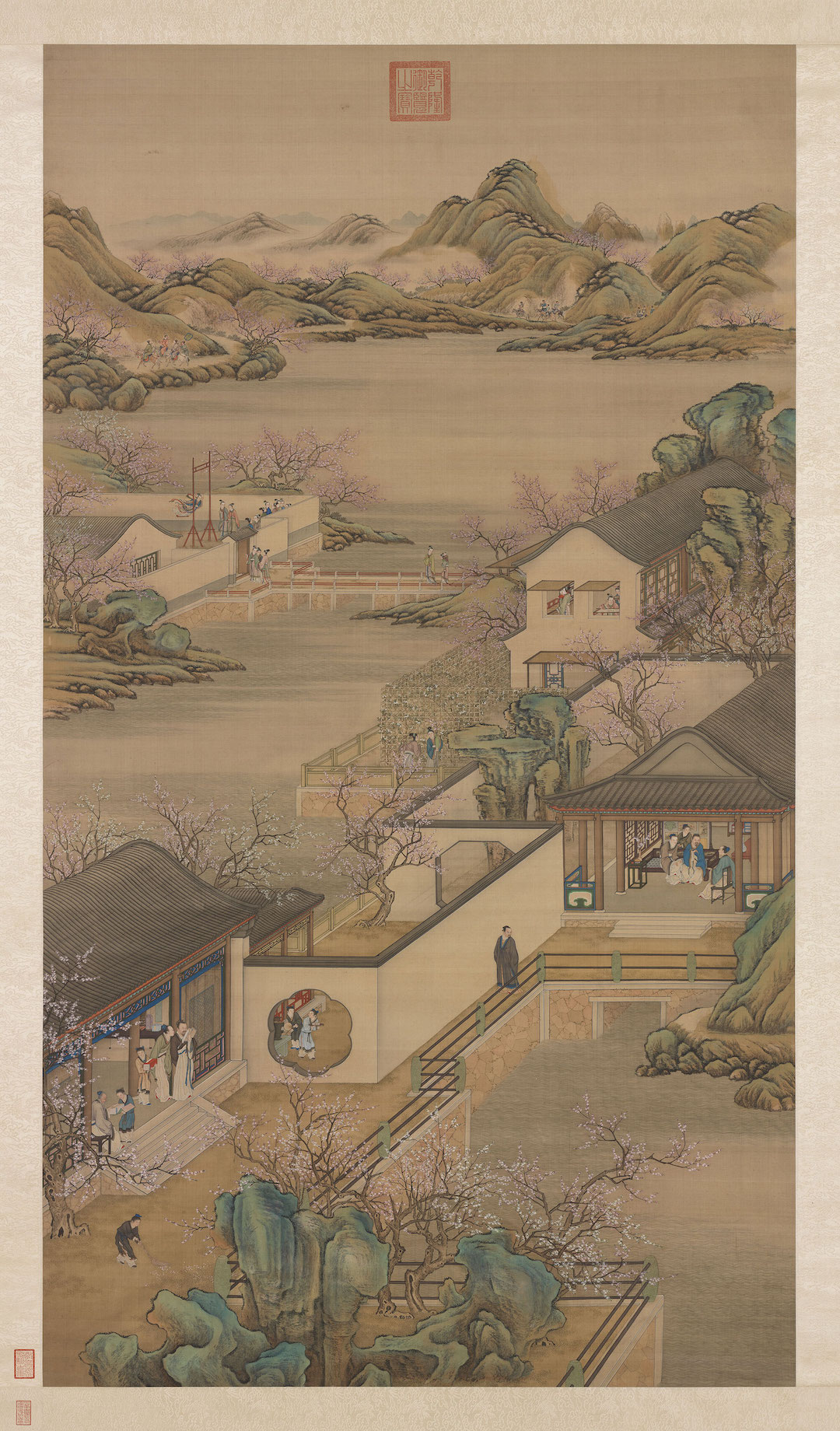
Qing Dynasty Painting Academy Painting "December Order Picture" National Treasure on Silk in February
"February" depicts a garden with apricot blossoms in full bloom. In the foreground, there are servants cleaning fallen flowers or boiling water for tea, while literati are holding books and reading, or sitting and chatting with each other. This should depict the scene where literati gathered to recite poems during the "Flower Festival" on the 15th day of the second lunar month. In the middle shot, a lady enters the house holding a newly arranged vase of flowers. The woman inside the house is doing embroidery and taking care of the children. In the courtyard not far away, there are women gathering in line to play on the swings. In the distant view, there are officials riding horses for a spring outing, and hunters holding hawks and bows and arrows preparing to hunt, hinting at the arrival of spring.
The composition of the painting is influenced by Western linear perspective, and the proportions of the front and rear are quite different. The moving lines of the characters are arranged to form a zigzag shape, which can guide the audience to view the details in the painting from bottom to top, left and right.
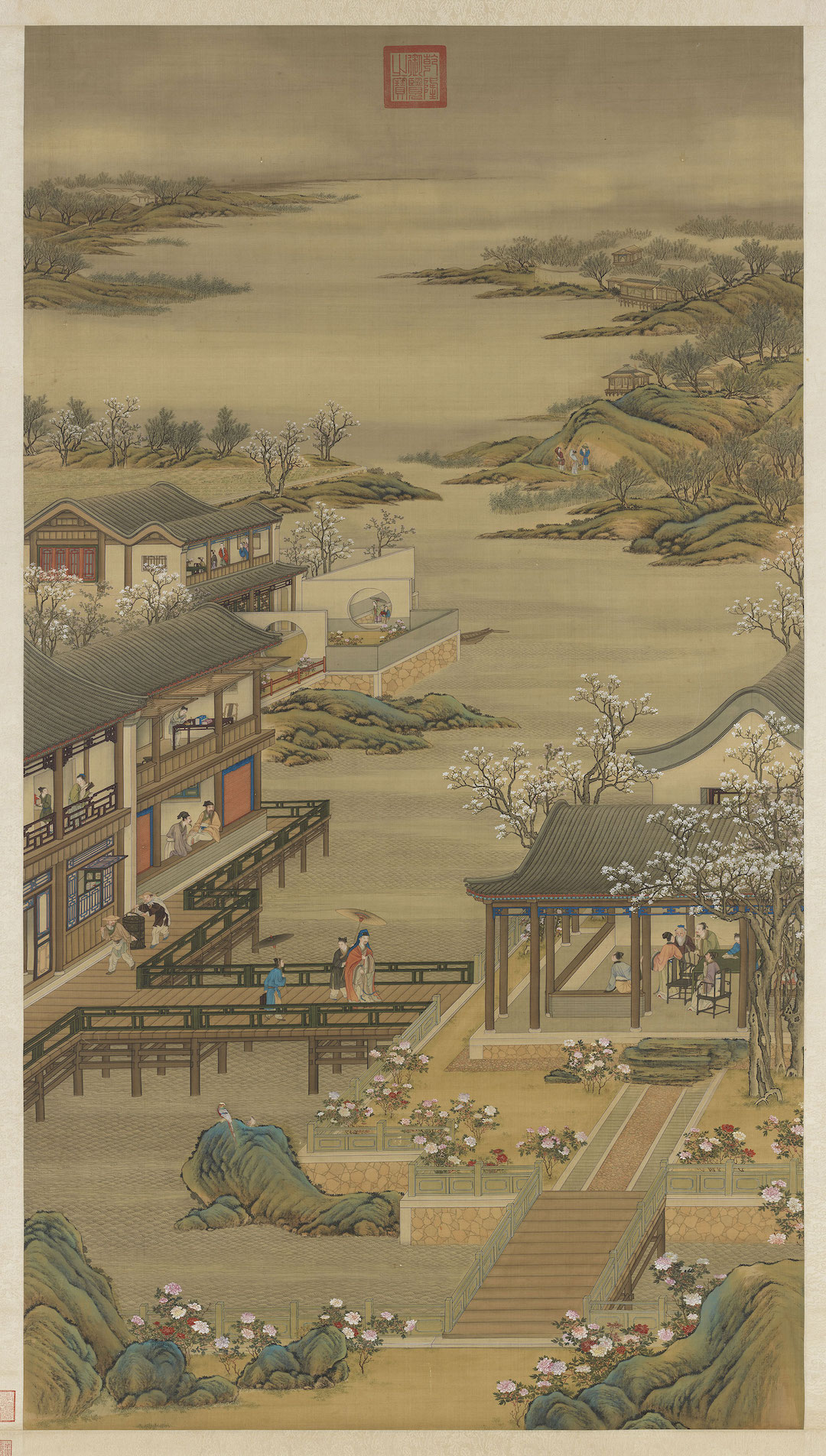
Qing Painting Academy Painting "December Order Picture" April
The garden in the painting "April" is blooming with peonies and magnolias of various colors. The sky in the distance is dark and cloudy. The women picking mulberry outdoors used their sleeves or rattan baskets to protect themselves from the rain, while the other men and women held umbrellas and wore bamboo hats, indicating that it was a rainy day. Men and women indoors are enjoying flower viewing activities. There are literati and elegant people gathered in the front hall, waiting for the male host on the bridge to join. There is a vase of peonies in the attic of the rear residence, where the female family members gather to chat.
Emperor Qianlong (1711-1799) once wrote a poem to record the conditions in the fourth lunar month, praising the rain for boosting crops. Therefore, the painting depicts a rainy scene and also has a metaphor of hoping for a good harvest. The peonies, magnolias and halls in the painting can also form the auspicious meaning of "wealth in the jade hall".

Qing Dynasty Painting Academy Painting "December Order Picture" June Silk National Treasure
There is a vast pond on the upper right side of the "June" painting, showing a scene of lotus flowers in bloom in summer. In the front yard on the lower left, there are servants moving books to the long table, echoing the "Book Exposure Festival" on June 6 of the lunar calendar, where books that have become damp after the rainy season are dried in the sun. The fence and flower tent in the middle is the dividing line between the inside and outside house. There is a lady holding a lotus pod high to tease the baby upstairs. The host and hostess in the pavilion are holding fans to cool off. It is a rare scene where men and women are in the same room together.
The lotus pond is a recreational space for women. You can take a boat to pick lotus flowers, or take a yacht to cruise the lake and enjoy the scenery. In the distant view, there are literati enjoying the cool air and enjoying lotus flowers, as if they are waiting for the arrival of guests from afar, which seems quite comfortable.
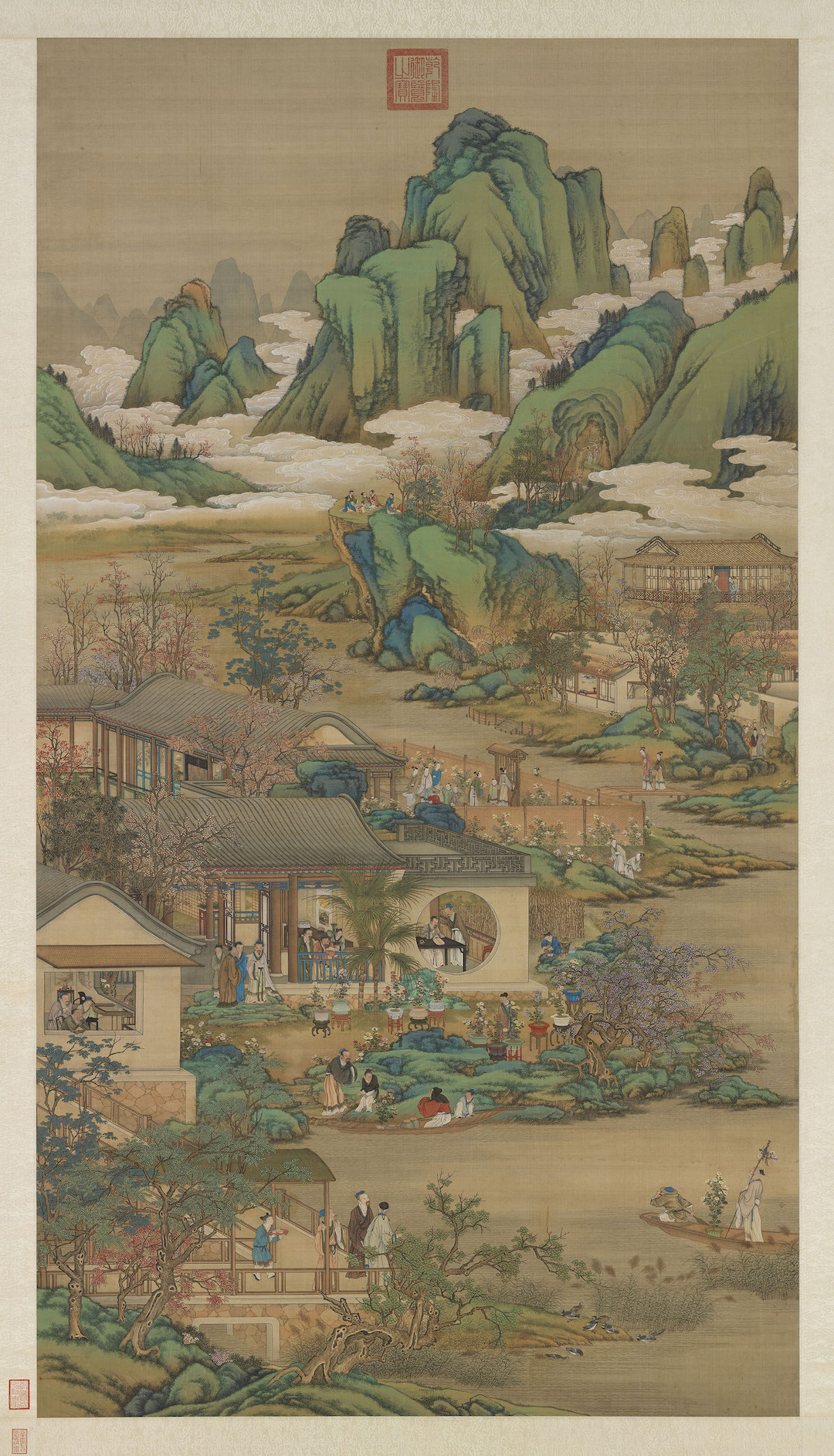
Qing Dynasty Painting Academy Painting "December Order Picture" September Silk National Treasure
The foreground of "September" depicts a courtyard by the water's edge. The courtyard is filled with various chrysanthemum bonsais, and a chrysanthemum-themed gathering is underway. The literati in the house were busy reading and writing inscriptions, and there were also elders who took boats carrying more chrysanthemum pots to join the event. The female relatives in the backyard also took their children to enjoy the flowers, showing a scene where everyone, regardless of gender, old or young, was enjoying the flower viewing activities.
The mountain scenery in the distance shows both scholars climbing the mountain with poles and tourists picnicking on the ground. This depicts the custom of appreciating chrysanthemums and climbing high during the Double Ninth Festival on September 9th of the lunar calendar.

Qing Dynasty Painting Academy Painting "December Order Picture" National Treasure on Silk in December
"December" paints winter snow scenes. There are "Three Friends of Suihan" composed of ancient pine, bamboo and old plum trees at the door. In the open space of the courtyard, children play shuttlecocks or build snow lions, which are common activities in folk "cold relief parties". There are literati indoors chatting around the fire. There are dozens of sika deer and white deer in the backyard, symbolizing "good luck". In the distance is the frozen water, depicting people dragging the ice bed across the river in various ways. The garden in the painting has Western-style buildings, showing the architectural fashion of the time.
It snows in the twelfth month of the lunar calendar, and the melting snow the next year will provide enough water to nourish the growth of animals and plants, so it also has the meaning of "auspicious snow is a sign of good years". In addition to the plum blossoms blooming in the courtyard, there are also vases composed of wax plums and southern geraniums indoors, highlighting that flower viewing is an activity regardless of season.
Inspection outside the Great Wall - the emperor's tour guide went on a tour
Emperor Kangxi (Aixinjueluo Xuanye, 1654-1722) was a Manchu emperor with a spirit of exploration and investigation. He led Han poets to the north of the Great Wall many times and personally guided them to compare the differences in climate and animal and plant ecology between the north and the south. He hoped to compile the findings into official books and form a new knowledge system belonging to the Qing Empire.
Ci officials traveled with the emperor, not only admiring the scenery they saw along the way, but also leaving graphic and textual records of first-hand observations. Wild flowers, which were originally relatively unnoticed due to geographical restrictions, became travel memories of the emperor and his ministers, and thus became new themes for the Qing court's calligraphy and painting creations.
Cold-resistant and bright flowers outside the Great Wall
Flowers outside the Great Wall grow in high-altitude areas with a colder northern climate. Because they absorb more ultraviolet rays, their colors are more vivid. The sketches left by the painter following the emperor's travels not only clearly depict flowers, leaves, stems and other parts, but also try to paint flowers in rich colors. When the emperor composed poems about things, he personified the cold-resistant characteristics of flowers outside the Great Wall and became a symbol of noble conduct.

"Wild Chrysanthemum" by Jiang Tingxi, Qing Dynasty, paper
Jiang Tingxi's "Wild Chrysanthemum" depicts the broken branches of purple chrysanthemums. Above it is a poem written by Emperor Kangxi (1654-1722) titled "Yiyou Mountain Villa Occasionally Formed in Autumn", written in the autumn of the 44th year of Kangxi's reign (1705). The flowers in the painting should be the wild chrysanthemums outside the northern Great Wall described in the poem, presumably "aster". "Guangqun Fangpu" records that aster was produced in Inner Mongolia during the Yuan Dynasty, and was commonly grown north of the Great Wall during the Qing Dynasty.
This painting mainly uses the boneless technique, which does not emphasize the outline of ink lines and directly depicts objects with color. The flowers in the painting are slightly messy, and some of them are even facing away from the painting, as if they were squashed. It is speculated that they may be faithfully depicting collected flower specimens.
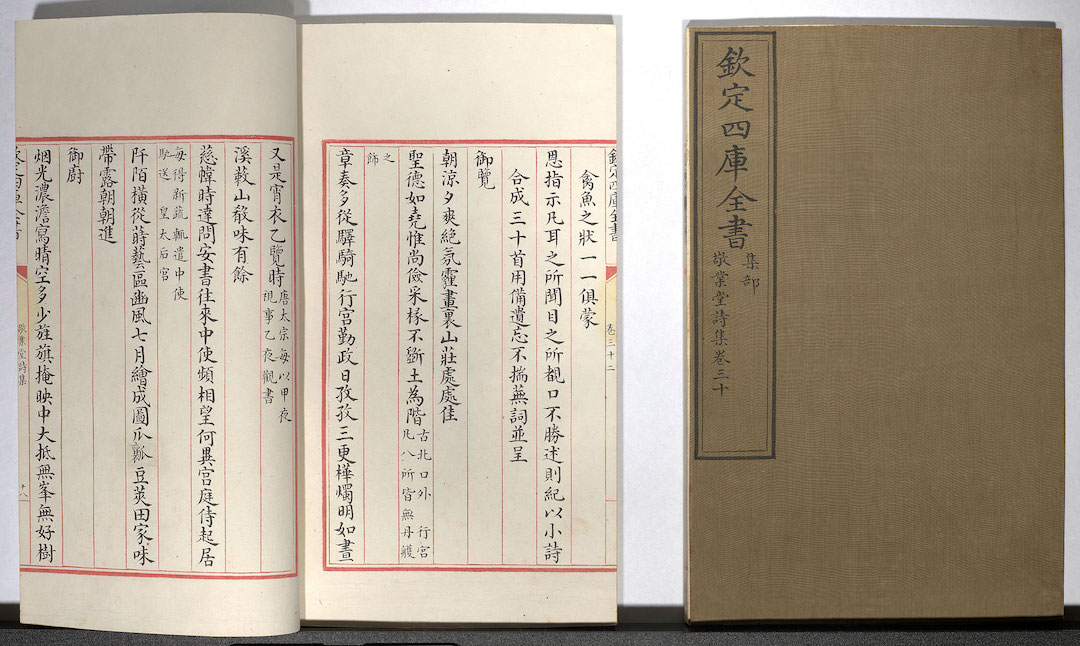
Inspection of Shenxing's "Collection of Poems of Jingye Tang", a national treasure written by Wenyuan Pavilion Siku during the Qianlong reign of the Qing Dynasty
Zha Shenxing (1650-1727) was a famous poet in the Qing Dynasty. He was a Jinshi in the 42nd year of Kangxi (1703). He entered the South Study Room and became a ci who accompanied the emperor in writing poems and drafting edicts. "Jingye Tang Poems" and "Hunting Notes" record many stories about the interaction between monarchs and ministers.
"Miscellaneous Songs of the Mountain Villa" records the deeds of the retinue who followed the emperor to the outside of the Great Wall in the 44th year of Kangxi's reign (1705). During these more than 100 days, he was instructed by the emperor to observe the natural environment and the ecology of animals and plants. The "Nasturtium", "Ulanai", "Luminous Wood" and other plants outside the Great Wall recorded in the collection of poems were all included in the "Guangqun Fang Pu" compiled by Nan Shufang at that time, which is a precious record of the investigation process.

Qing Dynasty Jiang Tingxi's sketch "Poppy" on paper
"Poppy Poppies" is selected from the sketchbook of Jiang Tingxi (1669-1732). Jiang Tingxi accompanied Emperor Kangxi (1654-1722) to the outside of the Great Wall many times. The subjects of this album should be the flowers seen outside the Great Wall, as well as the foreign flowers introduced to the court from the West.
The painting uses a boneless technique to depict yellow, red and purple flowers. The color gradation is delicate, and traces of light ink line drawings are faintly visible on the petals. Zha Shenxing (1650-1727) recorded that he was rewarded by the emperor with a kind of grass flower, which has the characteristics of "resembling a single-leaf poppy" and can withstand the cold of frost in autumn. It should be the wild poppy (Papaver) painted in the painting, which belongs to Temperate plants.
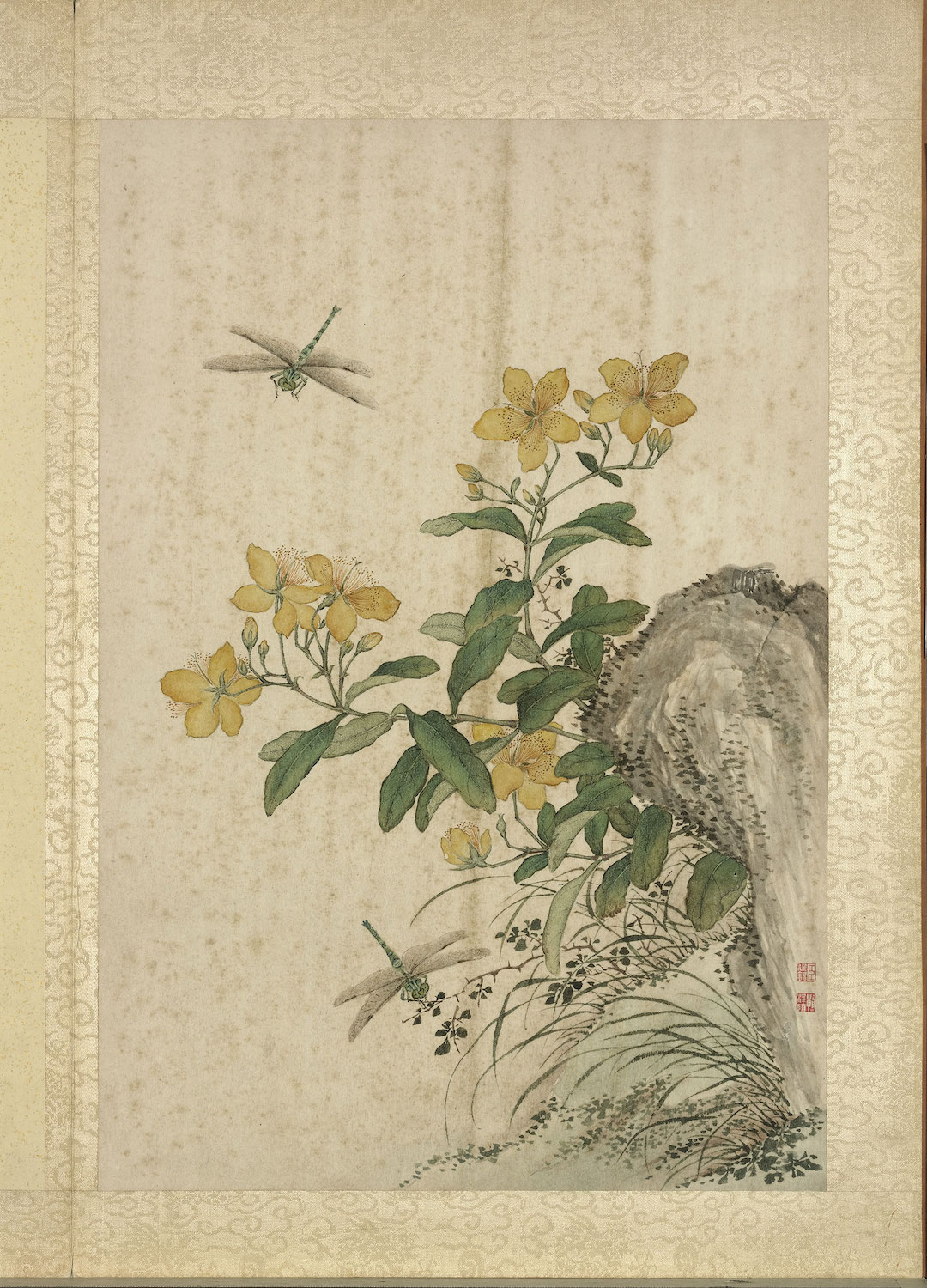
Qing Dynasty Jiang Tingxi's sketch "Hypervisum" on paper
In Jiang Tingxi's "Hypericum" painting, the yellow five-petaled flower growing next to the moss stone is the main character. It is lined with two dragonflies and thorns and weeds. It should be a depiction of Hypericum (Hypericum) flowers. It is named because the petals are similar to peach blossoms and the stamens are as thin as gold.
The composition of this painting is similar to the prints of the Ming Dynasty book Sancai Tuhui. Class books are encyclopedias written about different types of knowledge. Compared with traditional book sketches that emphasize the characteristics of each part of a single plant, book-like print illustrations begin to emphasize aesthetics and composition, adding exotic rocks and grass as backgrounds. Although the artist referred to the composition of the prints, he deliberately emphasized the stiff branches of the flowers branching outward, showing the characteristics of high-altitude flowers with less water. He should have actual experience of observing plants outside the Great Wall.
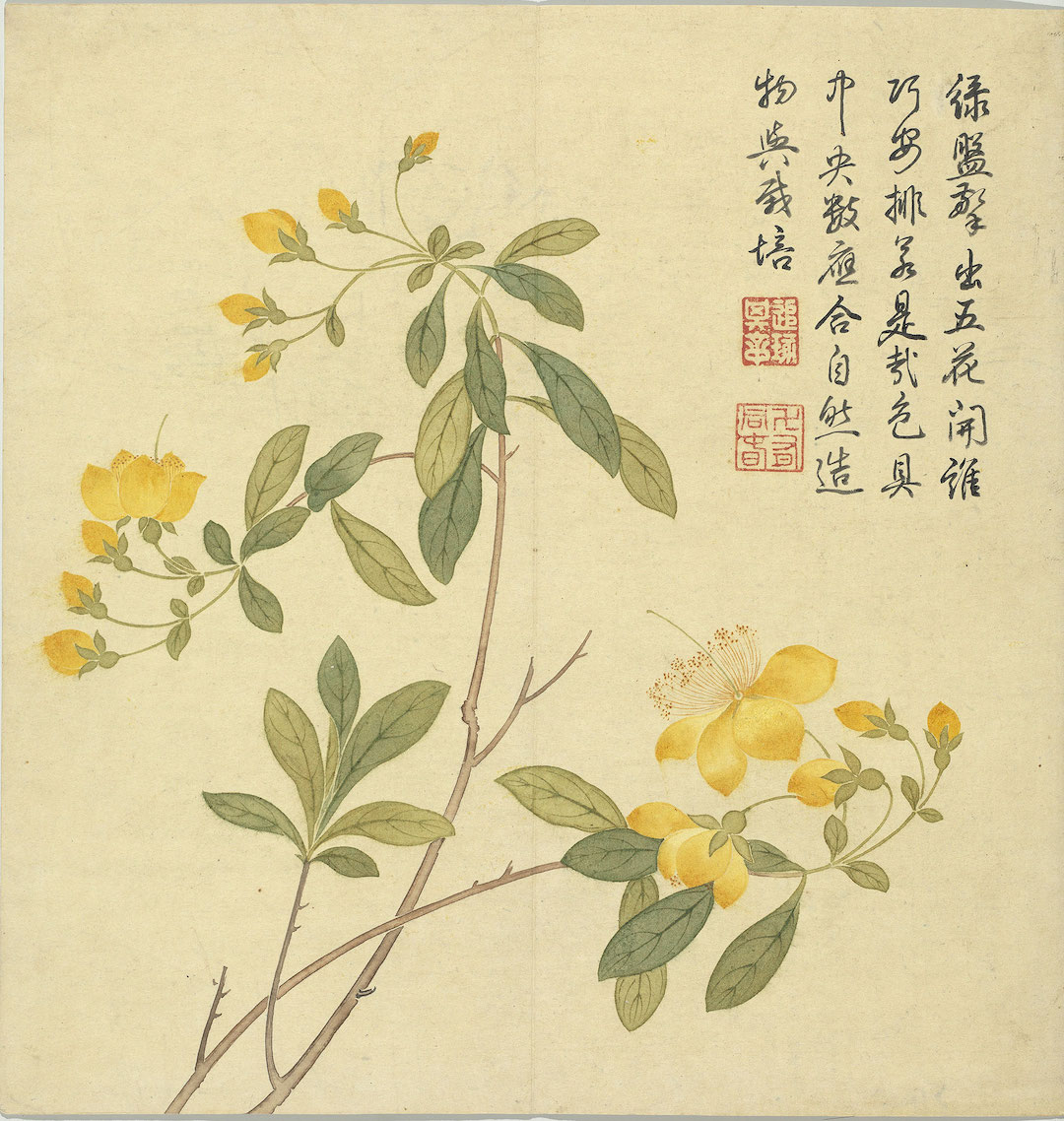
Qing Qian Weicheng Painting Flowers (Hypericum)
Qian Weicheng painted the flower Hypericum. In the painting, the flower stems are in an arc shape and the flowers and leaves are spread out neatly. The blooming positions of the flowers are cleverly arranged and seem to echo each other. Compared with the realistic drawings of various plant parts in the "Sketching Book", the composition of this painting gives the flowers an elegant and soft beauty.
According to "Guangqun Fangpu" records, Hypericum was planted in the royal garden in Luanjing (now Inner Mongolia) during the Yuan Dynasty. Emperor Qianlong wrote a poem calling it "the center of color", praising it for its true yellow color that represents the royal color.

Qing Dynasty Jiang Tingxi's sketch (Twining Peonies and Delphiniums) on paper
Jiang Tingxi's sketches (Twining Peonies and Delphiniums) depict blue-purple and light pink flowers, with two insects standing on the flowers, which appear full of life. The blue-purple flower is Delphinium grandiflorum, also known as blue sparrow. The "Guang Qun Fang Pu" compiled in the Kangxi Dynasty records that the characteristics of "Blue Bird Flower" are "shaped like a bird, with body, wings, tail, and yellow heart like two eyes", which is consistent with the characteristics of the petals in the painting. The pale pink flower was originally recorded as "lotus" in the Qing court, and should be Calystegia pubescens.
The flowers in the painting all belong to northern high-latitude plants. The stiff stems and leaves of the bluebird are paired with the soft twining peonies, which are cleverly contrasted.

Qing Dynasty Zou Yigui's paintings of flowers (jasmine, delphinium) on paper
Zou Yigui painted the flowers jasmine and delphinium. This painting uses the boneless technique to paint the delphinium (blue bird) and jasmine. Above it is a poem written by Emperor Qianlong. The composition of the painting emphasizes the symmetry and curved posture of the flowers and leaves. Compared with the realistic depiction of stiff flower stems by early Cichen painters, the delphinium flowers in the painting appear soft, which is a more freehand painting method.
According to the information provided by "Guangqun Fangpu", Emperor Qianlong believed in the poem that bluebird and dogwood were the same type of plant. Therefore, the allusion of Wang Wei's poem "Putting dogwood everywhere is missing" is compared to the "blue bird" outside the Great Wall to the dogwood flowers planted on the temples during the Double Ninth Festival, giving it a new meaning with allusions from Chinese poetry.

Qing Dynasty Jiang Tingxi's paintings "Qun Fang" on paper (partial part)
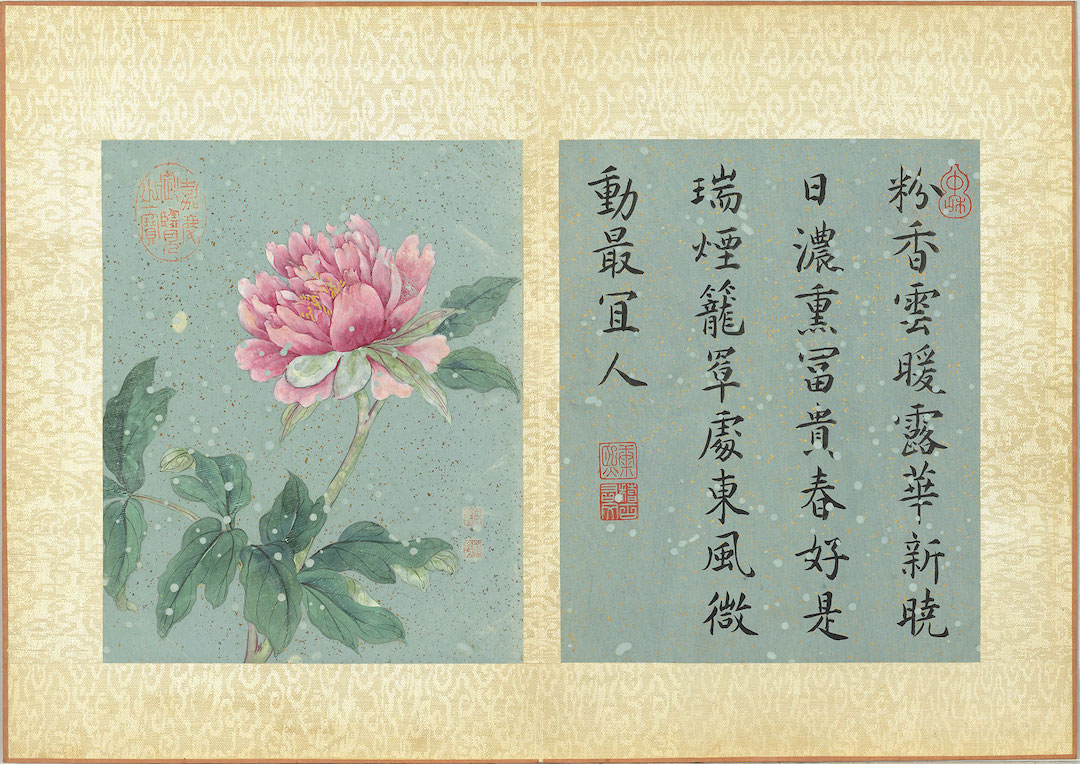
Qing Dynasty Jiang Tingxi's paintings "Qun Fang" on paper (partial part)
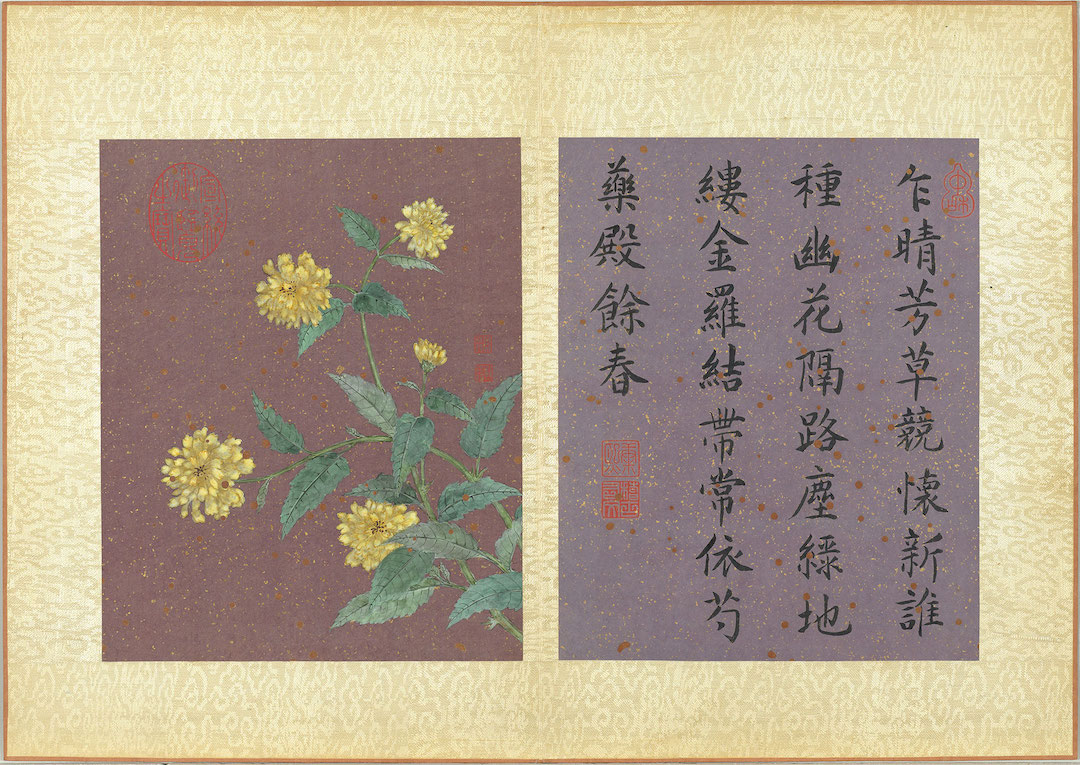
Qing Dynasty Jiang Tingxi's paintings "Qun Fang" on paper (partial part)
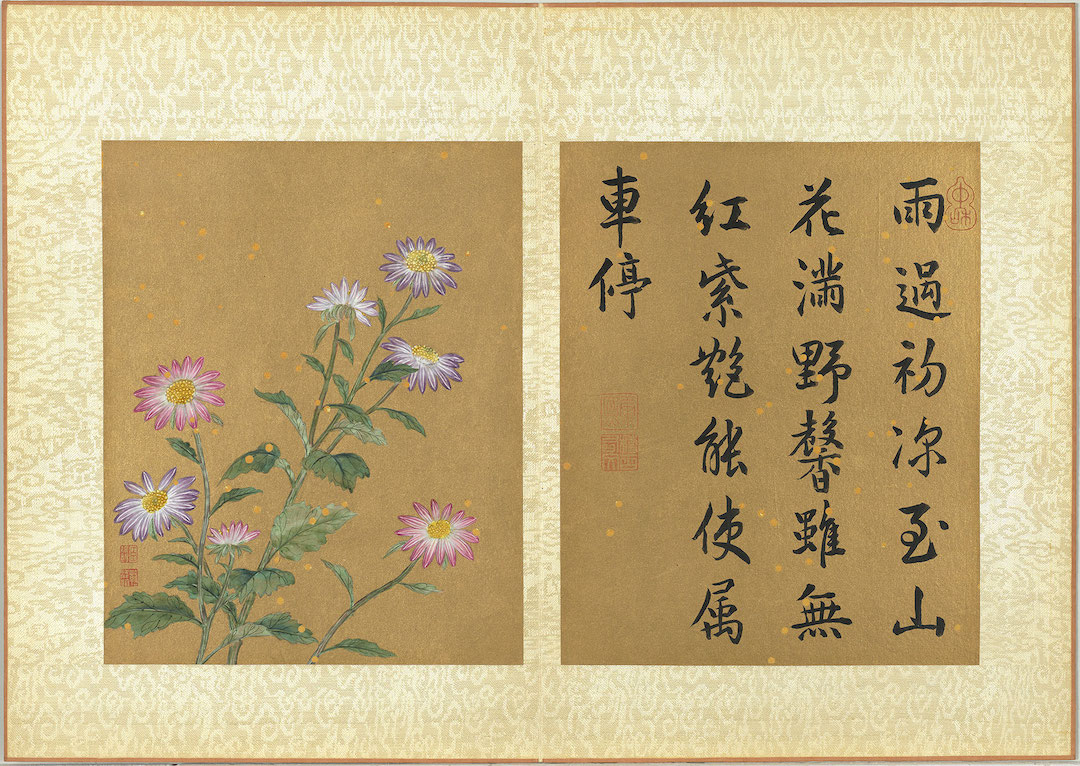
Qing Dynasty Jiang Tingxi's paintings "Qun Fang" on paper (partial part)
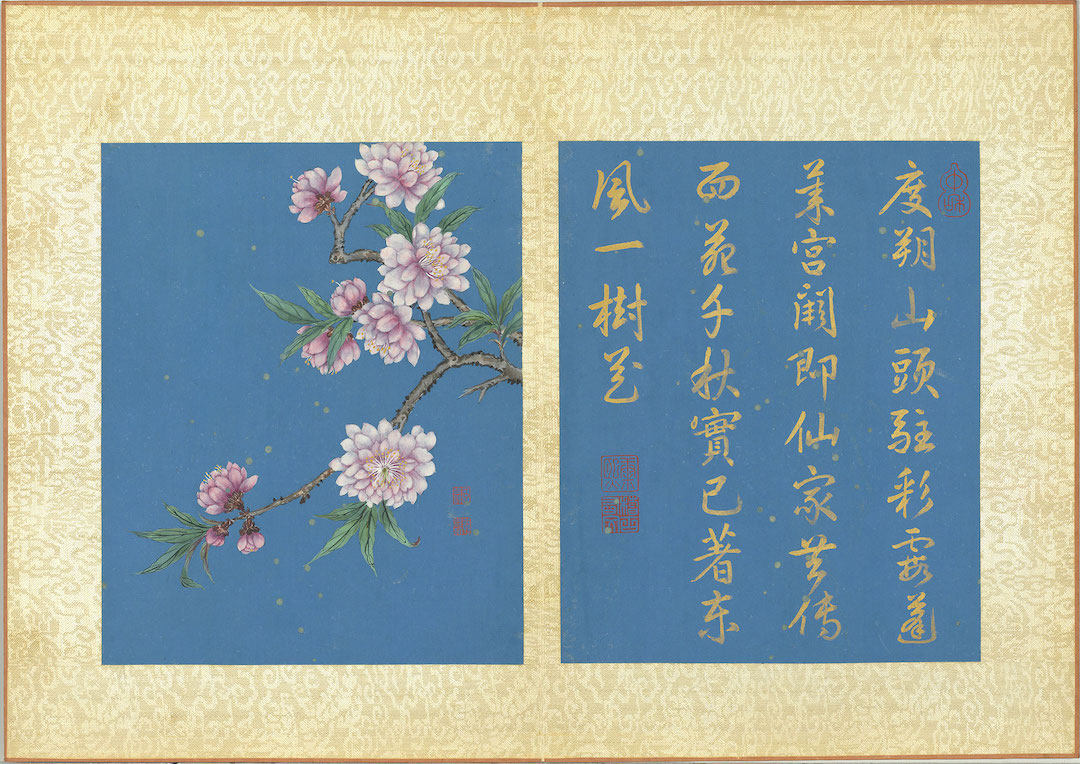
Qing Dynasty Jiang Tingxi's paintings "Qun Fang" on paper (partial part)
"Pictures of Flowers and Flowers" is composed of twelve poems written by Emperor Kangxi, and is paired with an album of calligraphy and painting of twelve kinds of flowers by the poet Jiang Tingxi (1669-1732). Because paper of different colors is used as the medium, the flowers are painted in rich and gorgeous colors. Most of the poems are taken from poems about things in the Song and Ming dynasties. Among them, the fourth, seventh and tenth chapters are poems written by Emperor Kangxi. They are based on the nasturtiums and aster outside the Great Wall and the southern azaleas transplanted to the palace. They contain the words "Man" and "Qing". The poem also uses the characteristics of flowers to compare virtues. It is a work in which Emperor Kangxi used chanting flowers to compare the virtues of his courtiers.
This album collects flowers from all over the north and south, which seems to mean that both the newly discovered northern flowers and the southern flowers with profound Han cultural significance are products of the Manchu Empire.
Flower paintings through the ages
Since flowers usually grow facing the sun, Guo Xi, a court painter of the Northern Song Dynasty, suggested looking down from directly above to observe the entire flower. However, after the painter captures the vivid gestures of flowers with his eyes, how does he paint the three-dimensional image onto the flat paper and silk? How do the painters from the Song Dynasty, Ming Dynasty and Qing Dynasty in this exhibition present the vitality of flowers?
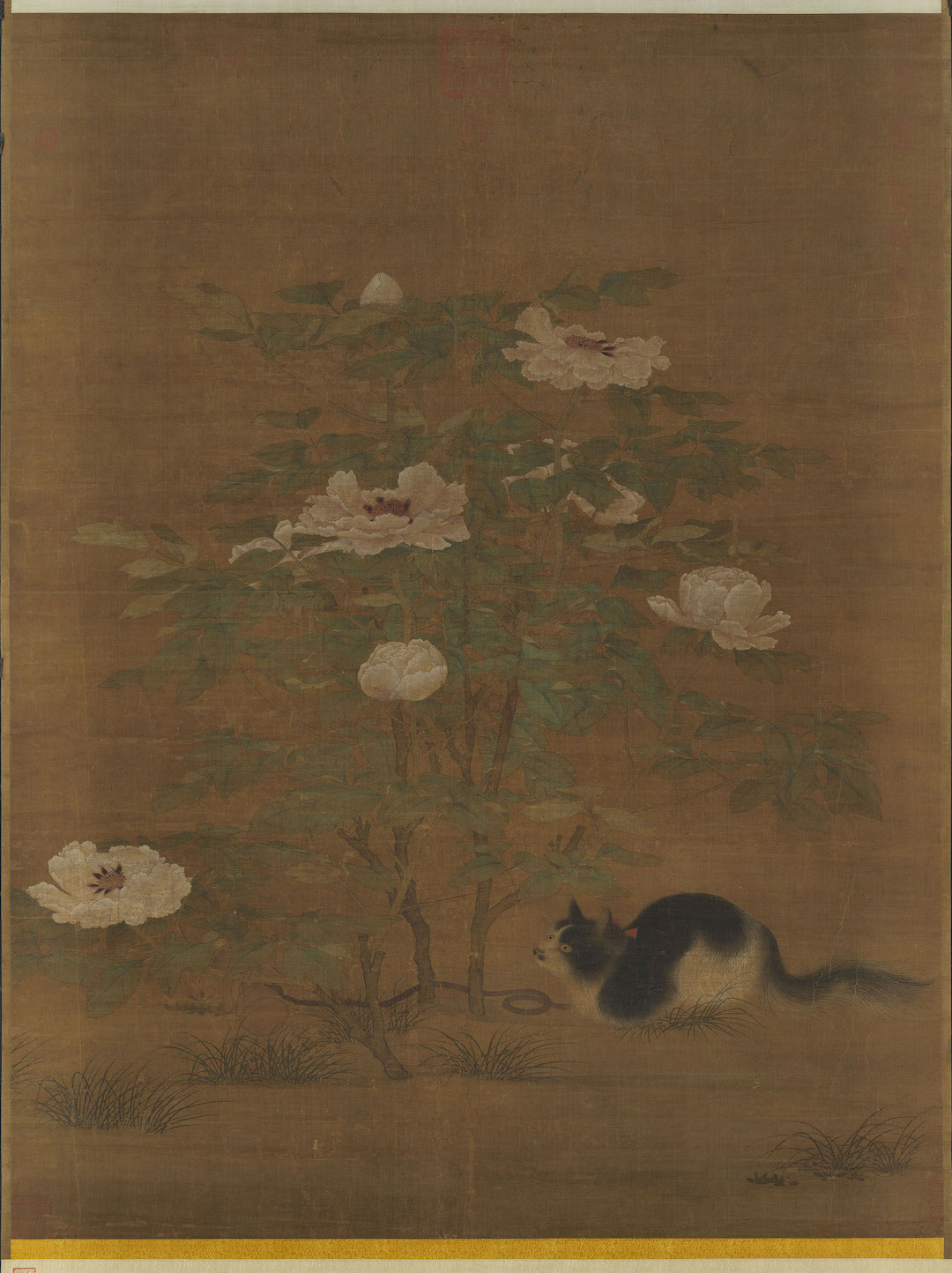
Song Dynasty's Wealthy Huali and Silk Edition National Treasures
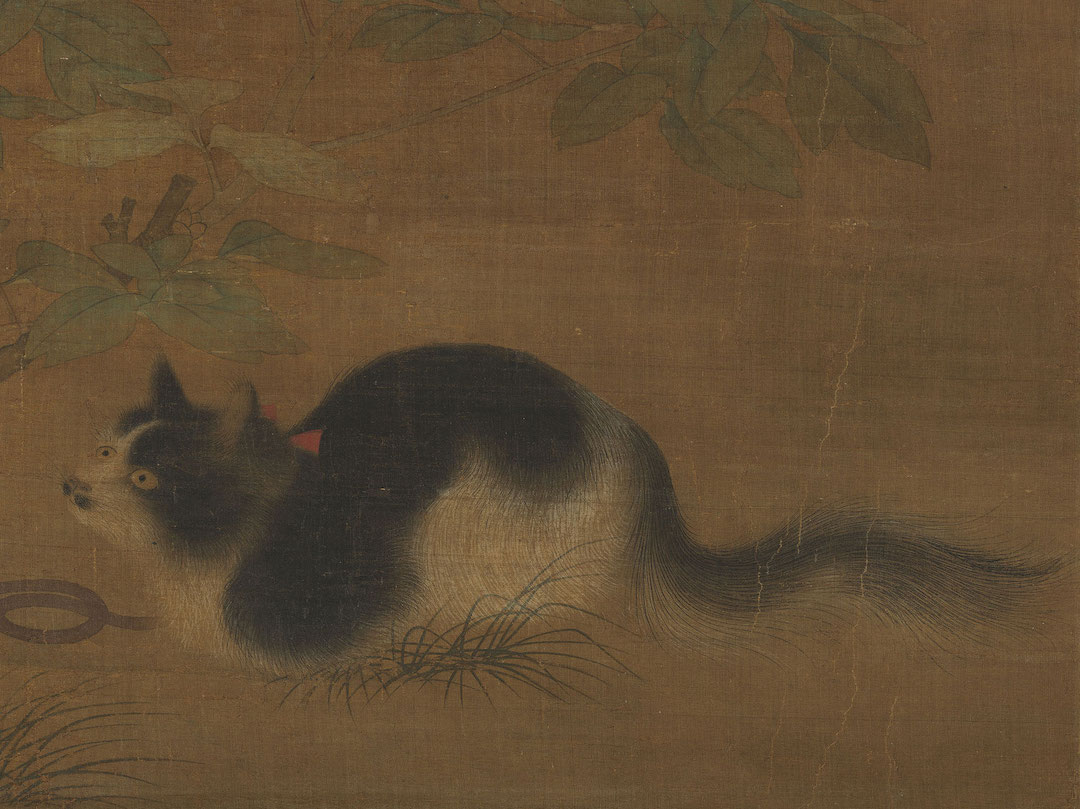
The Song Dynasty's Wealthy Flowers and Raccoon Silk are National Treasures (partial part)
This painting of the Song Dynasty "The Wealthy Fox" depicts a cat wearing a red bow tie under a bush of peonies, tied with a stone bell, which symbolizes wealth and longevity ("cat" is homophonic to "耄"). The peonies in the painting have buds that have not yet opened, slightly opened and fully bloomed flowers, showing flower postures in different stages. There are small purple petals between the white petals and yellow stamens, and the flowers are huge and belong to a special variety.
The silk on both sides of the painting is lighter in color, and it is speculated that it may have been originally made into a screen for display. Shen Kuo's "Mengxi Bi Tan" once mentioned a painting of peonies and cats. Through the blooming flowers and the narrow cat's eyes in the painting, it is judged to be the noon time, reflecting the delicate and precise observation characteristics of Song Dynasty paintings.

Song Ma Yuan Yi Yun Xian Apricot Silk National Treasure
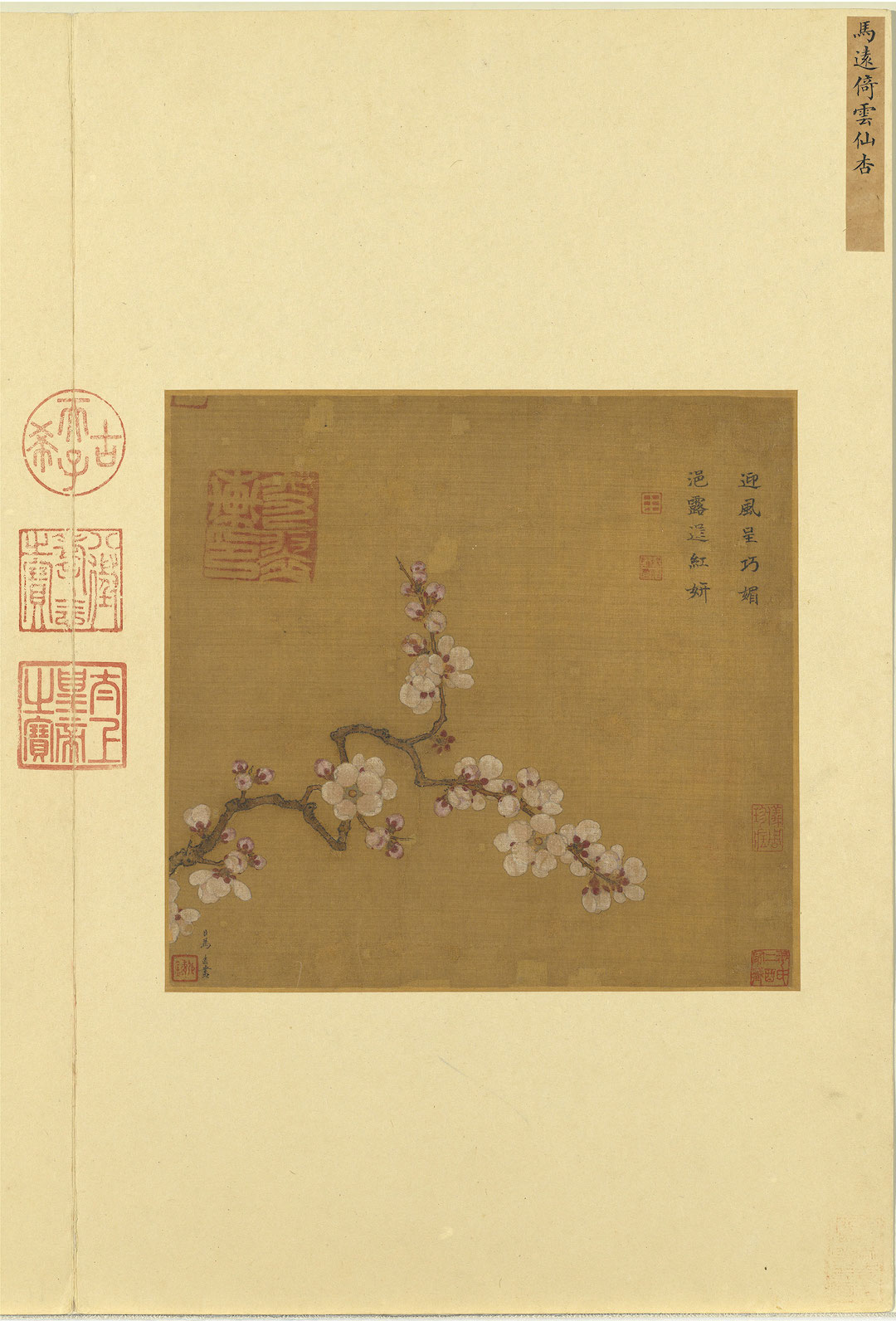
Song Ma Yuan Yi Yun Xian Apricot Silk National Treasure
There is a signature "Chen Ma Yuan Hua" in the lower left corner of the painting. Ma Yuan (12th-13th century) was a court painter of the Southern Song Dynasty. The entire plant and background are not shown in the painting, and only the partial flower posture is emphasized. Describes the different stages of apricot flowers from budding, blooming to withering.
On the upper right side is a poem written by Empress Yang (1162-1233) in small regular script, "The wind is charming, the dew is red and beautiful", and two seals are "Kun Gua" and "Yang's surname in Chinese calligraphy", which should be written in the second year of Jiatai, Ningzong of the Southern Song Dynasty. (1202) After being established as queen.

Important Antiquities of Minglu Period Apricot Blossom and Peacock Silk
Lu Ji (1477-?) was a court painter of the Ming Dynasty. In the painting, a peacock stands with one leg on a lake rock, followed by blooming peonies and apricot flowers. It may have been taken in the royal garden. The mist lingering above the apricot trees continues the style of court painting in the Southern Song Dynasty. Ming Dynasty court paintings paid more attention to the combination of animals and plants in the paintings to form auspicious meanings. For example, peony symbolizes wealth and honor, and peacock is a homonym for "jue", symbolizing high official status.
The flowers and birds are depicted with delicate fine brushwork techniques, while the trees and rocks are depicted with rough ink brushes, giving the picture a contrasting effect of thick and thin brushes. This composition method, which uses brushwork to distinguish the theme and background of the painting, was also used by the court of the Qing Dynasty.
Textual research on flower genealogies - the emperor’s reading experience
All questions about flowers can be answered in "Guangqun Fangpu". This encyclopedia of flowers compiled during the Kangxi Dynasty sorted out the synonyms, habits, varieties, historical allusions and ancient poems of flowers. It is also the best reference book for emperors and scholars to write poems about flowers.
In order to cater to Emperor Qianlong (Aisin Gioro Hongli, 1711-1799)'s hobby of textual research, the poets and painters painted various flower paintings so that the emperor could display his calligraphy and poetry creation abilities and enjoy naming and writing poems for the flowers in the paintings. fun of.
Flower Atlas
"Atlas" generally refers to works that collect images of the same theme into a volume. Each image is usually labeled with a name to facilitate people's identification. During the Ming and Qing Dynasties, a large number of color atlases began to appear, focusing on presenting the characteristics and appearance of objects with detailed and rich colors, trying to leave visual evidence for the objects.
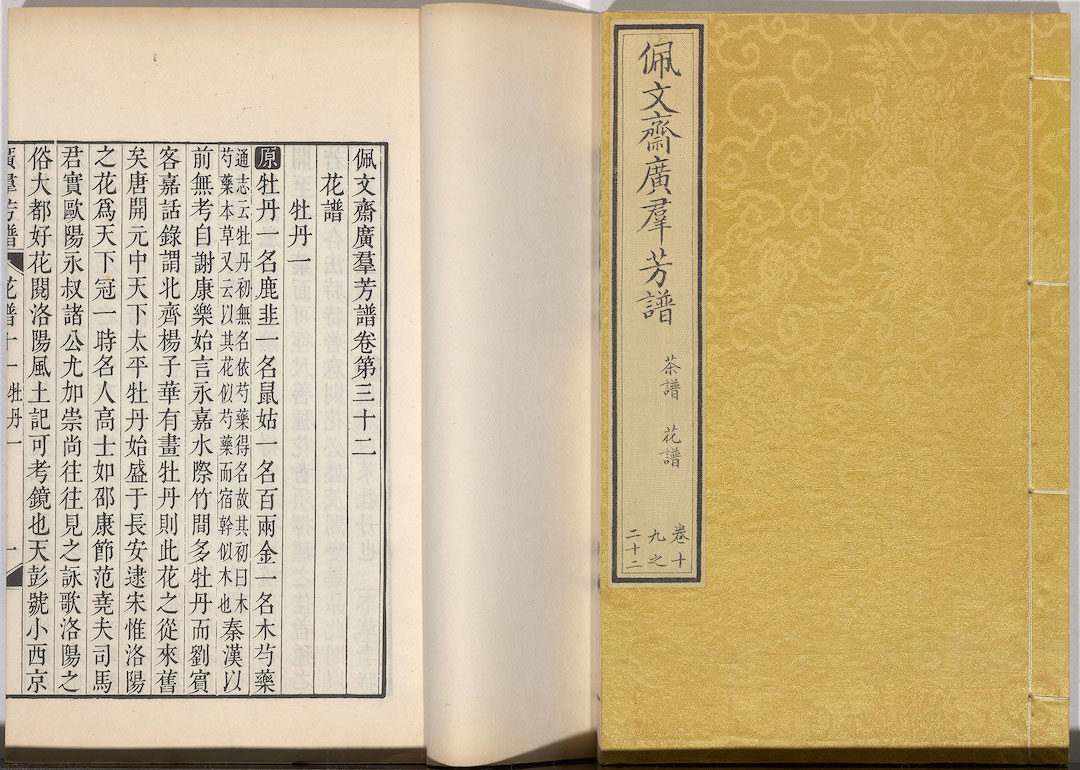
Wang Hao and others of the Qing Dynasty were commissioned to compile "Pei Wenzhai Guangqun Fang Pu", published by Wuying Palace in the 47th year of Emperor Kangxi's reign in the Qing Dynasty.
"Pei Wenzhai Guangqun Fang Pu" is a record of plant genealogy, with a total of one hundred volumes. "Peiwenzhai" is the name of Emperor Kangxi's study. This book is an official edited book ordered by Emperor Kangxi (1661-1722), led by the Ci Minister Wang Hao (1671-1706), to expand and revise the "Qunfang Pu" written by Wang Xiangjin (1561-1653) of the Ming Dynasty. Wang Hao once followed Emperor Kangxi to spend the summer outside the Great Wall, and wrote "Sui Luan Ji En" about what he saw along the way. The plants outside the Great Wall added to "Guangqun Fangpu" also appear in Wang Hao's travel notes.
This book is similar to a modern encyclopedia. The content lists plant names, aliases, distribution locations, growth forms, application scenarios (pharmacological or edible conditions), etc. in sequence. It also lists poems and articles on related topics in the past dynasties in detail, making it very convenient to read. When Emperor Qianlong (1711-1799) wrote poems, he often quoted the information collected in Guangqun Fang Pu and then put forward his own opinions based on research.
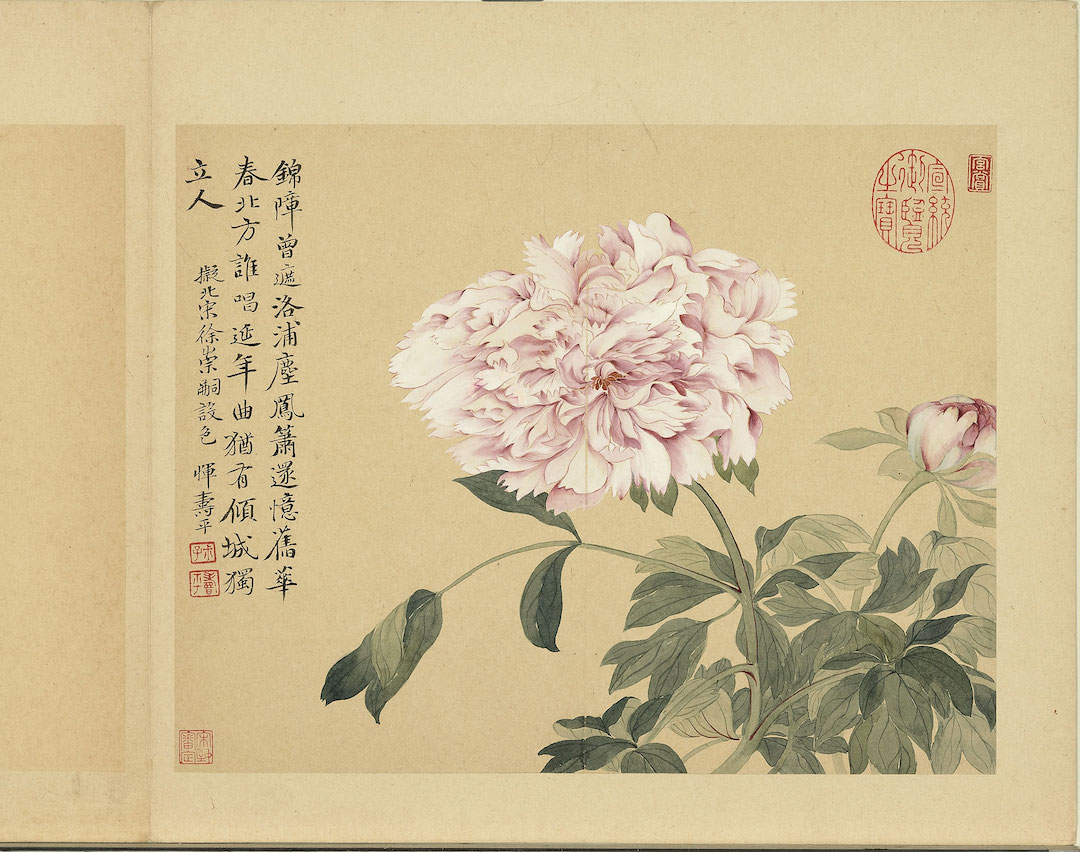
"Peony" by Yun Shouping, Qing Dynasty, important antiquities on paper
This painting uses the "boneless method" to depict a peony in full bloom and a peony in bud. It is a technique that does not use ink lines to outline lines, but instead uses delicate color changes to shape objects. The artist mixed ocher red with white powder or cyan, carefully painted each petal, and then used reddish brown to outline the edges. The composition deliberately emphasizes the elegant and soft feeling of the flowers and leaves, as if capturing the moment when the flowers are swaying gently in the wind.
Yun Shouping (1633-1690) was one of the "Six Masters of the Early Qing Dynasty". He reinterpreted the boneless method of the Northern Song Dynasty painter Xu Chongsi (in the second half of the 10th century), which became very popular in the Qing Dynasty. Although Yun Shouping never entered the palace, his painting style was introduced to the court through his disciples and painters from his hometown of Changzhou, and had a profound influence on flower paintings in the Qing court. Even Emperor Qianlong copied Yun Shouping's flower works many times.
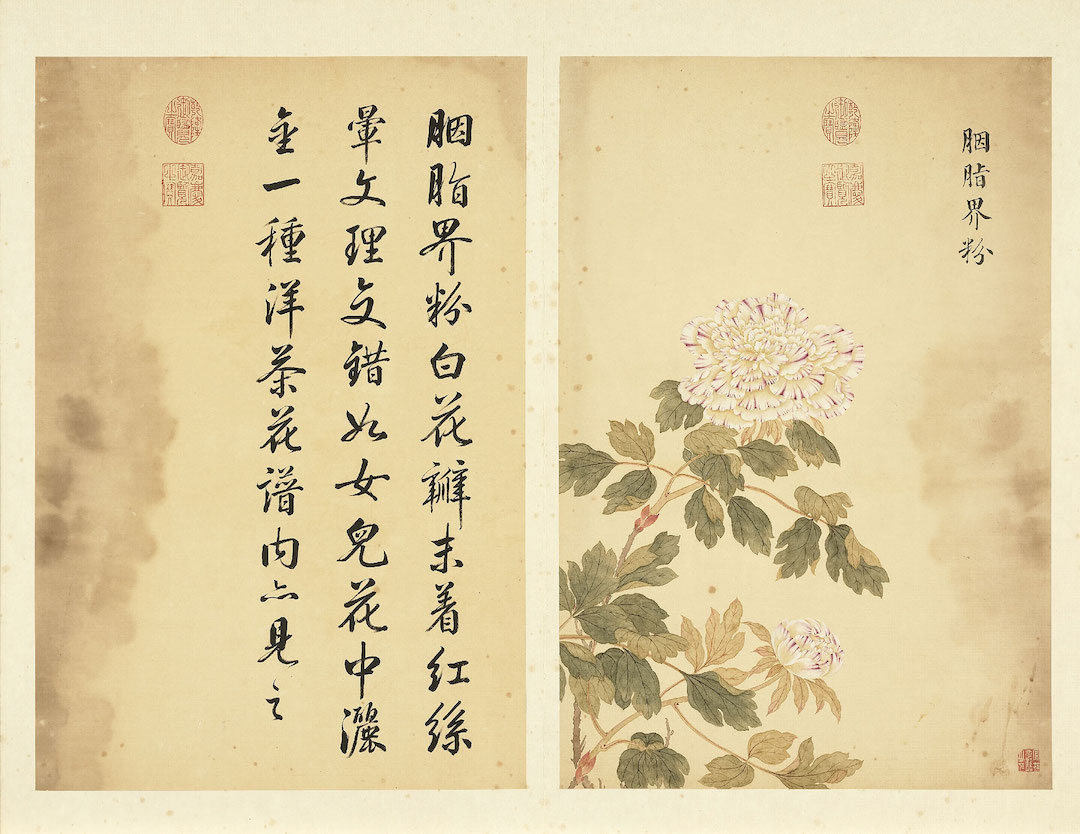
Zou Yigui Mo Miaozhu Lin Rouge Realm Powder
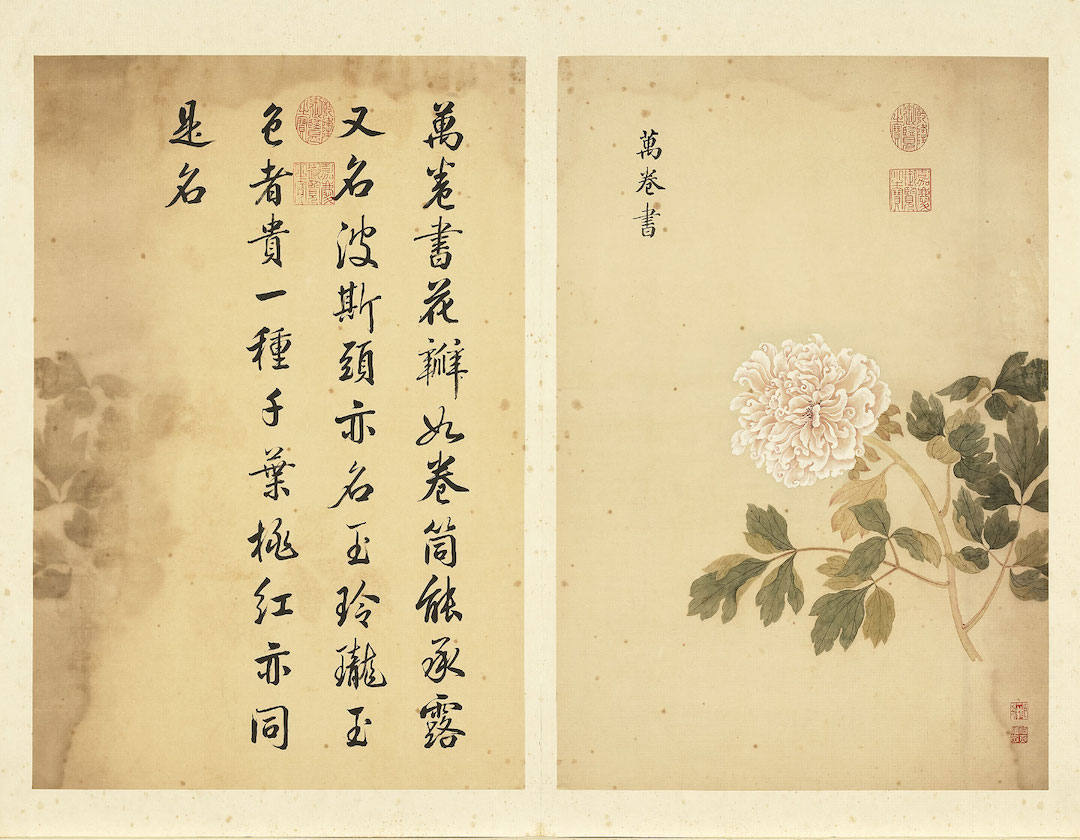
Zou Yigui's ink and beautiful pearls are in the forest of thousands of books
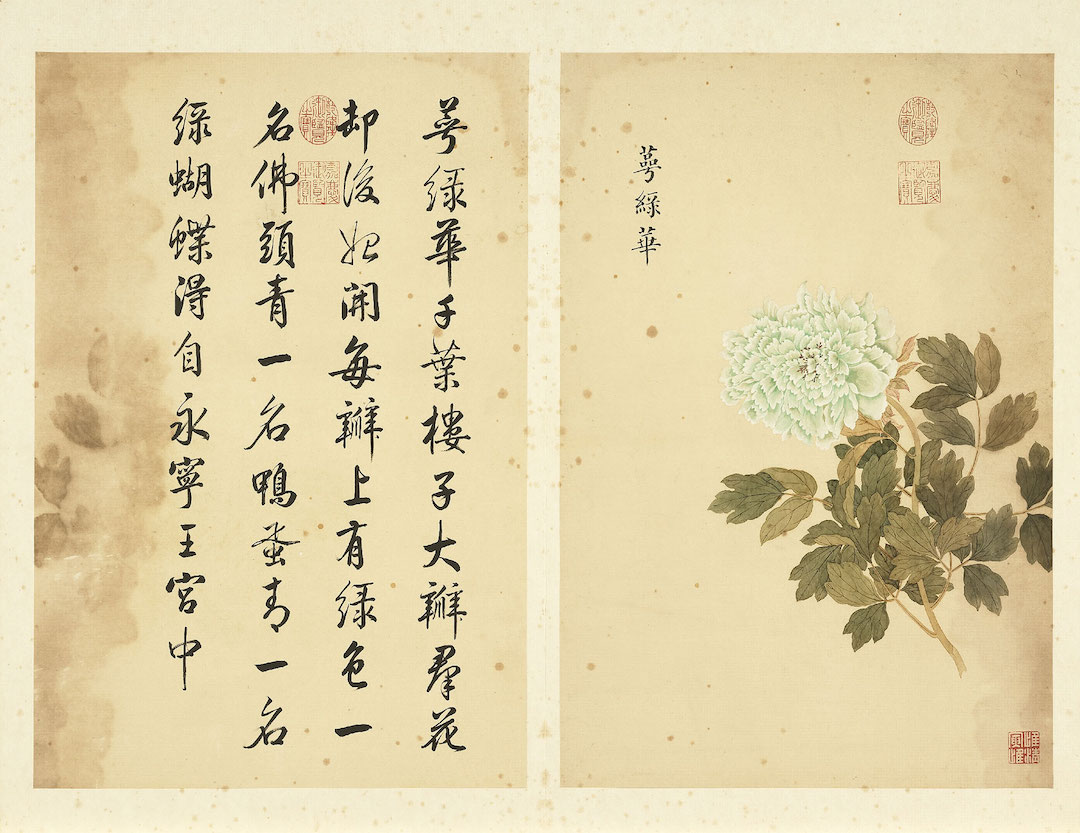
Zou Yigui's ink, beautiful pearls, forest calyx and green flowers
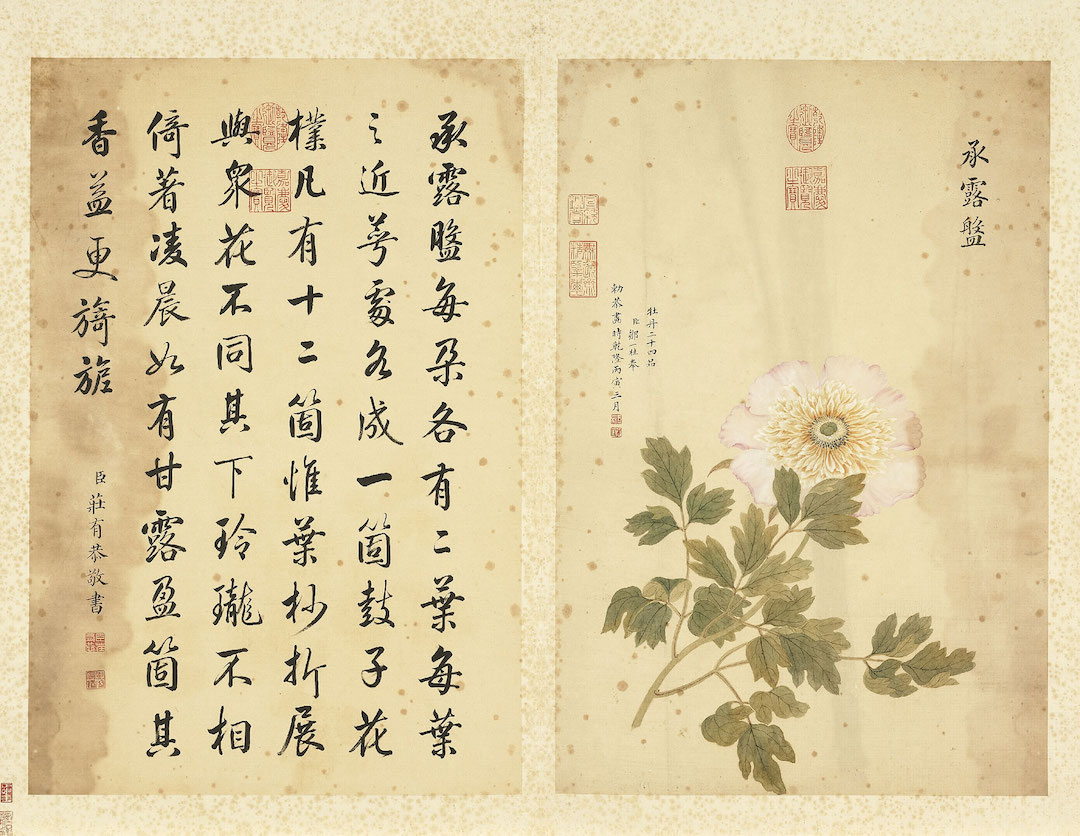
Zou Yigui's ink painting and Lin Chenglu's plate
"Mo Miaozhu Lin" consists of twelve volumes, with twelve different themes drawn by twelve painters from the Qianlong Dynasty. Each volume is twenty-four pages. The "Twenty-Four Peonies" included in this exhibition was drawn by Zou Yigui (1686-1772) and inscribed by Zhuang Yougong (1713-1767), forming a map with both pictures and text. The text excerpts the varieties recorded in the flower encyclopedia "Pei Wen Zhai Guang Qun Fang Pu", coupled with flower pictures, to convey information that cannot be conveyed by words.
Zou Yigui was the first Jinshi (Chuanlu) in the fifth year of Yongzheng's reign (1727). He was related by marriage to Yun Shouping (1633-1690) and was also good at painting boneless flowers. The peonies in the album all feature a large flower with branches and leaves stretching left and right, emphasizing the curve of the flower swaying left and right, which is quite anthropomorphic.
The Forbidden Garden of Moving Roots—Flowers from the North and South Enter the Palace Together
In order to meet the emperor's demand for flower appreciation and palace decoration, Jiangnan Weaving, which provided the royal supplies every month, would use water transport ships to deliver seasonal flowers to the "South Garden" of the Forbidden City in Beijing. In addition to the southern flowers introduced on time, the emperor also transplanted northern flowers to the Forbidden City and Chengde Summer Resort, such as the thousand-leaf lotus from Aohan Banner in Inner Mongolia, or the golden lotus from the northern mountains. Through the growth status of flowers in other places, the emperor could also indirectly know the current situation of the place of production.
These flowers from different latitudes and altitudes are carefully taken care of by palace gardeners. In winter, a greenhouse or flower room is set up to control the flowering period. They overcame the situation of being "acclimated to the soil" and bloomed smoothly, reflecting the court's proper cultivation and the technology to master the habits and environment of flowers.
Twelve Forbidden Pictures
"Twelve pieces of rice paper were handed over, and twelve poems for the twelve months were made by the emperor, and the order was passed on to Ruyiguan painters Shen Yuan (active from 1736-1795), Ding Guanpeng (about 1708-1771), Yu Sheng (1692-1767), Zhou Kun (active in the 18th century) painted together and presented the first draft."
Emperor Qianlong (1711-1799) ordered four court painters to create a series of "Twelve Forbidden Pictures" by matching twelve imperial poems with the scenery of twelve royal gardens, and used the "Twelve Forbidden Pictures" of traditional Chinese music. They are named after "Erlu", namely Huangzhong, Taicu, Guxi, Ruibin, Yize, Wushe, Linzhong, Nanlv, Yingzhong, Dalv, Jiazhong and Zhonglv.
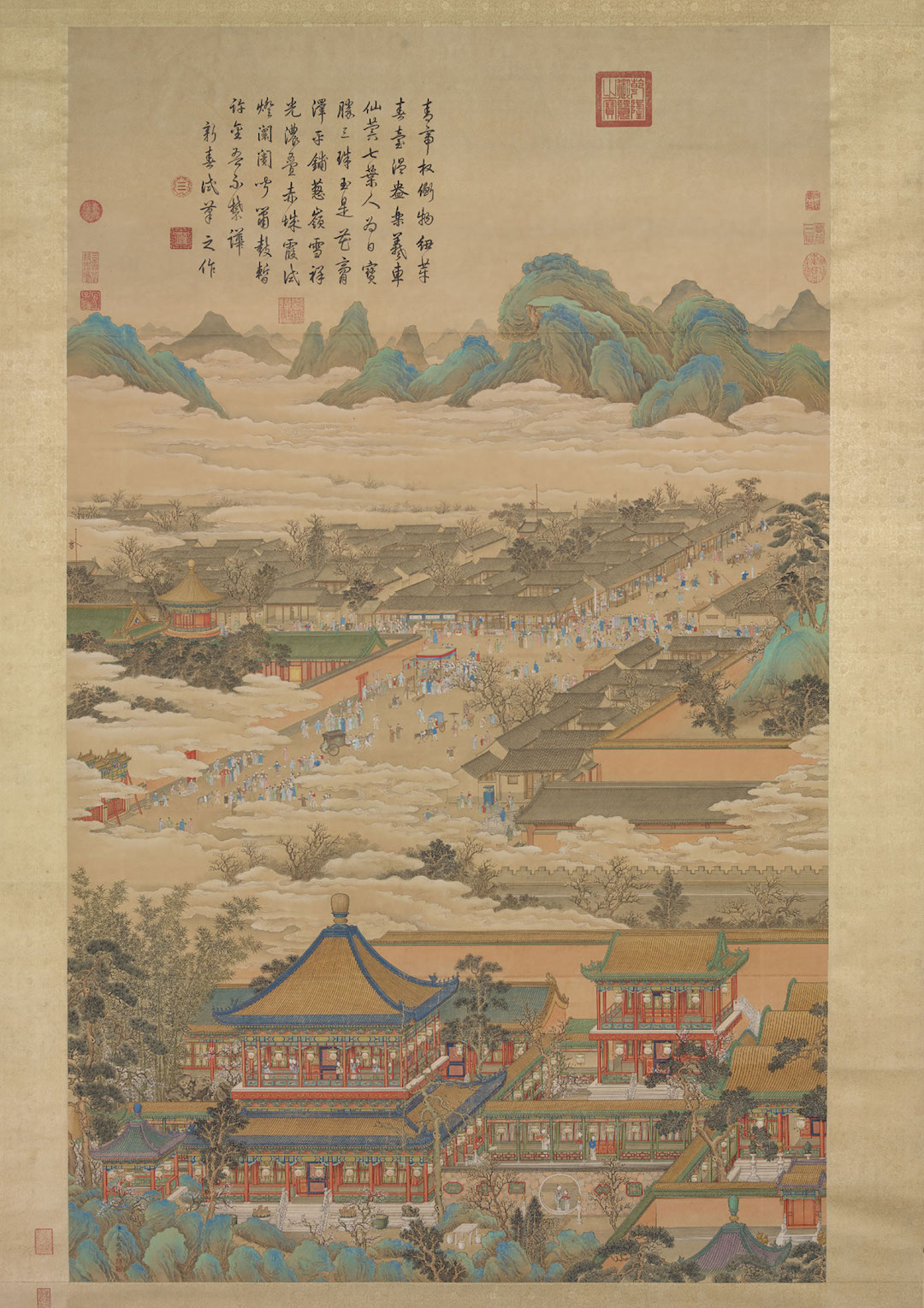
Qing Dynasty Ding Guanpeng's painting of Taicushi and silk
"Taicu" corresponds to the first month of the lunar calendar. The painting adopts a bird's-eye view, depicting the Jianfu Palace in the Forbidden City and Jingshan Front Street outside the city, and uses clouds to cover part of the city wall, highlighting the mystery of the Royal Garden.
In the fourth year of Qianlong's reign (1739), the Jianfu Palace Garden was built year by year. It is located in the northwest of the Forbidden City and is also called the "West Garden". The garden in the painting is located in front of Yanchun Pavilion, with white and pink plum blossoms in full bloom. The palaces and pavilions are decorated with lanterns, there are many vendors outside the city, and there are various opera performances on the streets, presenting a lively scene of celebrating the New Year on the seventh day of the first lunar month.
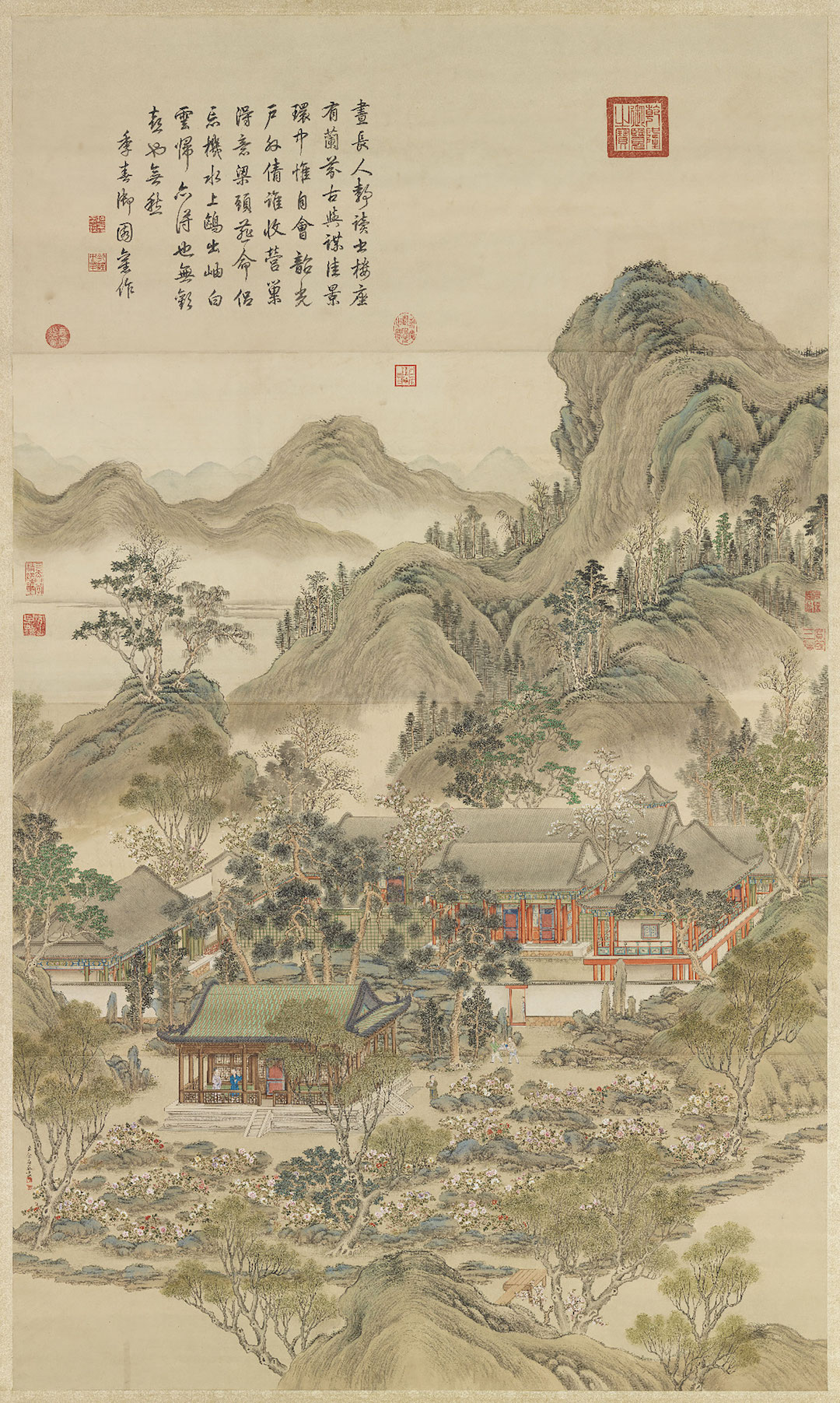
Painting Gu Xichangchen from the Yu Province of the Qing Dynasty, on silk
"Guxi" corresponds to the month of spring, which is the third month of the lunar calendar. The painting depicts the southeast corner of the back lake of Yuanmingyuan. The viewing platform in the front is the "Peony Terrace" and the backyard is the "Yusu Bookstore". The garden is planted with various peonies and magnolia trees. In the ninth year of Qianlong's reign (1744), this place was named "Laoyue Kaiyun".
The Old Summer Palace was the residence of Emperor Yongzheng (1678-1735) before he ascended the throne. In March of the 61st year of Kangxi (1722), the young Emperor Qianlong (1711-1799) was summoned to the Peony Terrace and met his grandfather Emperor Kangxi (1654-1722) for the first time, who was invited to enjoy the flowers. Therefore, he was granted the opportunity to move to the palace to receive education. opportunity, so this place was of great significance to Emperor Qianlong.

Lu Qinghe in a painting by Shen Yuan of the Qing Dynasty, on silk
"Zhonglu (Zhonglu)" is the month of Mengxia, which is the fourth month of the lunar calendar. The Qingyinzhai in Jingmingyuan Garden in this painting is located on the south side of Yuquan Mountain. It was the westernmost royal garden in Beijing during the Qing Dynasty.
The garden in the painting is full of piles of rocks, with peonies, camellias and other flowers scattered among them. There is a throne in the garden pavilion for the emperor to enjoy flowers. Two young men were leaning on the railing in the pavilion and talking. A boy servant came with a book, as if he wanted to serve his master, appreciate flowers and recite poems. White and pink peach blossoms bloom on the distant water bank. In ancient times, peach blossoms were originally spring flowers. Due to the colder weather in the north, the flowering period was slightly delayed.
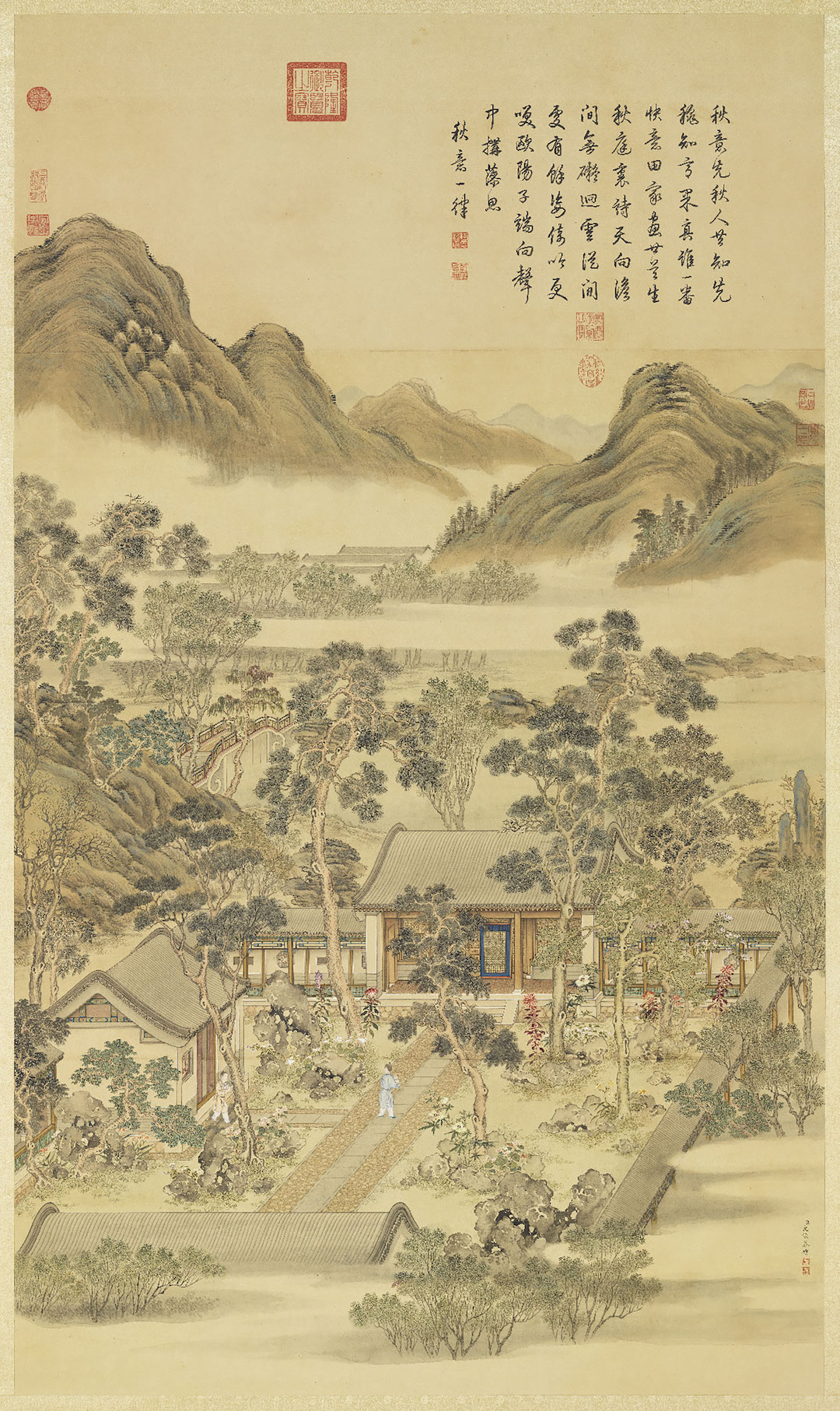
Painting by Shen Yuan of Qing Dynasty and Shang Dynasty on silk
"Yi Ze" corresponds to the month of Mengqiu, which is the seventh month of the lunar calendar. This painting "Forty Scenes of the Old Summer Palace" is a scenic spot of "diligence and closeness to the virtuous". This place was built in the third year of Yongzheng (1725) and was the daily residence of Emperor Qianlong (1711-1799).
The close-up view in the painting is the courtyard of "Autumn Garden", in which various flowers and trees bloom, including towering pine trees and sycamores, as well as autumn flowers such as begonias, day lilies, cockscombs, and chrysanthemums. The wall verandahs have window openings of various shapes, and the courtyard walkways are decorated with pebbles, imitating the characteristics of Jiangnan garden architecture.
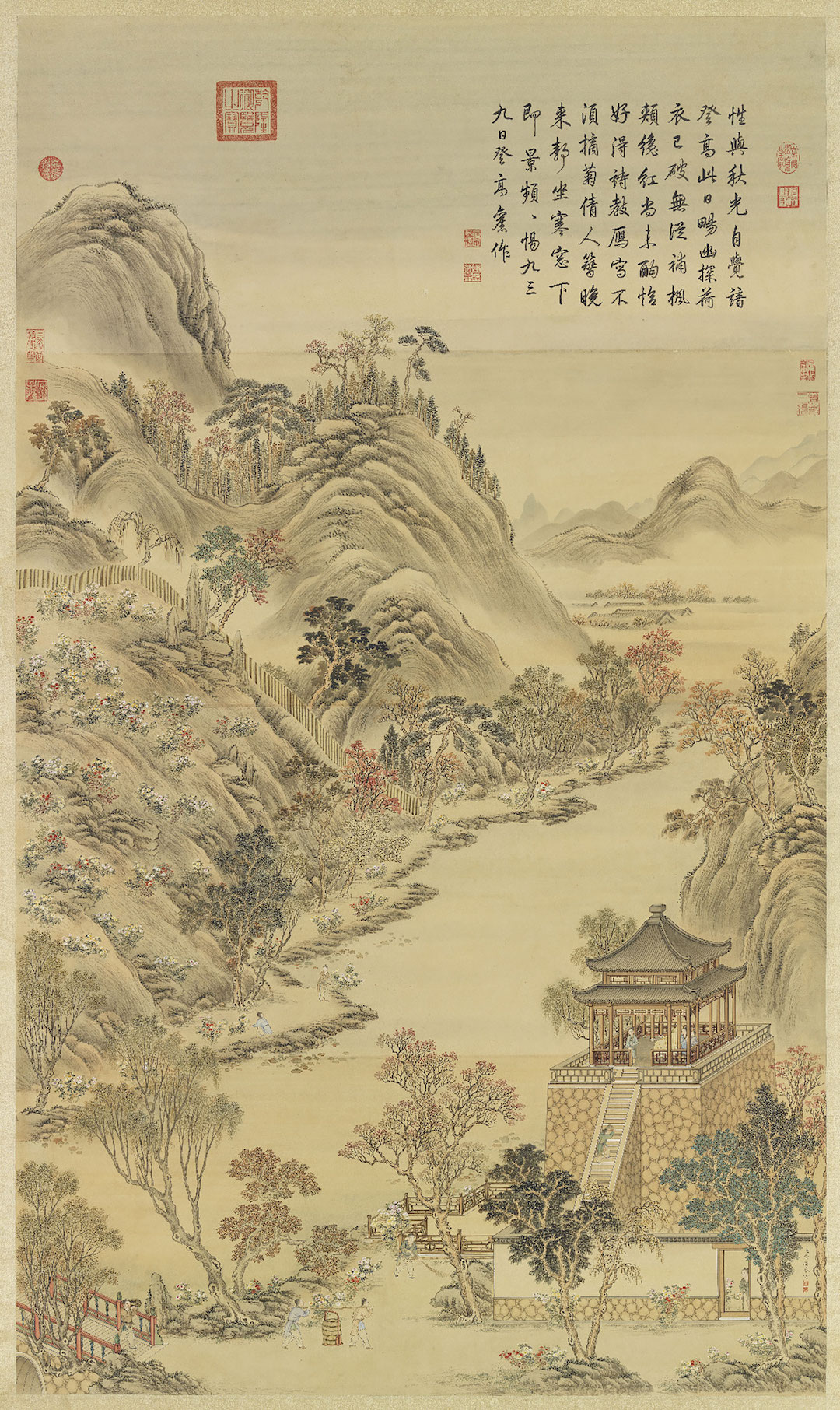
Qing Yu Province Painting on Wushejie Han Silk
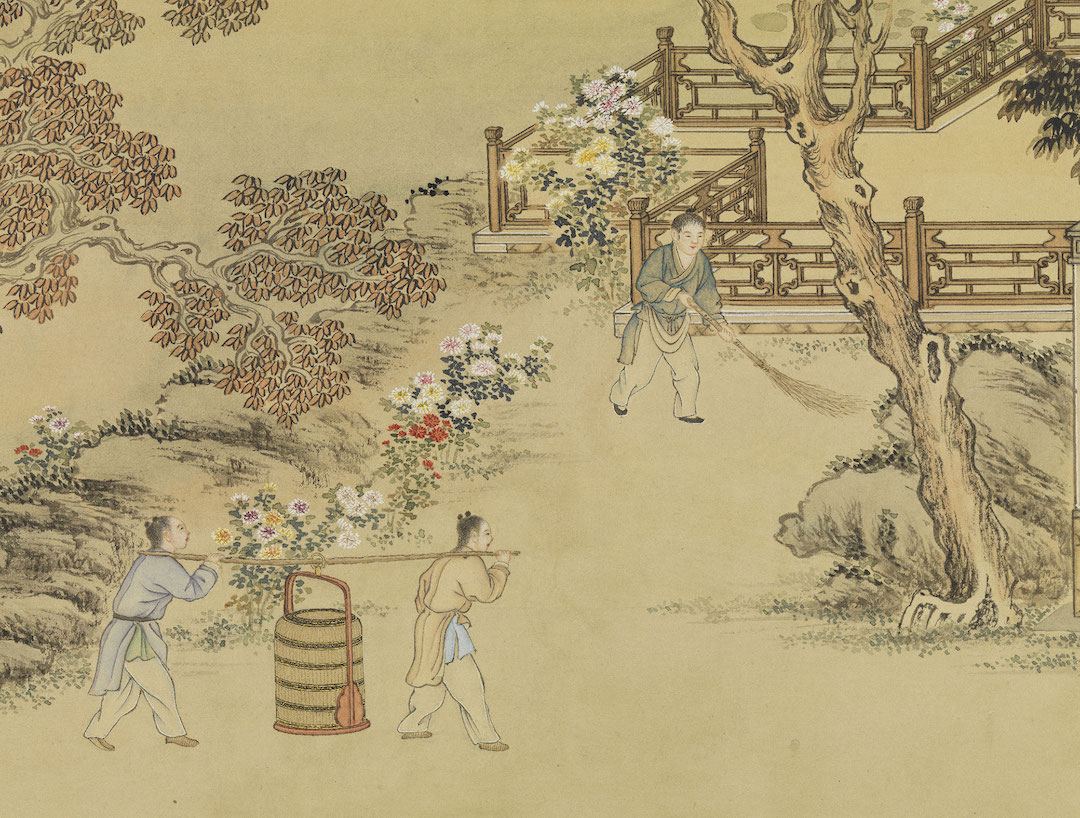
Qing Dynasty Painting on Wushejiehan Silk (Part)
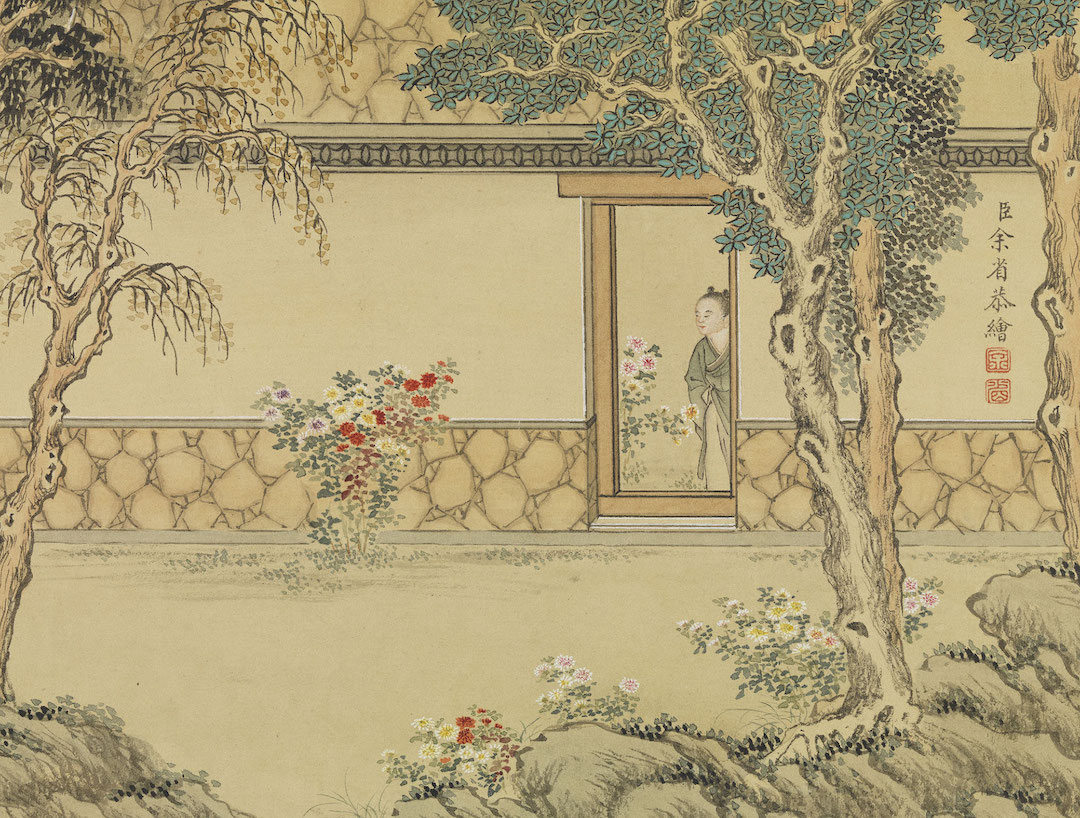
Painted Wushejiehan silk from the remaining provinces of the Qing Dynasty (partial part)
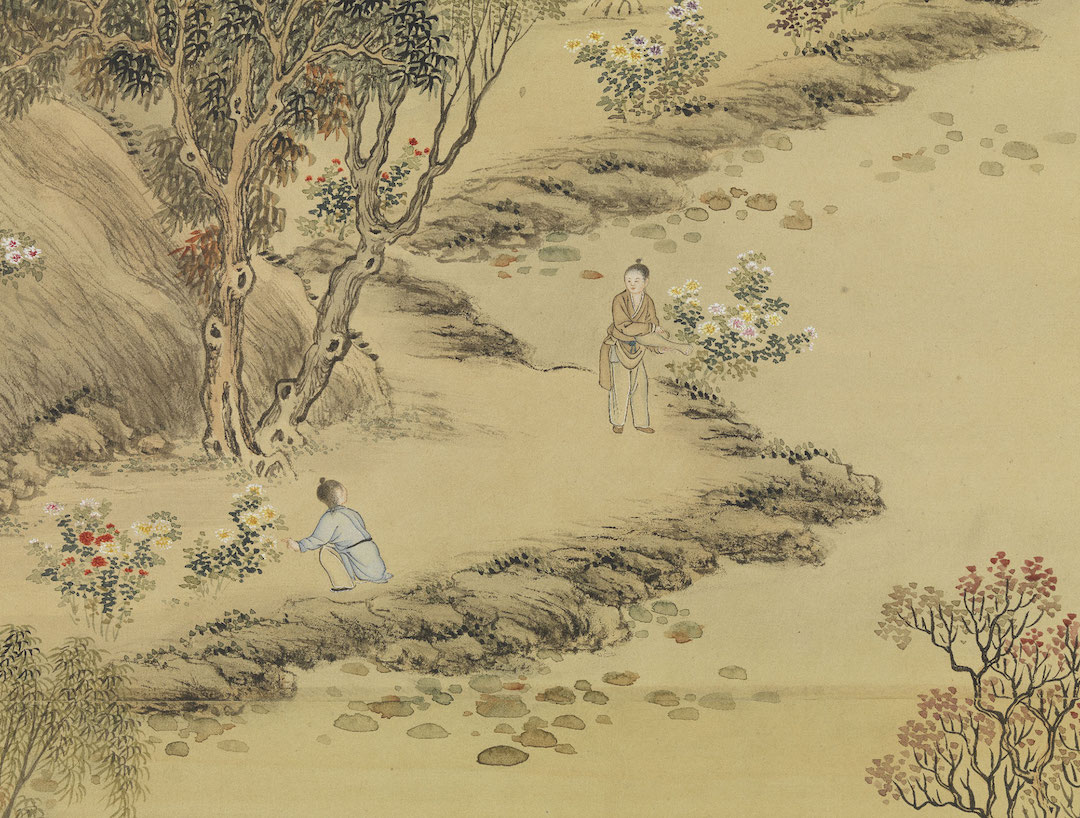
Painted Wushejiehan silk from the remaining provinces of the Qing Dynasty (partial part)
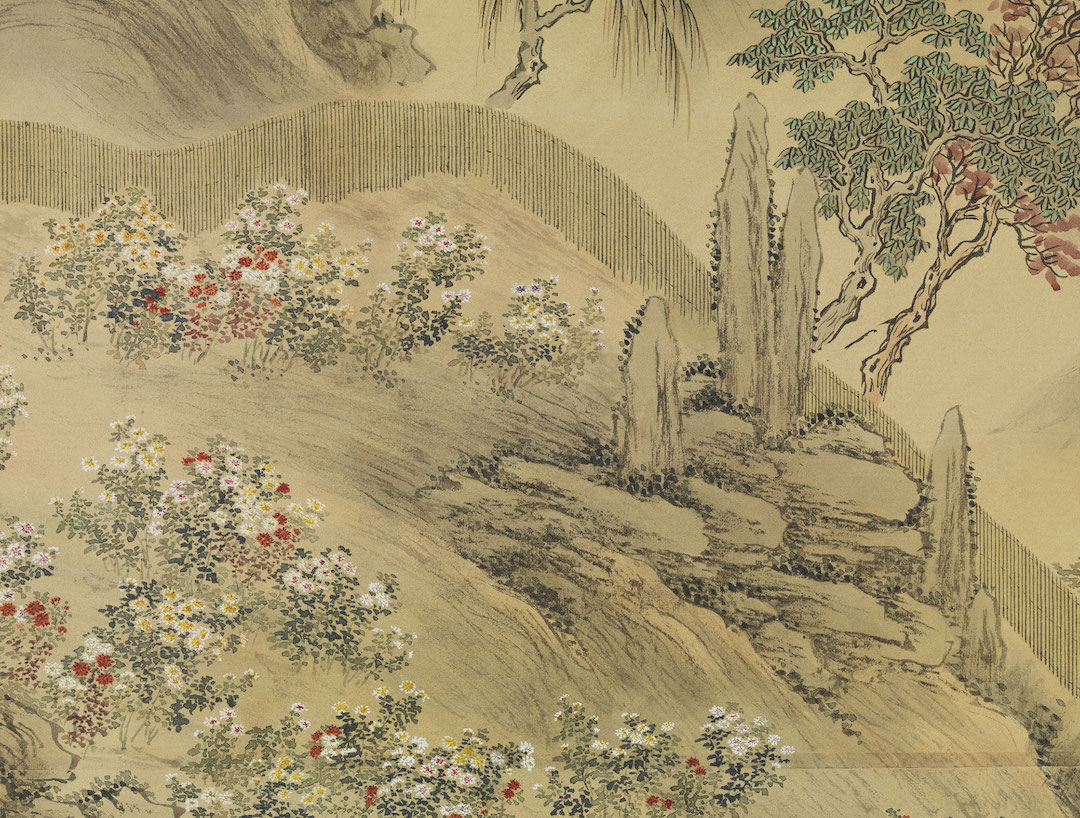
Painted Wushejiehan silk from the remaining provinces of the Qing Dynasty (partial part)
"Wu She" corresponds to the month of autumn, which is the ninth month of the lunar calendar. The garden in the painting is the "Autumn Moon over the Flat Lake" in the "Forty Scenes of the Old Summer Palace". It was built in the seventh year of Yongzheng's reign (1729) to imitate the artistic conception of the "Ten Scenes of the West Lake" in Hangzhou, with the intention of gathering famous scenes from all over the world in the royal garden.
The high platform on the right side of the painting is the "Two Peaks Pavilion". There are seats on the pavilion for the emperor to climb up and enjoy the scenery of Beijing's West Mountain. Chrysanthemums are planted all over the lakeshore and hillside, and gardeners take care of the gardens with kettles to water the flowers. About half of the trees have turned red, which is a sign that autumn is about to enter winter.

Qingyu Province Painting of Dalu Xinghui on silk
"Da Lu" corresponds to the month of winter, which is the twelfth month of the lunar calendar. This painting depicts the Imperial Garden, where the emperor and his concubines enjoyed flower viewing. Built in the sixth year of Jingtai (1455) in the Ming Dynasty, this garden is located at the northernmost end of the Forbidden City and is also the largest garden.
A giant pine tree stands in the foreground, and a mountain of stacked rocks forms behind it. On the left and right are the Deer Viewing Platform and the Temple of the Four Gods. There are plum trees and bamboo bushes with new buds planted on both sides of the rockery, which together with the pine trees in front form the "Three Friends of Suihan". Everything in the painting is covered in white snow, highlighting the palace buildings that are mainly red. On the left side of the rockery, there is also a nantianzhu that has produced red fruits. It is a flower that is often used for vase decoration during the New Year, implying that spring is coming.
northern flowers
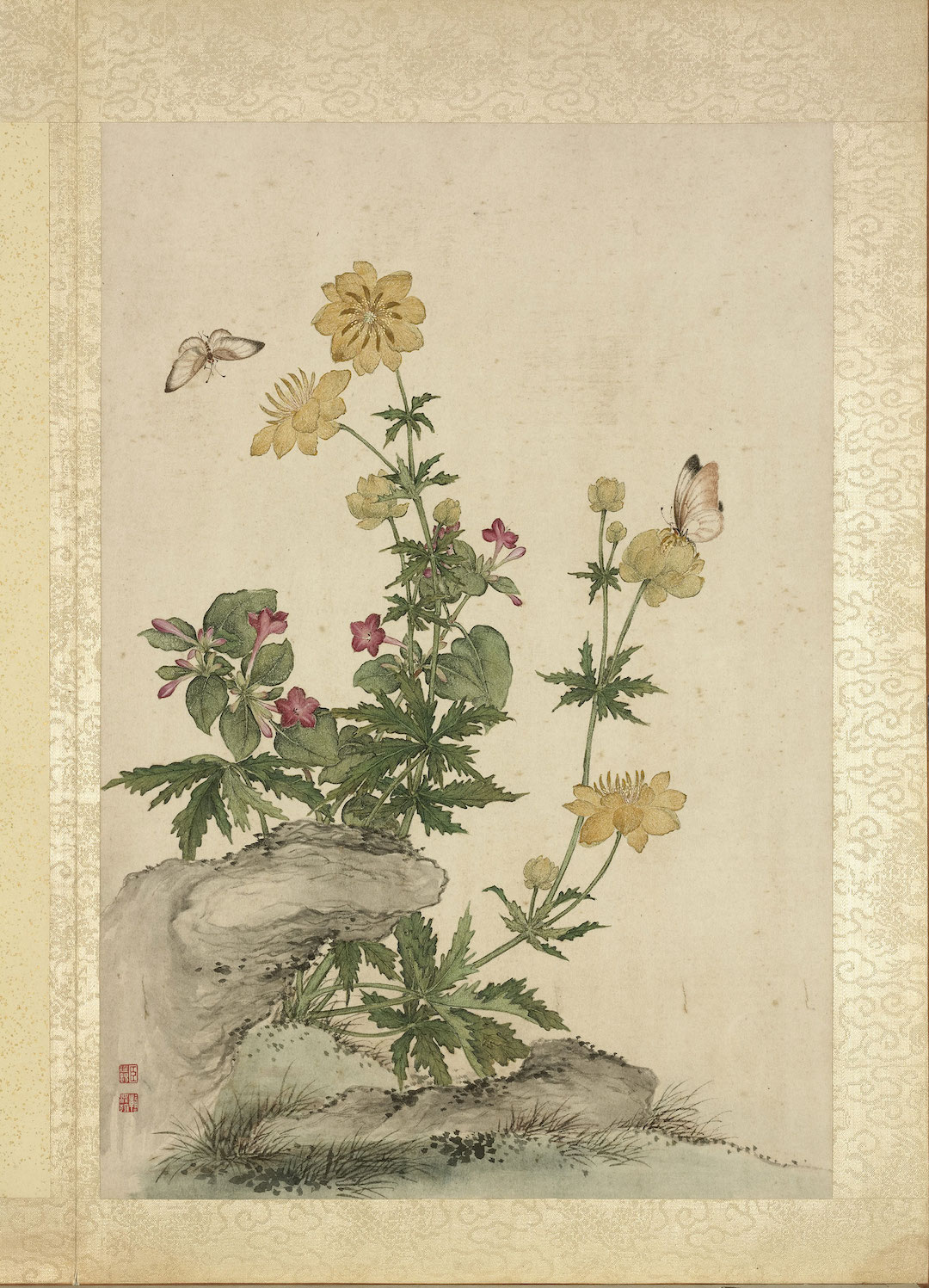
Qing Dynasty Jiang Tingxi's sketch (Golden Lotus and Jasmine) on paper
The painting depicts yellow and purple flowers. The yellow one is Trollius chinensis, which mainly grows in high altitude areas. It got its name because the flower shape is similar to the golden lotus flower of the Western Paradise in Buddhist legend. The small purple flower in the painting is Mirabilis jalapa, which is native to America and Africa.
After Emperor Kangxi paid homage to Mount Wutai in Shanxi Province, he transplanted the golden lotuses from the mountain to the South Garden of the Forbidden City and the Summer Resort outside the Great Wall, creating the "Golden Lotus Reflecting the Sun" in the "Thirty-six Scenes of the Summer Resort". Emperors Kangxi, Yongzheng and Qianlong all wrote poems with nasturtiums as the theme. It is speculated that because the color of nasturtiums is yellow, which is reserved for the royal family, it was deeply loved by the emperors.
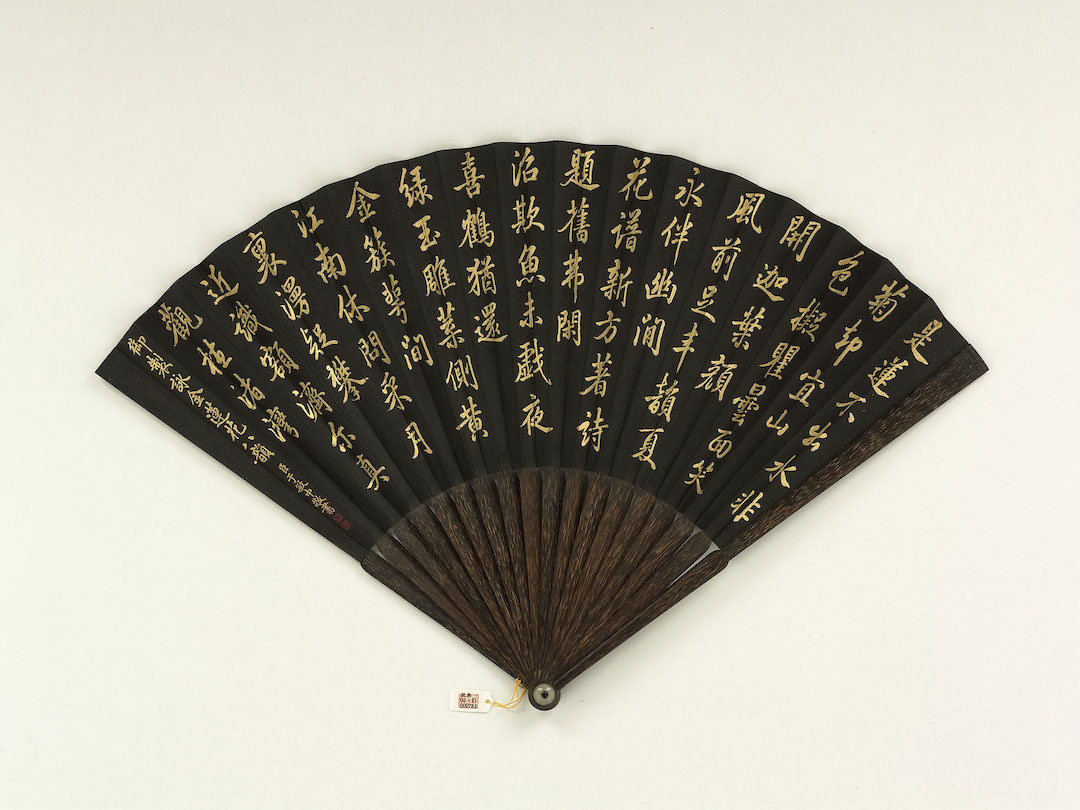
Qing Dynasty Yu Minzhong's regular script "Eight Rhymes of the Golden Lotus" made by Emperor Qianlong of the Qing Dynasty, paper version
The book inside the fan is Emperor Qianlong's (1711-1799) "Eight Rhymes of the Golden Lotus", written in the summer of the 39th year of Qianlong's reign (1774). In the poem, the yellow nasturtium is compared to Sakyamuni Buddha (also known as Huangmian Quㄑㄩˊ昙ㄊㄢˊ). The annotation mentions that records of golden lotus began in the Yuan Dynasty. Therefore, after the emperor learned that yellow lotus also grew in Turgut (now located between Xinjiang and Inner Mongolia), which he submitted to at that time, he speculated that it was the same flower.
The poem fan with black paper was written in gold by Yu Minzhong (1714-1779), a poet who was good at calligraphy. The running script lines are round, thick and straight, and the font structure is tilted to the upper right, similar to the style of Dong Qichang (1555-1636), the great calligrapher of the Ming Dynasty.

Drawing Thirty-six Scenes of the Summer Resort (Golden Lotus Reflecting the Sun) on paper
Chengde Summer Resort (formerly known as Rehe Palace) is located outside the entrance of the Great Wall. Emperor Kangxi (1654-1722) and Emperor Qianlong (1711-1799) would go to the villa to escape the summer heat from May to September and October. Go on autumn hunting outside the Great Wall, or meet with important figures in Mongolia, Tibet and other places.
This painting is "Golden Lotus Reflecting the Sun" from "Thirty-six Scenes of the Summer Resort", painted in the 16th year of Qianlong's reign (1752). This place is located in the Yanxun Mountain Pavilion on Ruyizhou Island and is filled with golden lotus flowers that Emperor Kangxi moved from Mount Wutai in Shanxi Province. The painting is painted with simple ink brushes. The nasturtiums planted in the garden are only painted with petals, but instead look like large lotus flowers.
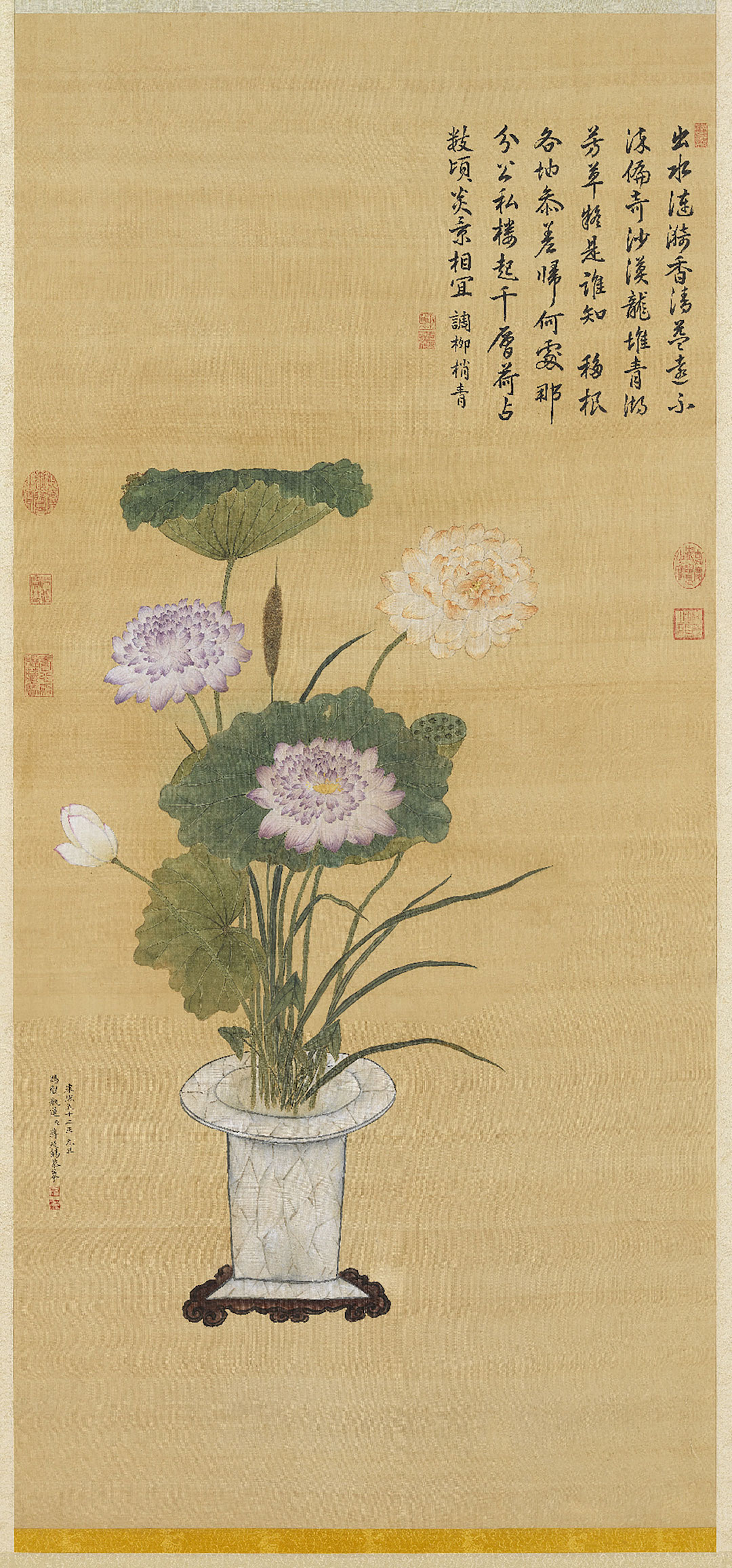
Qing Dynasty Jiang Ting pewter vase with lotus on silk
This painting was painted in the 52nd year of Kangxi (1713). It was a vase painted by Jiang Tingxi (1669-1732) that Emperor Kangxi (1654-1722) gave to his ministers on New Year's Day. There is a poem written by Emperor Kangxi on the upper right. The content is the same as the scene "Fragrance is far away and the beauty is clear" written by the emperor in "Thirty-six Scenes of the Summer Resort", implying that the lotus in the painting should belong to the more cold-resistant species outside the Great Wall.
There are three kinds of lotus flowers in the painting, which complement each other beautifully. White lotuses with reddish tips have a normal number of petals. The purple and orange lotus has a large number of petals and belongs to the "Thousand Leaf" variety. The purple lotus flower is also clearly divided into two different petals, large and small, as if there are small flowers inside the big flower. It is formed by the "petalization" of male and female pistils. It is also called the "Chongtai" lotus.
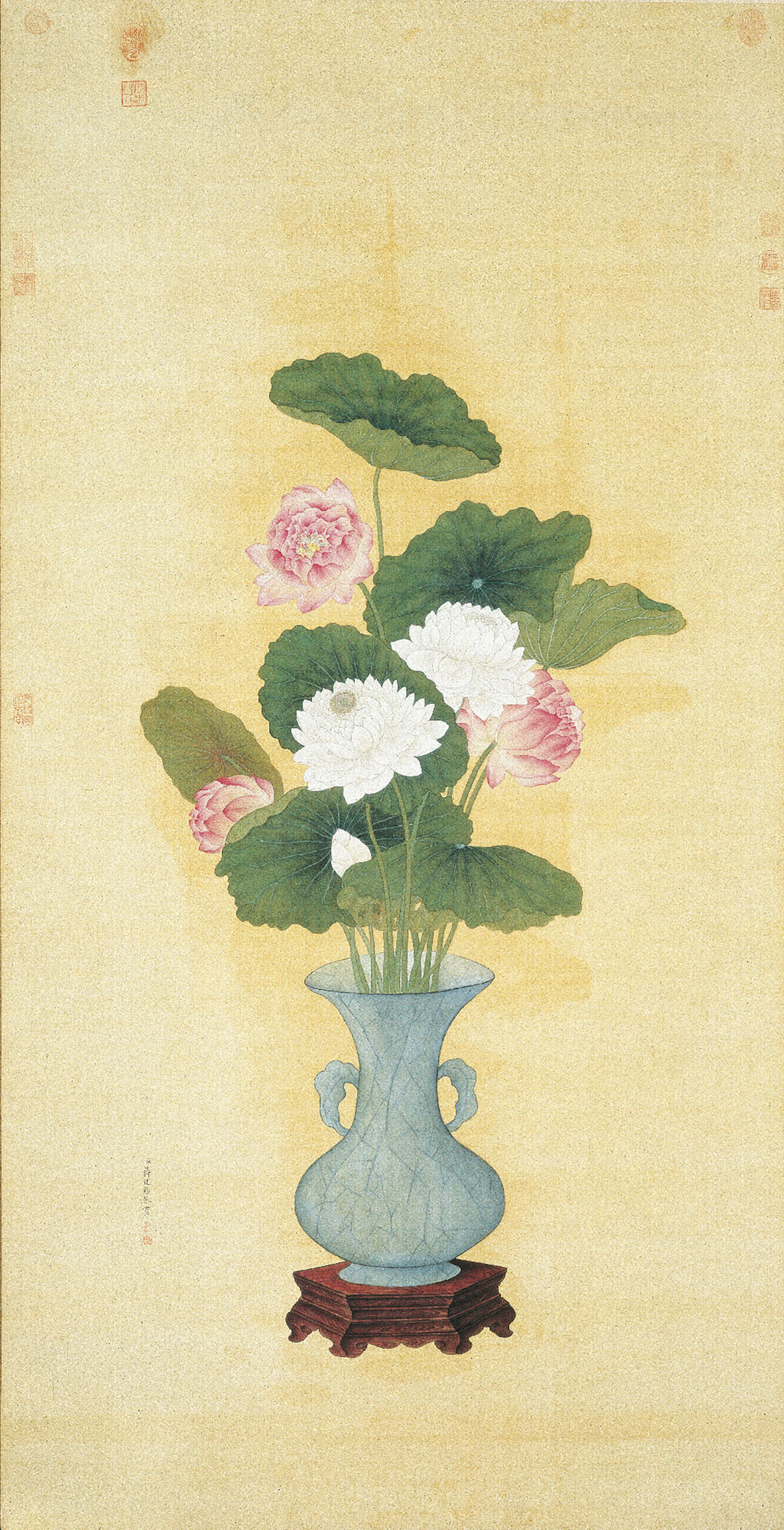
Qing Dynasty Jiang Tingxi painted vase with lotus on silk
This painting has no date and is only signed "Painted by Chen Jiang Tingxigong". It is a work dedicated to the emperor. The composition is similar to "Painting Aohan Thousand-leaf Lotus" painted by Jiang Tingxi (1669-1732) in the 61st year of Kangxi reign (1722). Since the vase and base have the Western chiaroscuro style, it should be a work from the same period.
There are white and pink lotus flowers in the painting, both of which have numerous petals. Among them, the white lotus stamens are all turned into petals, which belongs to the "Chongtai" variety. Aohan is a Mongolian tribe. According to the Qianlong Dynasty's "Qin Ding Rehe Zhi", the lotus imported from Aohan in the Summer Resort can still bloom in autumn even if the weather outside the Great Wall is cold, and it is a fairly cold-resistant flower.
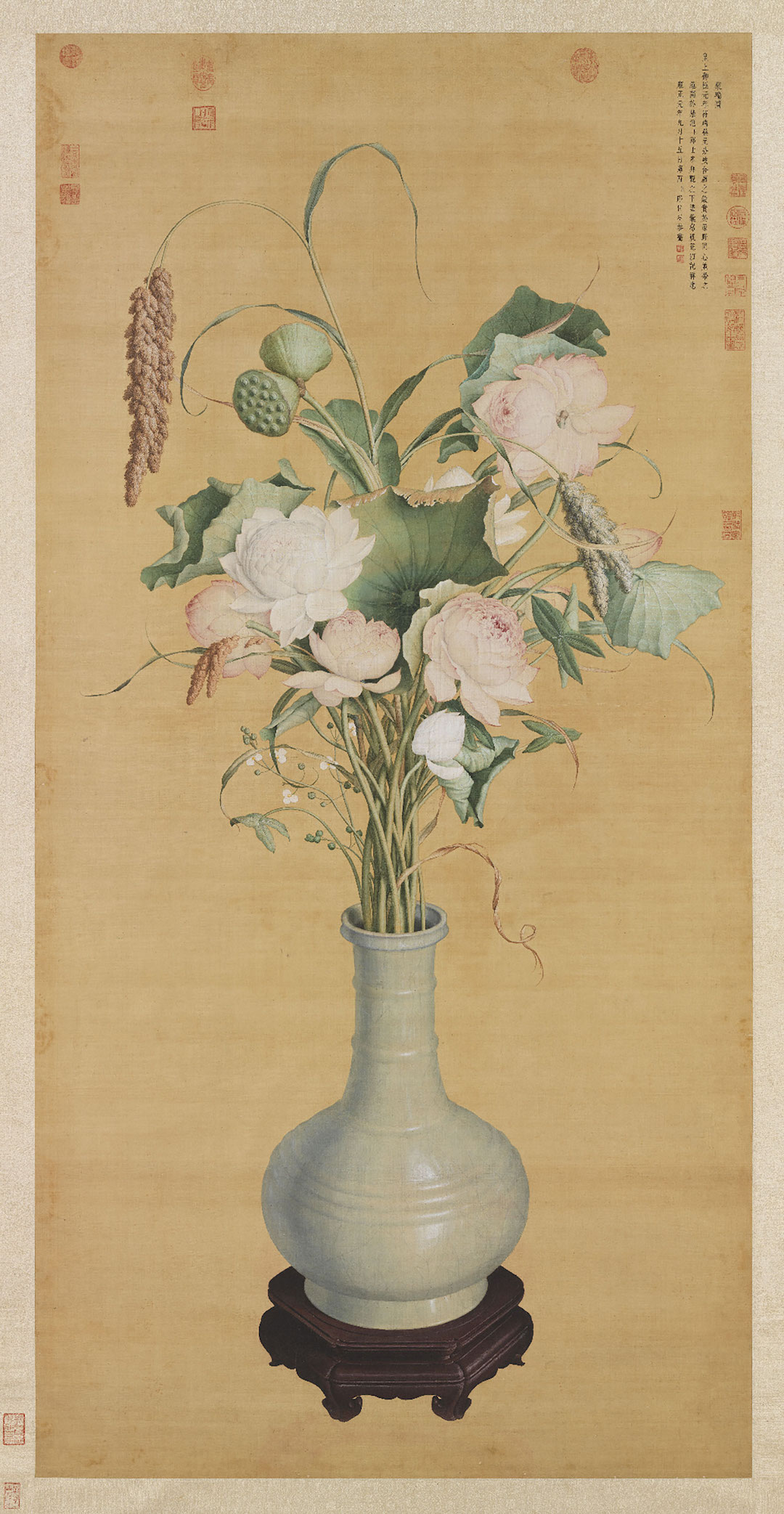
Qing Dynasty Lang Shining's "Ju Rui Tu" on silk
Giuseppe Castiglione (1688-1766) was an Italian missionary painter who served as a painter from Kangxi to Qianlong for fifty-one years. This painting was painted in September of the first year of Yongzheng (1723), using the "Hercynian method" that emphasizes light and dark light and shadow. The bottle body, base and plant edges of the celadon string-pattern bottle are all highlighted with white paint to increase the three-dimensionality and gloss of the object.
In the painting, there are plants such as double lotus, double-peduncle lotus, lotus canopy, and double-headed rice ears. Judging from the month of painting and the numerous petals, it should be the Thousand-leaf Lotus outside the Great Wall. The inscription and postscript mention that the lotus flower on the vase bloomed in the royal forbidden pond. This shows that after the lotus transplanted from Mongolia mutated into a double flower, it became an auspicious symbol for the new emperor's enthronement.
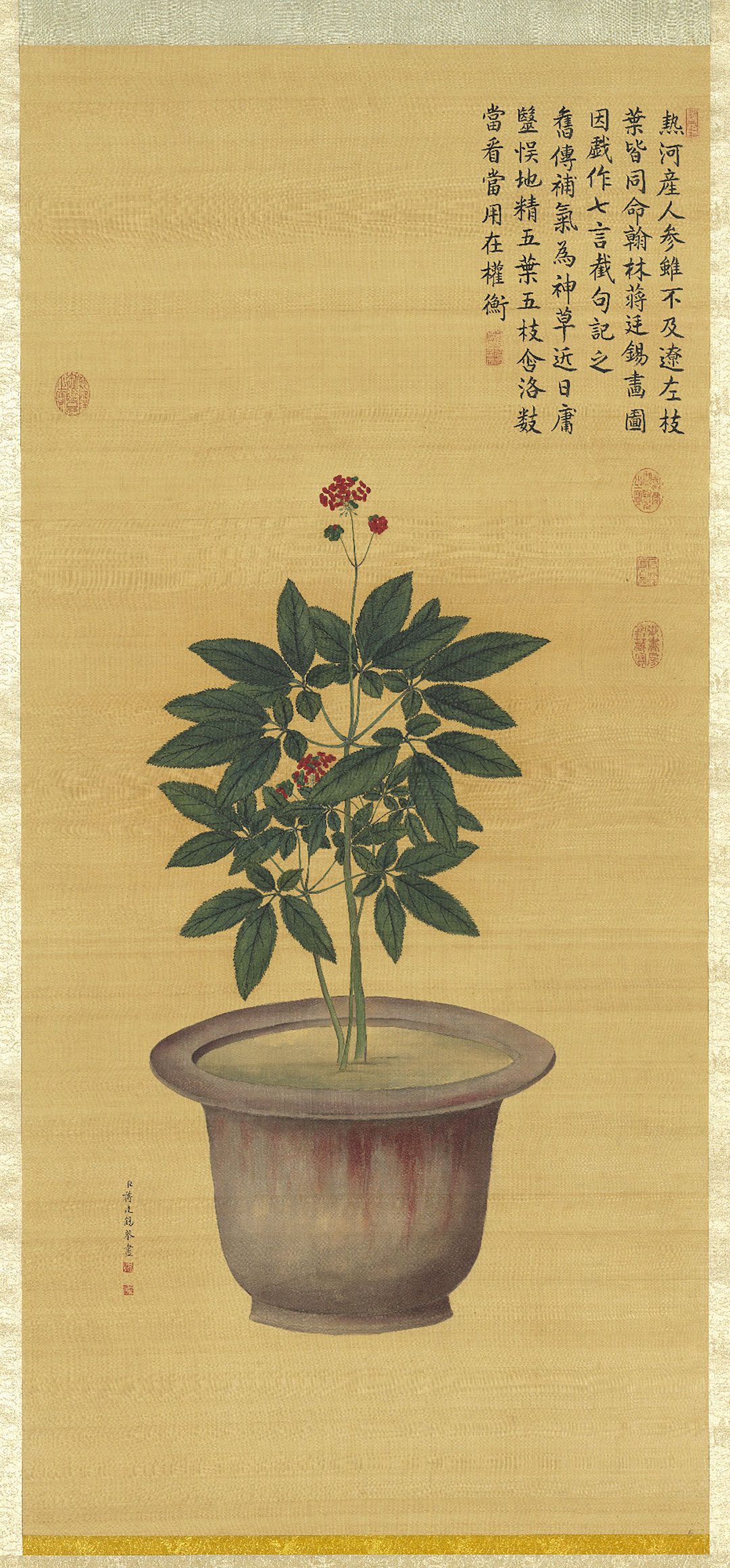
Qing Dynasty Jiang Tingxi's ginseng flower silk edition
This painting uses the boneless method to paint the ginseng bonsai at the Chengde Summer Resort. The artist tried to use the depth of color to paint the light and dark of the flower vessel. The ginseng leaves are spread out neatly, with the front facing the viewer, and the serrated edges of the leaves are carefully depicted. There is an oil version of the same composition painted on Korean paper by the court painter Bandarisa (birth and death unknown).
Emperor Kangxi (1654-1722) wrote a poem in the fifty-second year of Kangxi (1713), commenting that the quality of Rehe ginseng was not as good as that of its origin (Liaodong Peninsula in Northeast China), but the number of branches and leaves were all "five leaves and five branches", which has the Luoshu Number graphics are fun centered around the number five. Finally, it is emphasized that although ginseng is considered a sacred herb, it must still be used with caution.

A picture of Zhang Ruoai's summer resort in the Qing Dynasty and a poem written by Qianlong (The fragrance is far away and the fragrance is clear, the fragrance of lotus in Qushui) on silk
Zhang Ruoai's (1713-1746) "Summer Resort Pictures and Qianlong's Poems" consists of four volumes. Each scene is accompanied by a poem written by Emperor Kangxi (1654-1722) and Emperor Qianlong (1711-1799). The compositions of this exhibition "Fragrance is far away and the fragrance is clear" and "Lotus Fragrance in Qushui" are very similar. Next to the main building, there is a pavilion built on the waterway. It is connected to the lotus pond through the winding waterway, where literati can hold events while drinking and writing poems. "Qushui Shang" activity.
Lotus, also known as lotus, is a common flower in summer. Emperor Kangxi once introduced lotus to the lake area of the summer resort, making it known as "Jiangnan beyond the Great Wall". "Xiangyuan Yiqing" mainly transplants famous lotus species from the north and south, while "Qushui Hexiang" specializes in planting lotus grown from Aohan Banner in Mongolia, which is a cold-resistant variety that only blooms in autumn.
southern flowers
Every month, Jiangnan Weaving dispatched water transport ships to transport royal items made in the south and seasonal flower bonsais to the palace. Therefore, in the Qing Dynasty, the Forbidden City had a "South Garden" to conserve flower bonsais from various places. In addition to having gardeners who specialize in taking care of plants, they even set up greenhouses (greenhouses) to burn charcoal to grow southern flowers. These flower bonsais will be placed according to the seasons of plant growth for the royal family to enjoy.
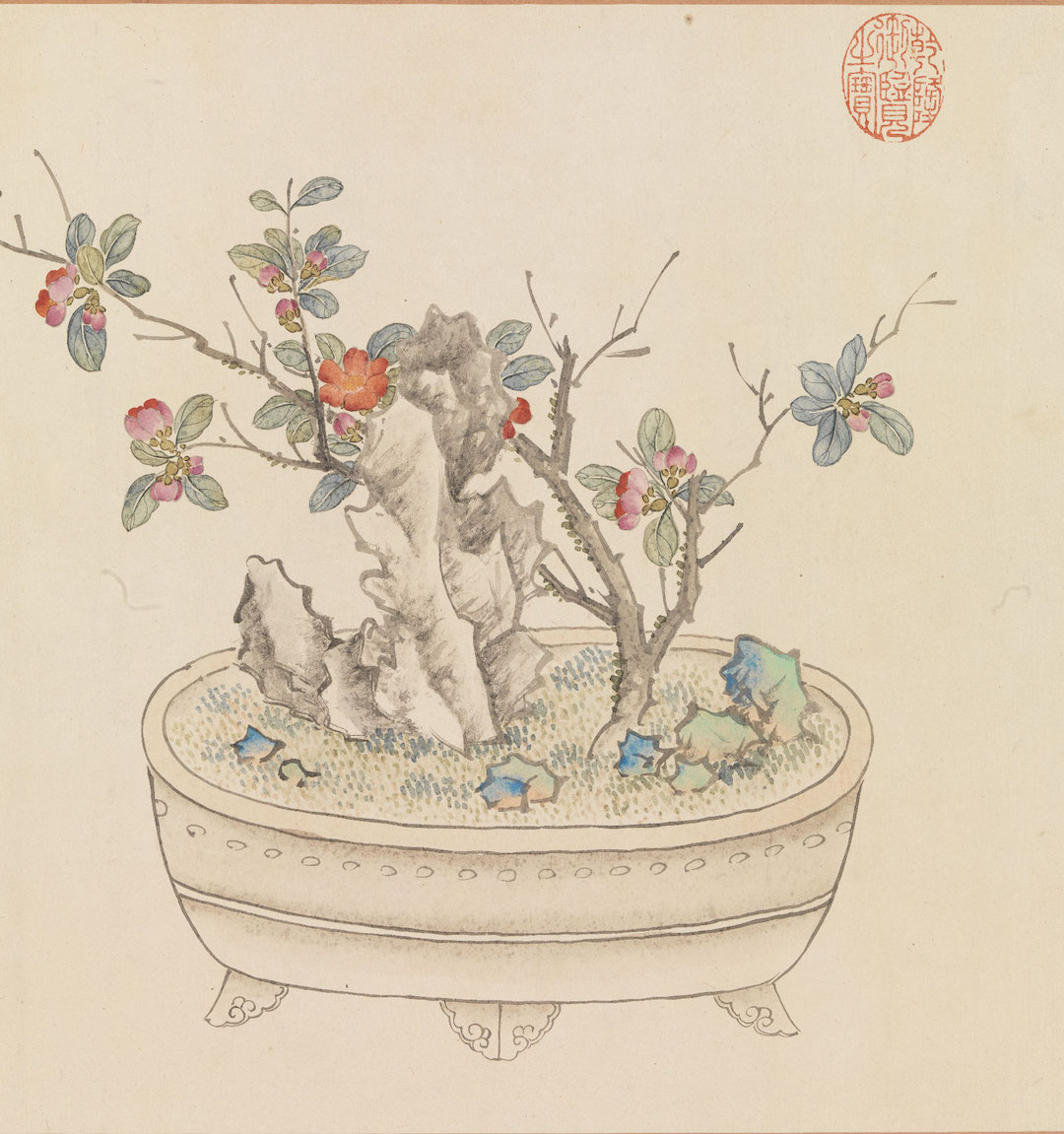
Qing Dynasty Wang Chengpei's Painting of Ten Thousand Years Sixty Flowers on Paper (Part)
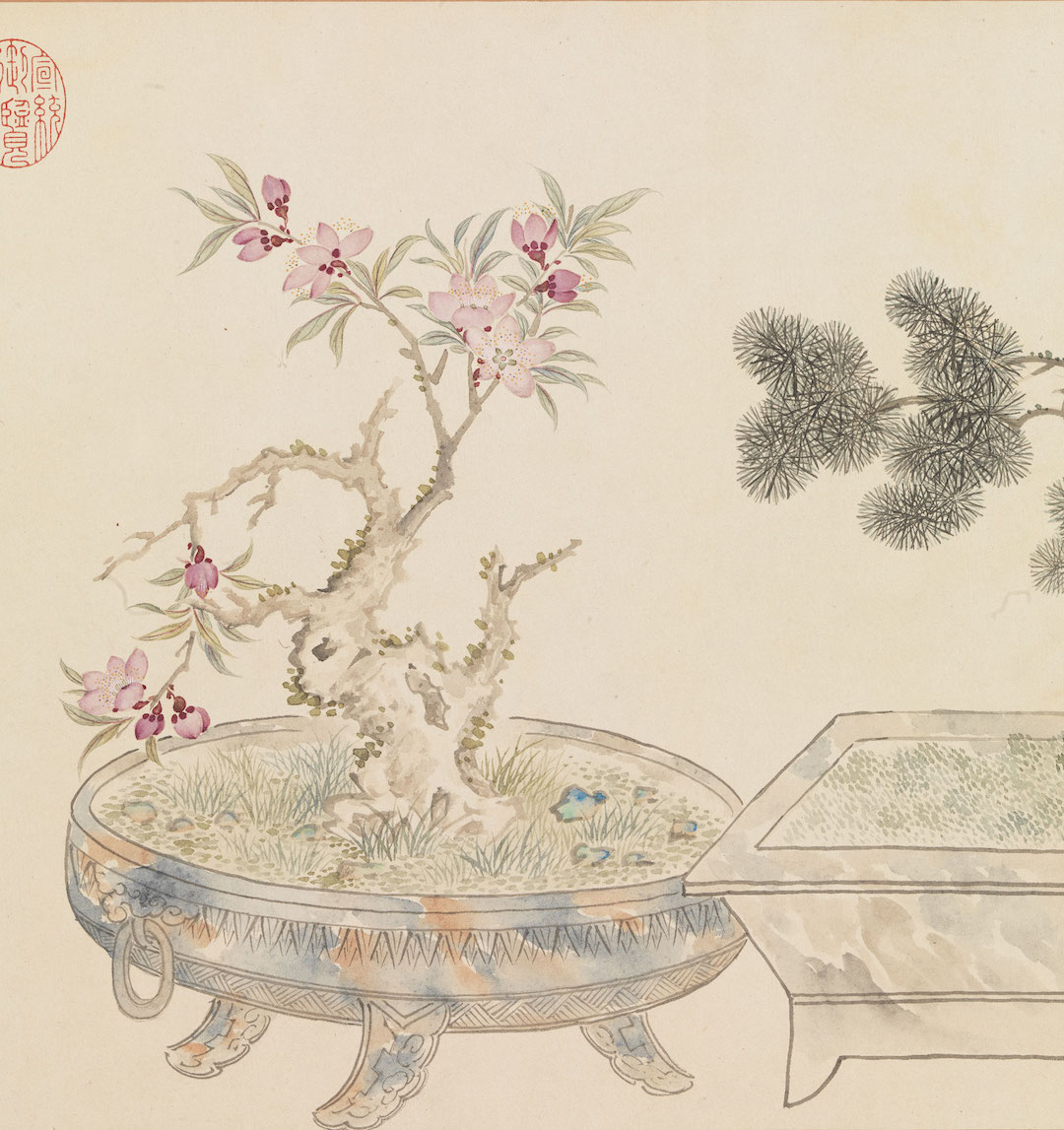
Qing Dynasty Wang Chengpei's Painting of Ten Thousand Years Sixty Flowers on Paper (Part)
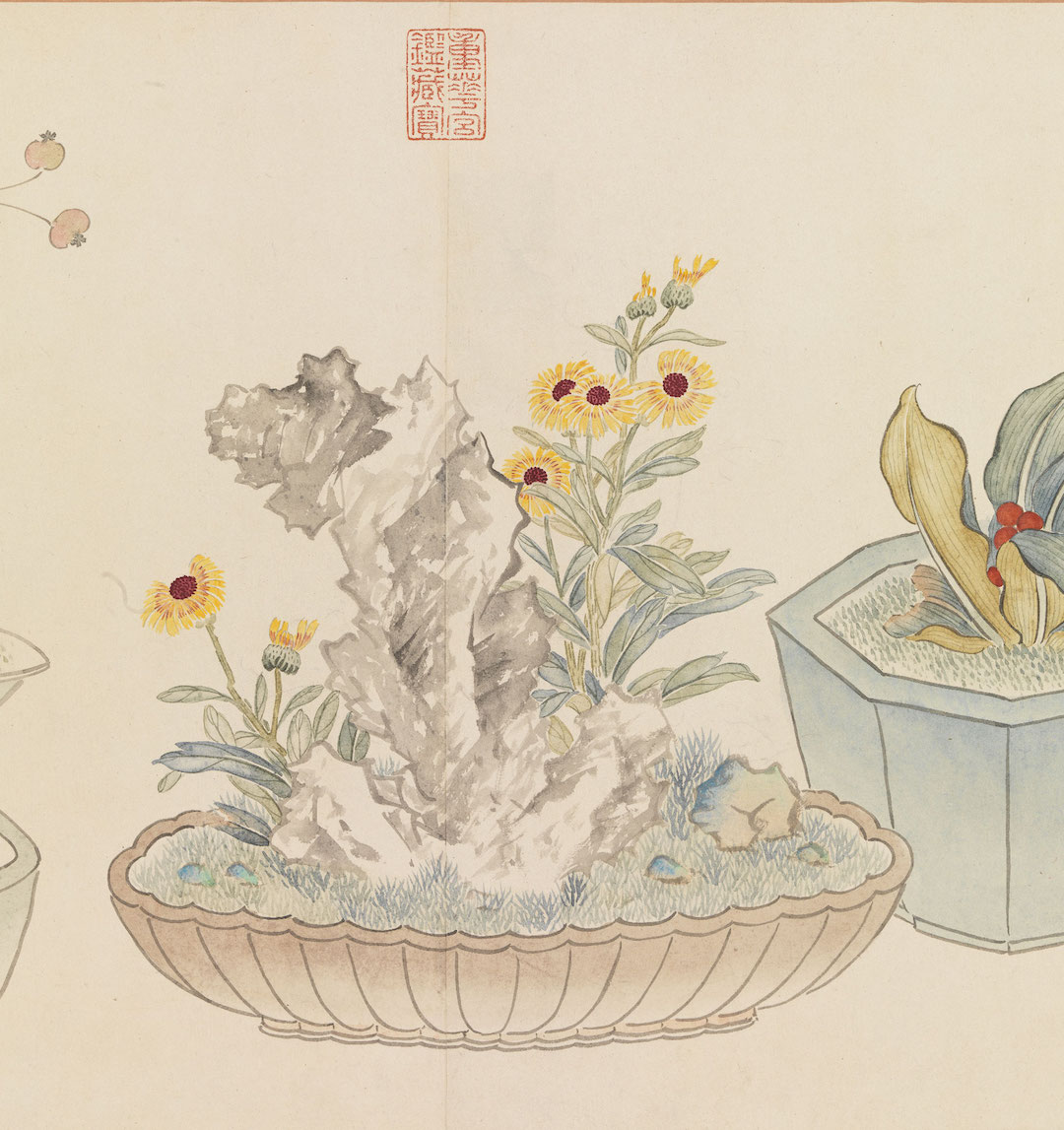
Qing Dynasty Wang Chengpei's Painting of Ten Thousand Years Sixty Flowers on Paper (Part)
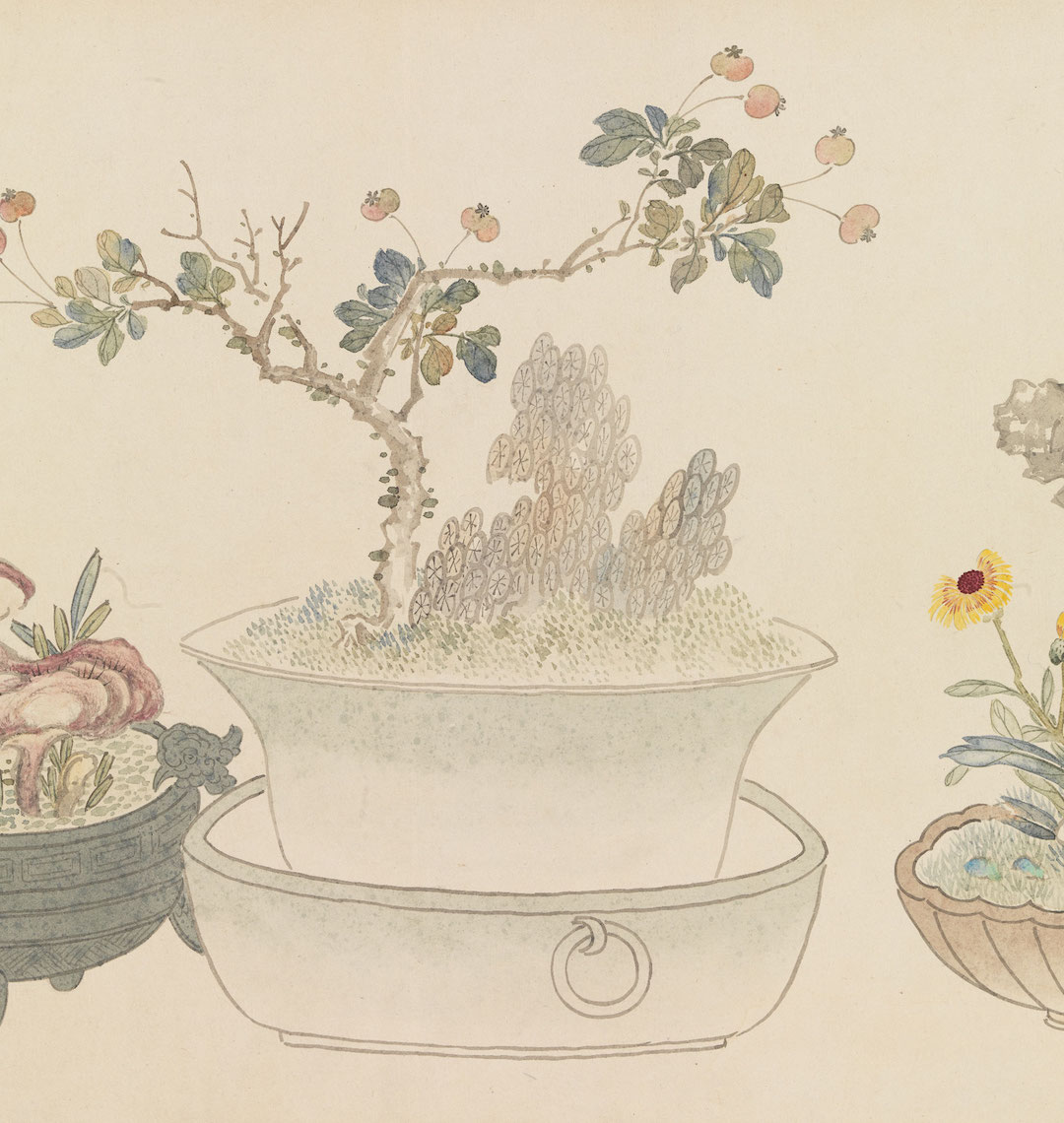
Qing Dynasty Wang Chengpei's Painting of Ten Thousand Years Sixty Flowers on Paper (Part)
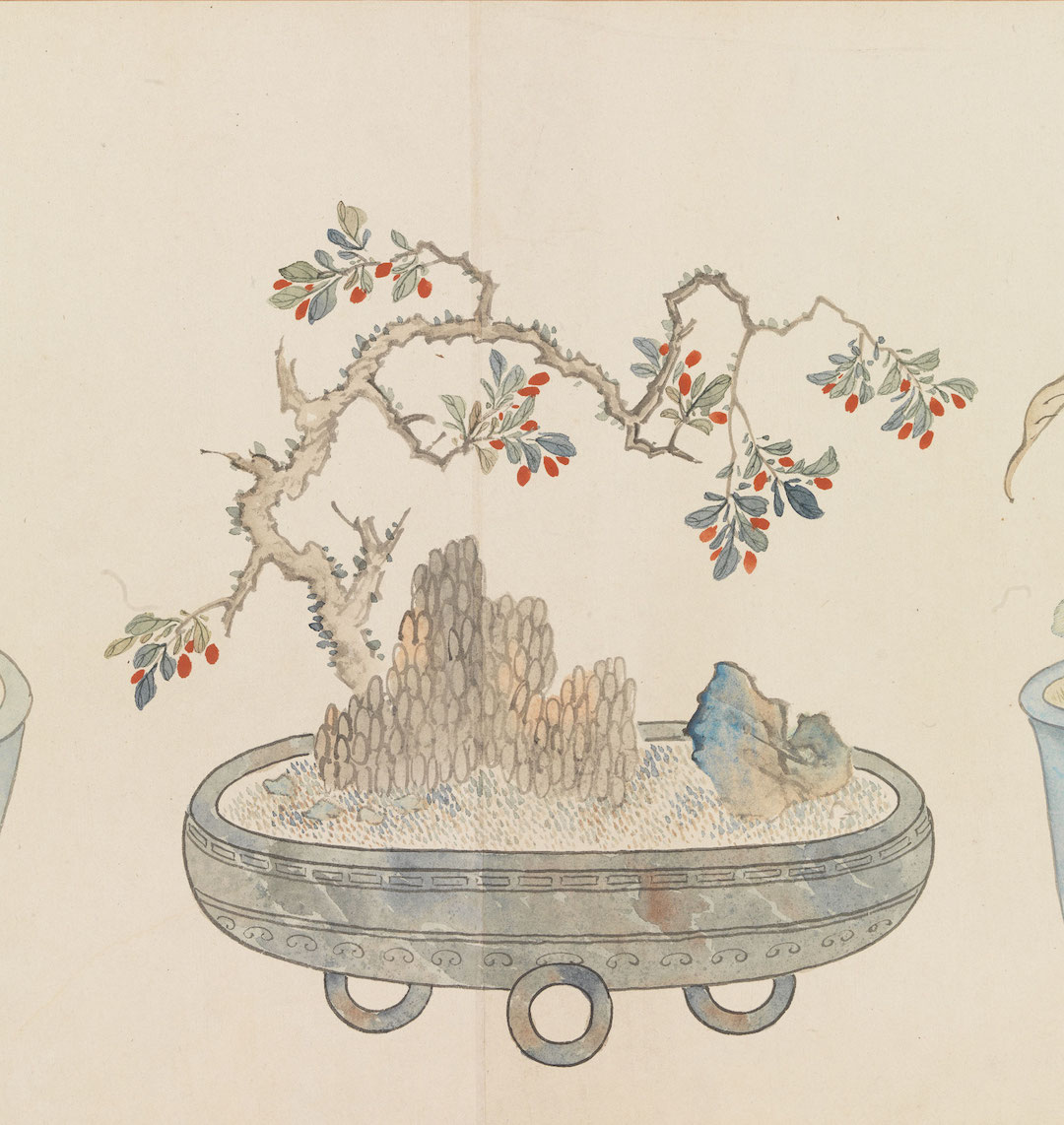
Qing Dynasty Wang Chengpei's Painting of Ten Thousand Years Sixty Flowers on Paper (Part)

Qing Dynasty Wang Chengpei's Painting of Ten Thousand Years Sixty Flowers on Paper (Part)
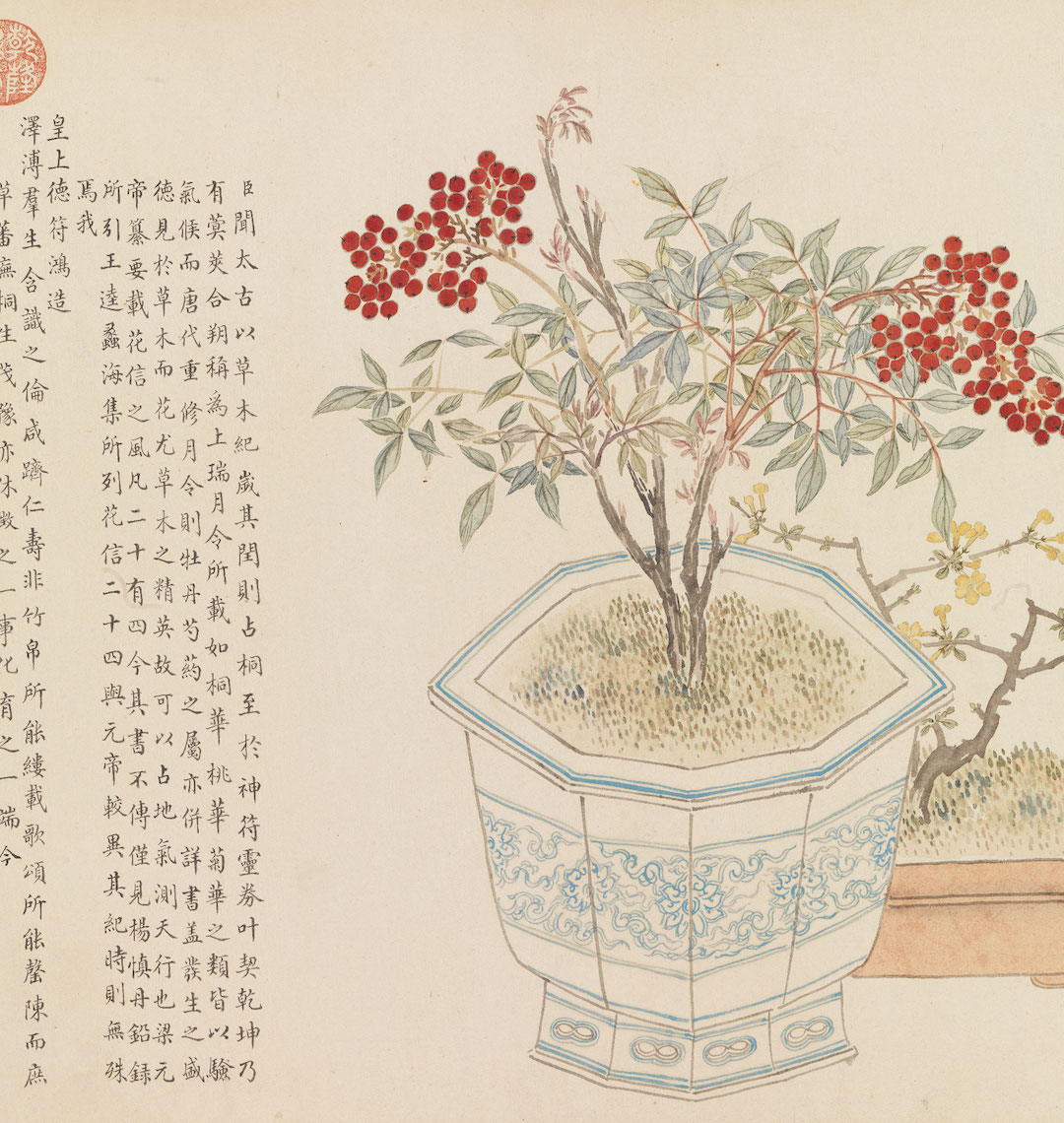
Qing Dynasty Wang Chengpei's Painting of Ten Thousand Years Sixty Flowers on Paper (Part)
"Painting Ten Thousand Years of Flowers" was written by the poet Wang Chengpei (?-1805), who painted twenty-four types of bonsais. They used porcelain, bronze, shells and other different materials to place various flowers and trees, and added strange stones to embellish them, creating a "pot" scenery". In the painting, flowers of different flowering periods in four seasons are in full bloom at the same time, which has the meaning of "a hundred flowers are auspicious" and symbolizes a peaceful and prosperous age.
According to the inscription at the end of the volume, the painting was completed after the emperor's sixth southern tour in the 49th year of Qianlong's reign (1784). On the way, the emperor learned that he was blessed with a great-great-grandson, making him a rare five-generation emperor. Therefore, the title of the painting combines "Emperor Ten Thousand Years" and "Sixty Years Old", which means wishing the emperor good health and longevity.

Qing Dynasty Jiang Tingxi Osmanthus on silk
This painting was created by the poet Jiang Tingxi (1669-1732), who used the boneless method to paint the broken branches of osmanthus. He deliberately left white space where the objects overlapped, and the leaves cleverly rendered the color changes, so the osmanthus has a clear feeling.
The painting is not dated, but in the upper right corner is the poem "Looking at the Moon during the Mid-Autumn Festival" written by Emperor Kangxi (1654-1722), expressing his experience of appreciating red osmanthus during the Mid-Autumn Festival. Since the emperor mostly spent the Mid-Autumn Festival at his summer resort in his later years, it is speculated that this painting commemorates the osmanthus viewing at the mountain resort. "Qin Ding Rehe Zhi" records that the osmanthus bonsai in the summer resort were all transplanted from the south, echoing the poem's mention of the moonlight shining selflessly in remote places.

Qing Dynasty Jiang Tingxi's sketches of flowers and birds on paper
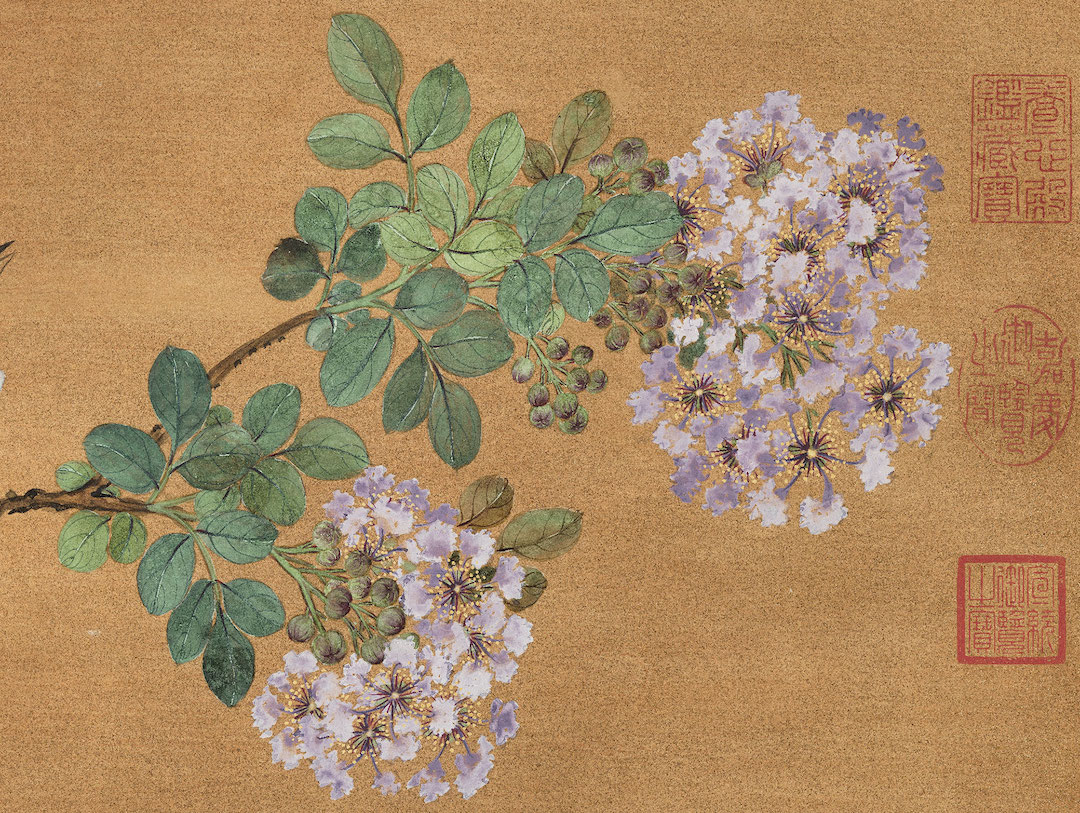
Qing Dynasty Jiang Tingxi's sketches of flowers and birds on paper (partial)
The painting depicts crape myrtle and chrysanthemums in full bloom, and a Pulsatilla bird singing with its head slightly raised in the tree. There are lake rocks under the trees, suggesting that this scene is an artificial garden.
This painting is made on gold paper, and except for the trees and rocks, all the paintings are made of paint with strong coverage. On the upper right is a poem "Ziwei" written by Emperor Kangxi (1654-1722) by Feng Qi (1558-1603) of the Ming Dynasty. It mentions that crape myrtle was produced in Zhejiang in the south and was transplanted to the study by the poet. The emperor quoted this poem, perhaps referring to the crape myrtle in the painting being transplanted to the court.
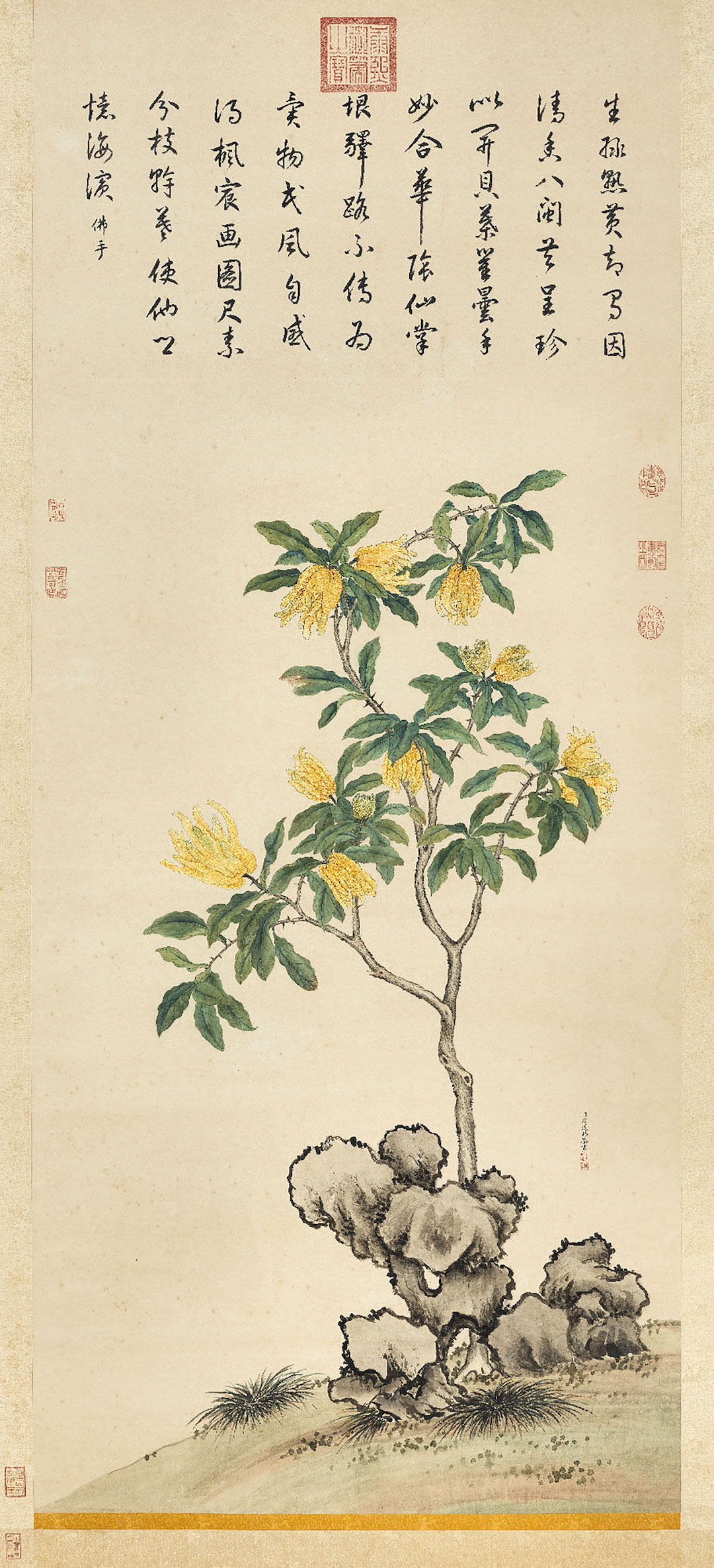
Qing Dynasty Jiang Tingxi Buddha's handwriting on silk
This painting depicts a bergamot tree growing on a slope. It has produced bergamot fruits with a rough surface, and the branches are realistically characterized by spikes. Lake rocks are used as a backdrop under the tree, suggesting planting in an artificial garden. Above the painting is the poem "Buddha's Hand" written by Emperor Kangxi (1654-1722) in the 54th year of Kangxi's reign (1715). The poem refers to the fact that the Buddha's hand was originally a tribute plant from Fujian (now Fujian Province) and was later transplanted to the palace.

Qing Dynasty Jiang Ting Xi Yue Lai Incense Silk Edition
This painting was painted in June of the fifty-seventh year of Kangxi's reign (1718). In the painting, moonflowers are fixed with bamboo branches in a brown porcelain pot, allowing the flowers and leaves to cling to them and grow. The shape of this pot is similar to the brown-bottom purple-glazed pot in "Ginseng Flower", and it should be a fixed style for transplanted plants in the palace.
The small five-petal flower in the painting belongs to an "umbrella (ㄙㄢˇ)-shaped inflorescence", with flower stalks of equal length radiating from the top of the flower axis, shaped like an umbrella rib, and should be what is known in modern times as Cestrum nocturnum. "Illustrated Research on Plant Names and Facts" records that tuberose has also been transplanted in the north, but because the plant is afraid of cold, it mainly grows in the warm southern Fujian and Guangdong areas (today's Fujian and Guangdong).
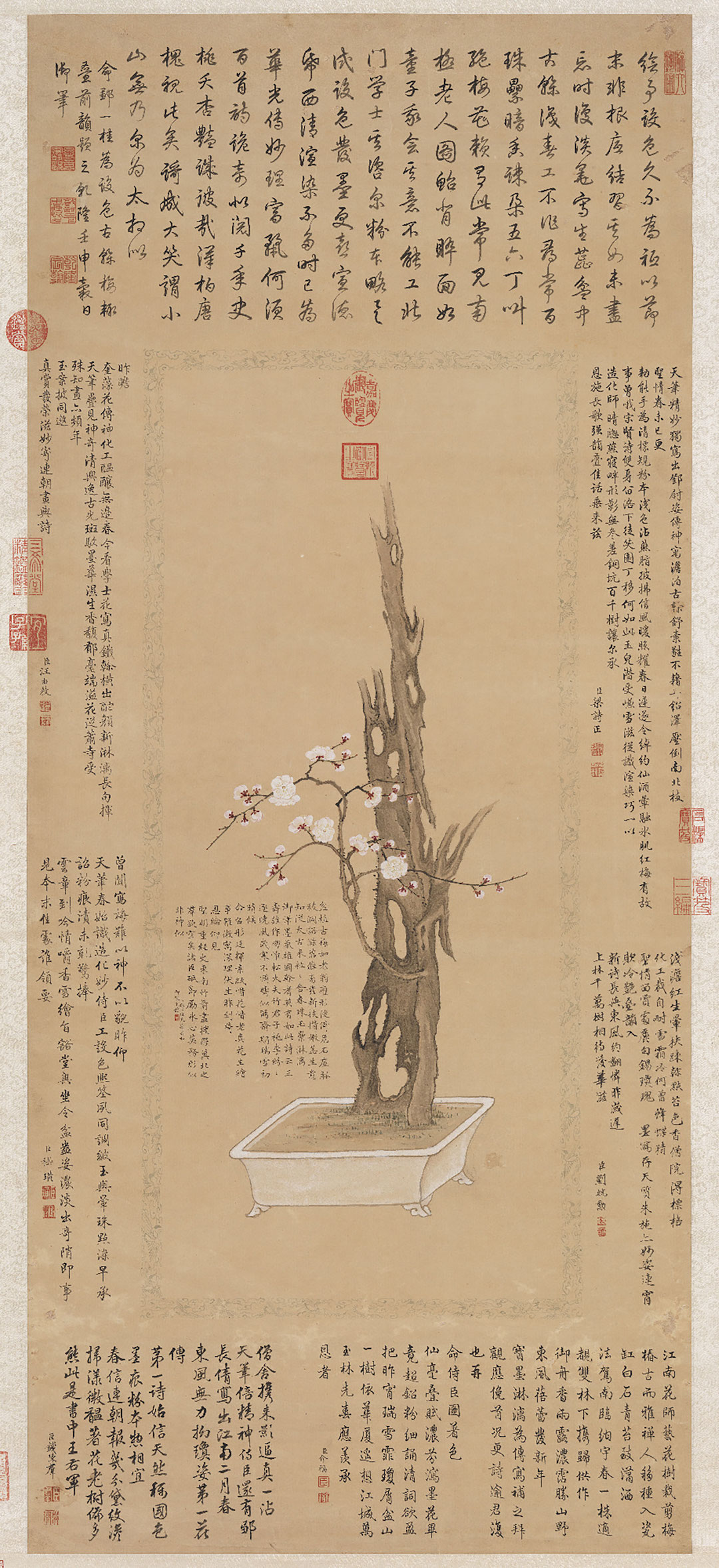
Qing Dynasty Zou Yigui's painting of ancient dried plum on paper
Emperor Qianlong (1711-1799) made his first southern tour (1751) and moved the ancient plum blossoms from the Suzhou Monk Temple to the Old Summer Palace, where they bloomed early the following New Year. The emperor therefore painted "Ancient Dry Plum with Royal Brushstrokes" in ink, and ordered Zou Yigui (1686-1772) to use tribute imitation Xuande paper to draw a color version. He also recruited lyricists to write poems and chants on the painting.
This painting shows an ancient plum bonsai cultivated in the palace greenhouse. The dead tree is placed in a white flower pot, with new branches sprouting from the side and pink plum blossoms blooming one after another, which has the auspicious meaning of "rejuvenation of dead wood".

Qing Dynasty Dong Gao's painting Jing Yixuan plum blossoms on paper
The building in the painting is the Jingyi Pavilion in the Jianfu Palace Garden. The courtyard is decorated with a sundial, an armillary sphere, a cauldron, and four ancient plum trees are planted. "Plum Blossoms in Front of Jing Yixuan" on the upper left was painted in the 39th year of Qianlong's reign (1774). The poem first mentions the climate difference between the north and the south. Since the north warms up later, the plum blossoms in the south are about to bloom when the plum blossoms in the south are already bearing fruit. Later, he lamented that the plum blossoms in pots, which require artificial ripening with charcoal fire, could not bloom naturally compared to the plum blossom trees that were only kept warm by a shed. This highlighted that the plum blossoms transplanted by the palace had adapted to the soil and water of the north.
Plum blossoms in the north are mainly potted plants. In the early years of Qianlong's reign, plum blossoms were transplanted to the Jingyixuan courtyard and cultivated successfully. Emperor Qianlong (1711-1799) wrote poems many times mentioning this matter, and seemed quite proud of it.
seasonal flowers
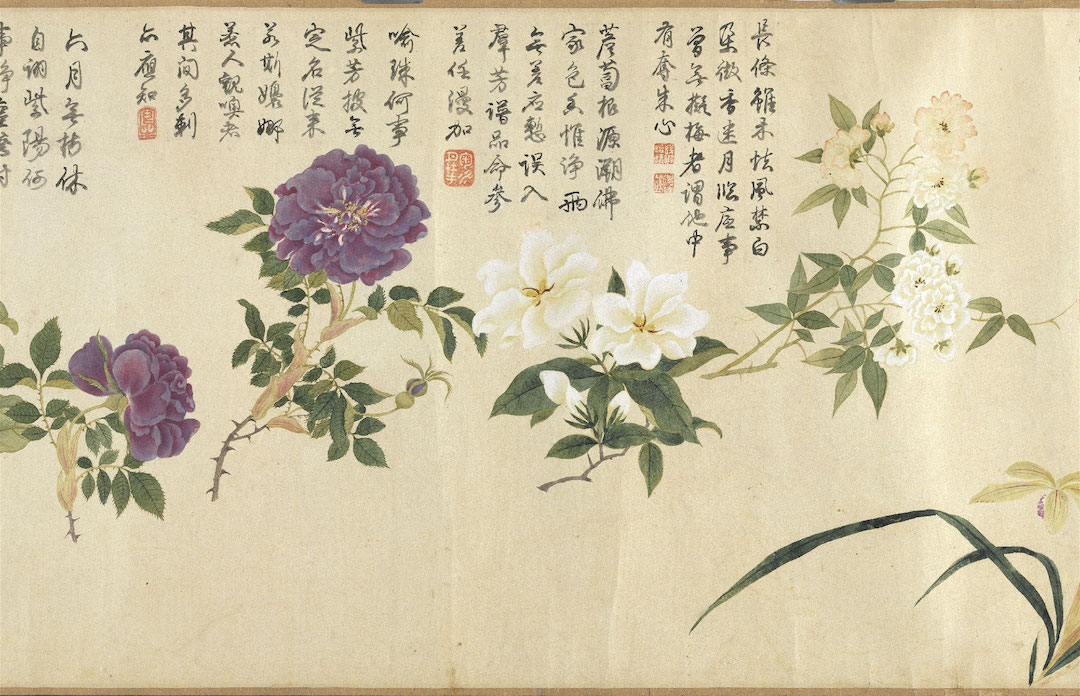
Qing Dynasty Wang Chengpei Chunqi collection paper (partial)
This painting is a long scroll of about forty kinds of flowers painted by the poet Wang Chengpei (?-1805). It was painted before the emperor's sixth southern tour in the forty-ninth year of Qianlong (1784). The flowering periods of the plants in the painting cover the four seasons. Through the blooming of flowers in different seasons, they praise the prosperity and peace of the empire.
In addition to common seasonal flowers such as peonies, lotus, chrysanthemums and plum blossoms, the paintings also include wild flowers beyond the Great Wall such as hypericum and delphiniums, as well as exotic flowers such as passion flowers, carnations and iris. Traditional Chinese flowers, flowers outside the Great Wall and foreign flowers are placed in the same volume, representing the flourishing species of the empire.
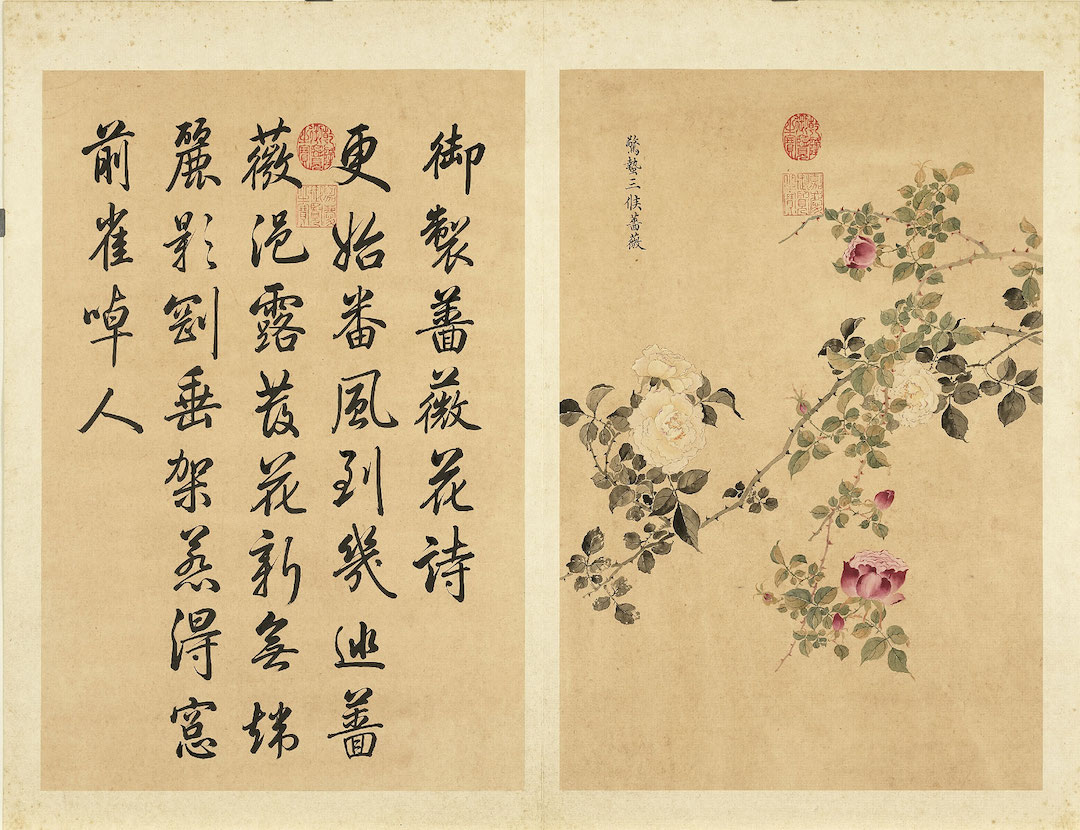
Qingyu Province Mo Miaozhulin paper (partial)
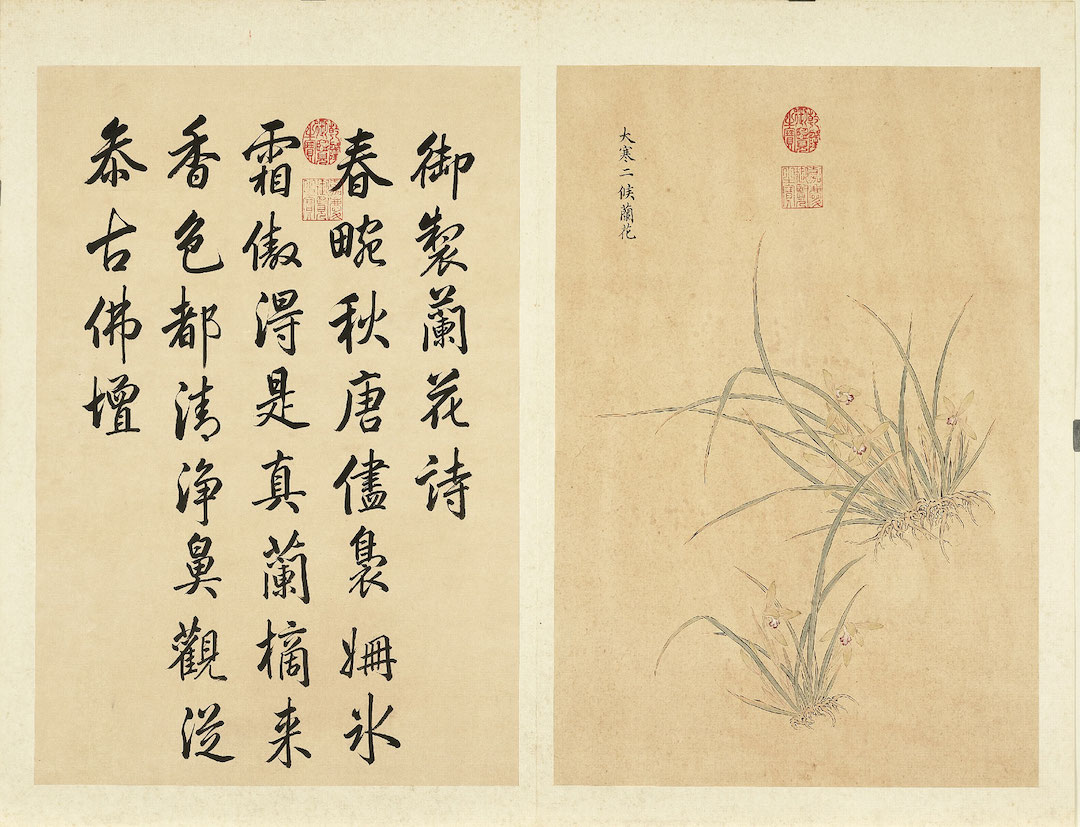
Qingyu Province Mo Miaozhulin paper (partial)

Qingyu Province Mo Miaozhulin paper (partial)
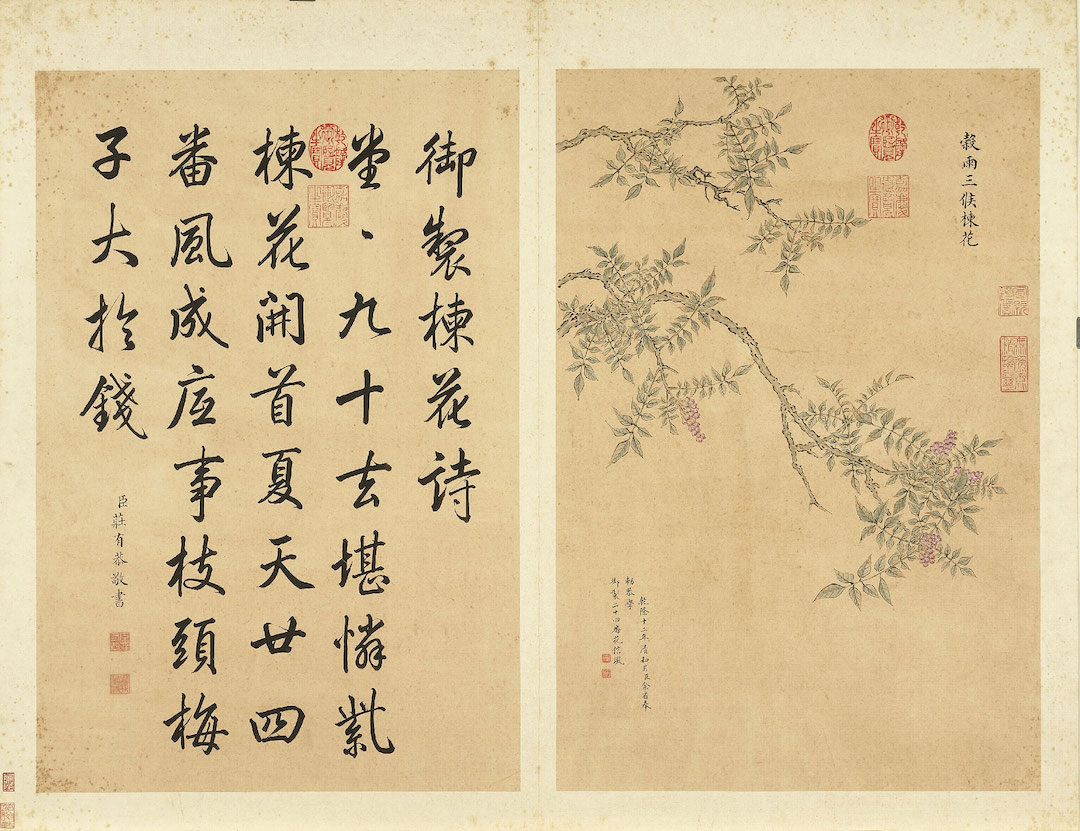
Qingyu Province Mo Miaozhulin paper (partial)

Qingyu Province Mo Miaozhulin paper (partial)
There are twelve volumes of "Mo Miao Zhu Lin" in the Qianlong Dynasty. Among them, "Twenty-Four Flowers and Trade Winds" were drawn by Yu Sheng (1692-1767) and inscribed by Zhuang Yougong (1713-1767). The theme of this painting ranges from Xiaohan in the twelfth lunar month to Grain Rain at the end of March. Each solar term is further divided into three periods, with a total of twenty-four types of flowers. According to the inscription and postscript, it can be seen that the original manuscript is "A Combination of Paintings, Calligraphy and Sketches Made by the Wind", which was painted and composed by Emperor Qianlong (1711-1799) himself.
This exhibition selects five works with different painting methods, including pure ink brush, boneless or double-hook coloring. "Rose" even places ink and color flowers on the same screen, demonstrating the artist's ability to interpret various painting techniques.
A flash in the pan - foreign flowers from afar
"Foreign flowers" specifically refers to flowers from the West, which were also a theme often depicted in Qing palace paintings and utensil decorations. After foreign flowers are introduced, they will be given more poetic names according to traditional flower naming habits. As for the actual variety classification, it is necessary to further analyze the appearance, characteristics and habits, compare flowers with similar conditions, and incorporate them into the traditional plant classification system.
The rare foreign flowers that traveled across the ocean required the careful care of gardeners or Western missionaries. If it cannot be successfully reproduced locally, it will not be easy to introduce it from other places. These flowers may be "ephemeral", but fortunately, the court painters preserved them permanently in paintings and became precious visual records.
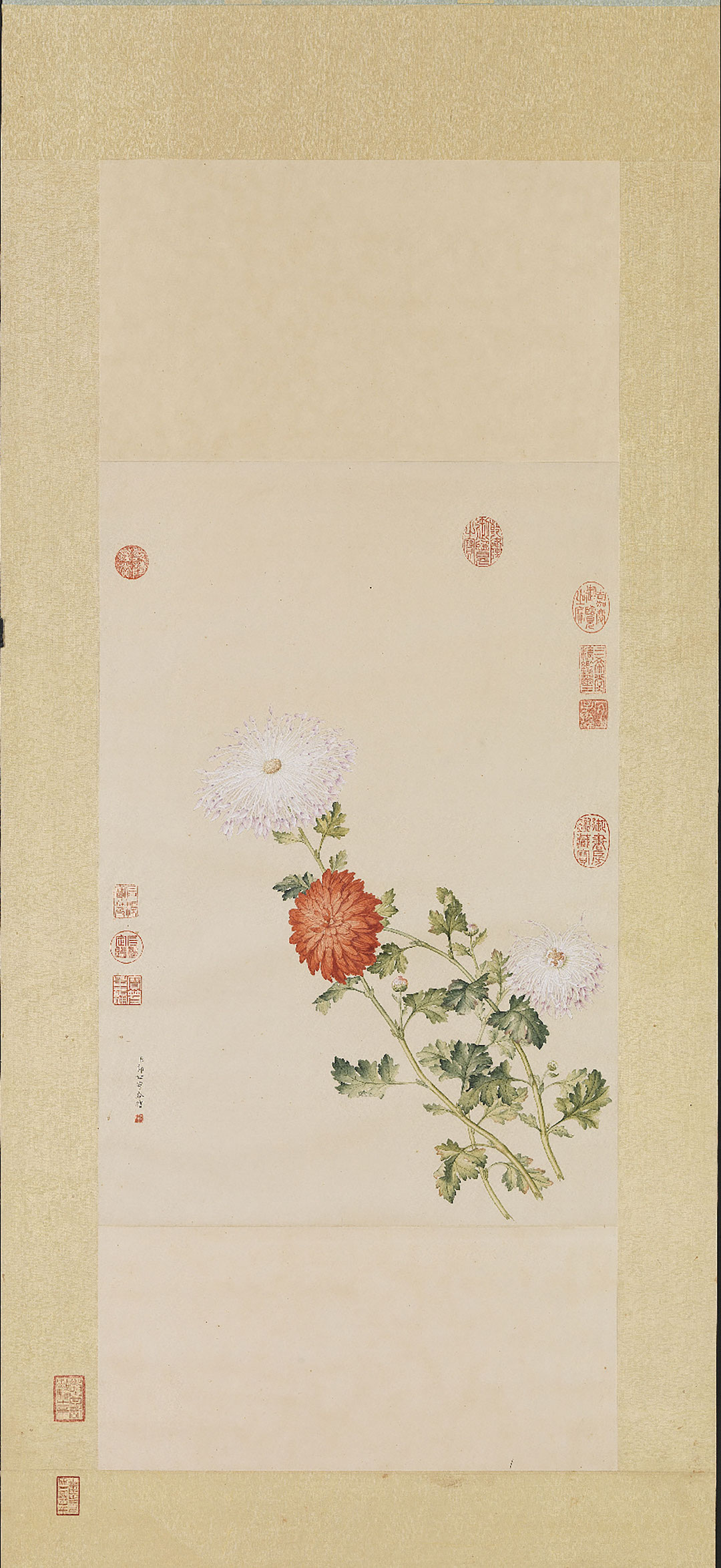
Qing Dynasty Lang Shining's painting of chrysanthemums on paper
"Chrysanthemum" is the general name for exotic chrysanthemums. Emperor Qianlong wrote poems about chrysanthemums many times, and once wrote: "It is originally grown in Dongli, but who calls it Maohaixi?" "Hercynian" refers to Europe. At that time, court painters who were good at painting flowers used chrysanthemums as their themes to record these uniquely shaped chrysanthemums.
This painting is a painting of broken chrysanthemums by Giuseppe Castiglione (1688-1766), or it may be "a scroll of chrysanthemums painted by Castiglione on paper" recorded in the "Working Documents" of the 23rd year of Qianlong's reign (1758). The flowers in the painting are thickly coated with paint, and different proportions of white or ink are added to delicately blend the front and back depths of the petals. Western missionary painters skillfully interpreted foreign flowers from other places in a Western style that emphasized contrast between light and dark.

Qing Dynasty Weicheng painting chamomile on paper
Emperor Qianlong once said: "Chachrysanthemums have begun to appear in recent years, and there are different varieties. Those with diameters and circumferences as large as feet have not been seen in ancient times." This shows that there are many types of chamomiles, and compared with traditional varieties, the flowers are larger. Zou Yigui (1686-1772), a poet in the Qianlong Dynasty, proposed in "Yangju Pu" that the Yangju might have been "taken over by manpower, pretending to be a foreign name, but actually came out of China."
Qian Weicheng (1720-1772) was a Jinshi scholar and the first-place scholar painter in the 10th year of Qianlong reign (1745). He studied flower painting under the family elder Chen Shu (1660-1736). This painting uses a boneless method that does not emphasize the lines of the object to depict five types of chamomiles. It is paired with small folded flowers such as autumn flowers, duckweeds, and marigolds to highlight the size of the chrysanthemums. The unique tubular petals in the painting can be found in gardening writings of the Edo period. It is speculated that some of the "chrysanthemums" introduced by the Qing Dynasty may have come from Japan.

Customs clearance Sophora japonica painted chamomile album on paper
Emperor Qianlong wrote poems with "chamomiles" many times. He once wrote "Forty-four Poems on Chamomiles" about chamomiles in his summer resort. This shows that there were many types of chamomiles planted in the Qing Palace at that time. "Album of Painted Chrysanthemums" has eight pages in total. The upper part contains poems written by Emperor Qianlong in the autumn of 1786. They are all varieties imported from the summer resort.
Guan Huai (approximately 18th century) was the first Ci official painter (Chuanlu) in the 45th year of Qianlong's reign (1780). The artist painted nine types of chamomiles using the boneless method. Compared with the flat leaves painted in a single color, the flowers appear thicker and richer. The size of this volume is about the size of a palm, or it may have been deliberately made into a small size in the hope that the emperor would carry it with him when he admired the flowers.
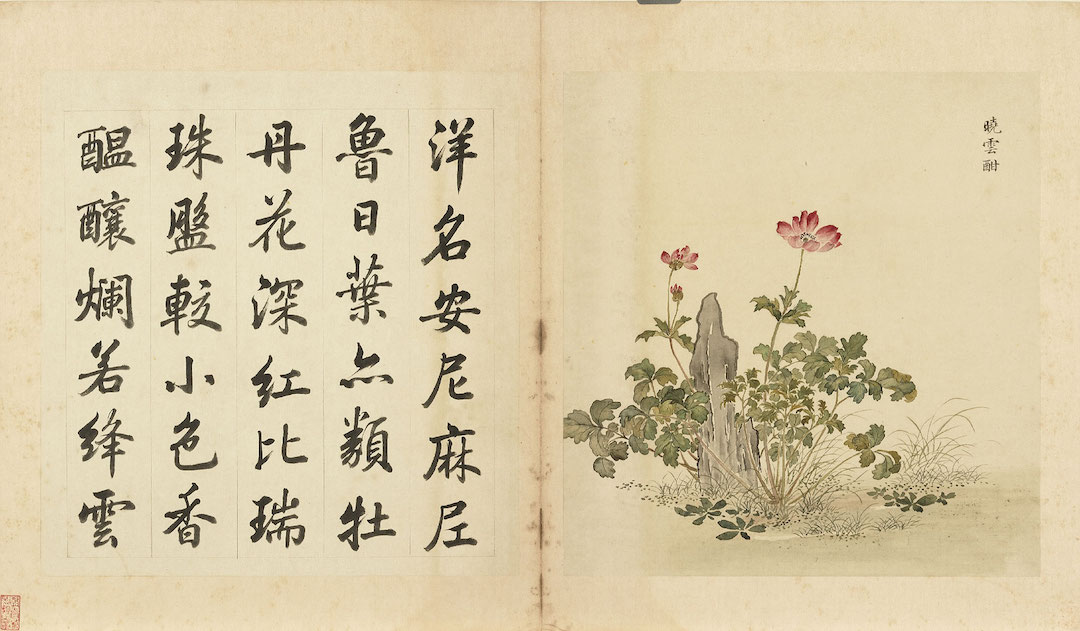
Qingyu Province Paintings of Haixi Flowers on Paper (Part)

Qingyu Province Paintings of Haixi Flowers on Paper (Part)
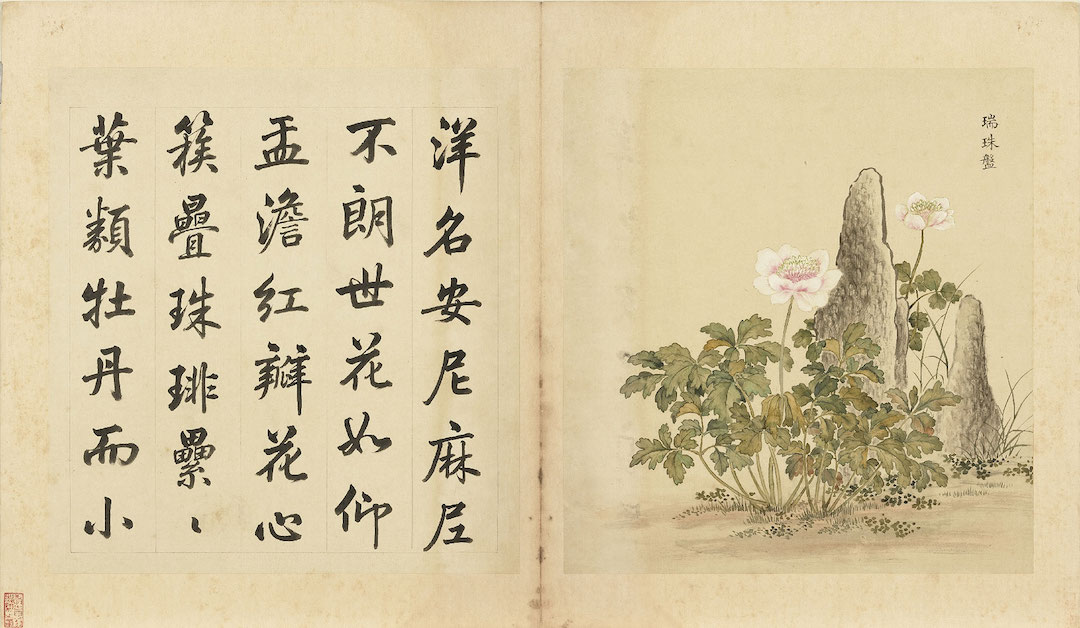
Qingyu Province Paintings of Haixi Flowers on Paper (Part)
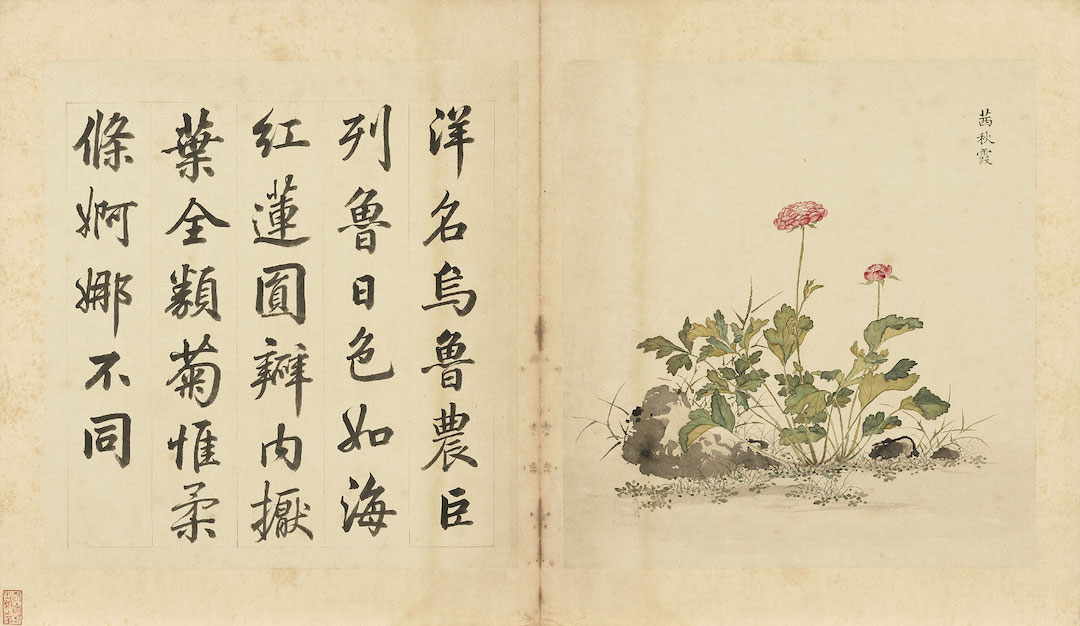
Qingyu Province Paintings of Haixi Flowers on Paper (Part)
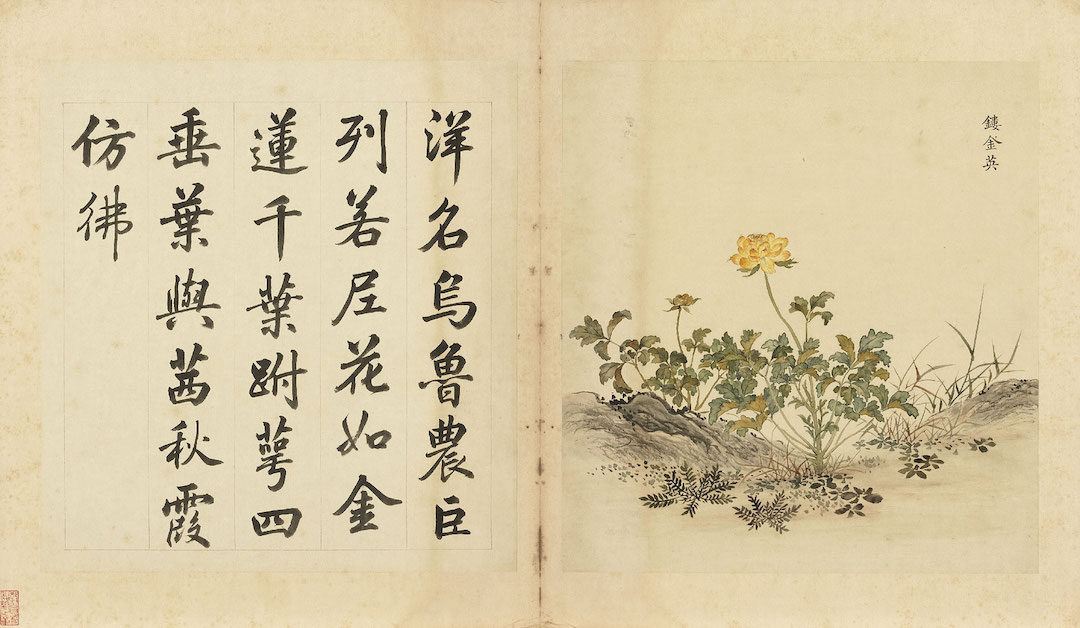
Qingyu Province Paintings of Haixi Flowers on Paper (Part)
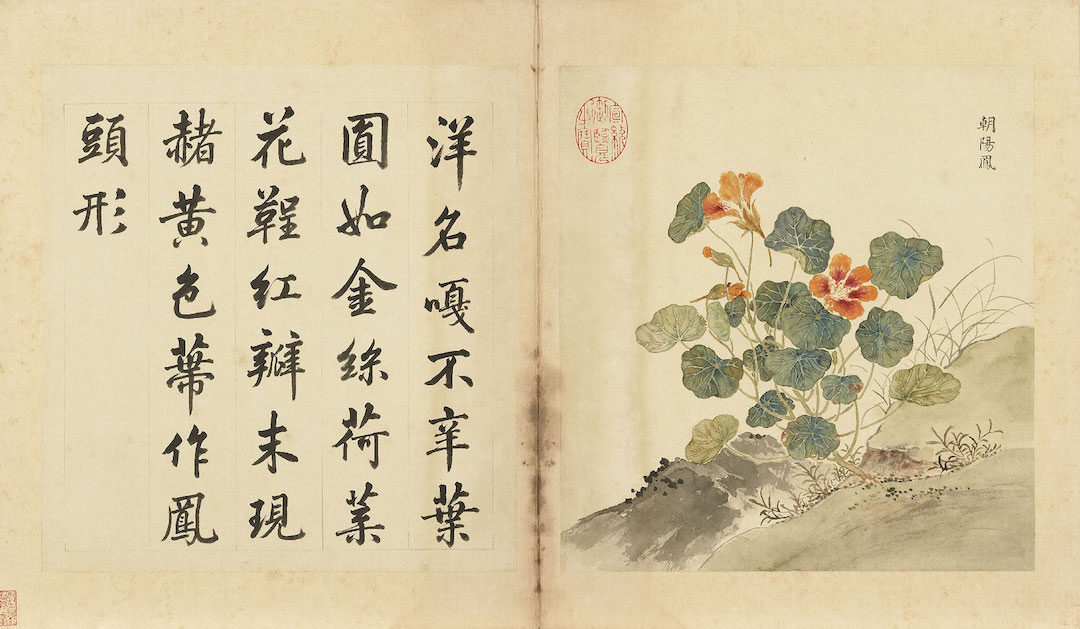
Qingyu Province Paintings of Haixi Flowers on Paper (Part)
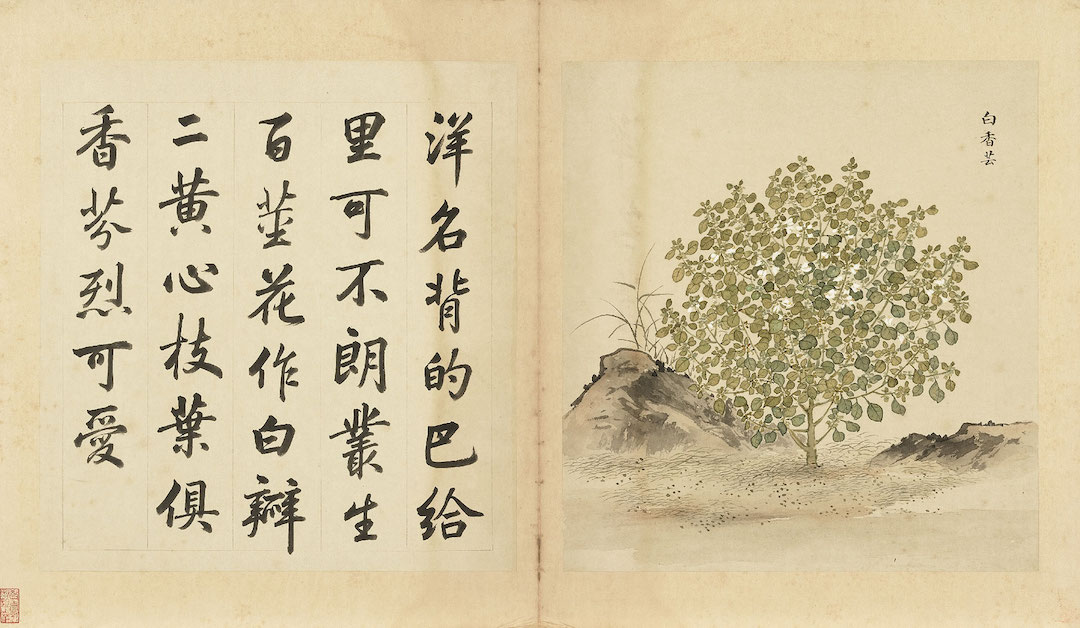
Qingyu Province Paintings of Haixi Flowers on Paper (Part)
"Collection of Flowers in Haixi" was commissioned by court painter Yu Sheng (active in the 18th century) in the 22nd year of Qianlong (1757). It depicts eight common flower varieties in European gardens and was commissioned by cabinet bachelor Yu Minzhong ( 1717-1779) inscribed the Chinese names, Chinese translations of foreign names and characteristics of flowers on the opposite panel. In the brief introduction, the appearance comparison with native flowers is also included, allowing viewers to imagine the appearance of foreign flowers through text and pictures.
These eight kinds of flowers were probably introduced to the palace by the Jesuit missionary Pierre Noël Le Chéron d'Incarville (1706-1757) for the Western-style garden of the Western-style Building in Yuanmingyuan. After Tang Zhizhong passed away, there was no record of seeing these eight kinds of foreign flowers again, and perhaps they did not continue to be cultivated and multiplied in the court. "Haixi Collection of Flowers" may be one of the few pieces of evidence that these foreign flowers were "ephemeral" in China.
(The pictures and texts in this article are compiled from the official website of the National Palace Museum in Taipei)
